Human Resources Management Assignment PDF
VerifiedAdded on 2021/01/21
|35
|10381
|432
AI Summary
HR management strategy helps organisations attain objectives with better planning and strategizing
Organisation culture and values control employee behaviour and ease the achievement of strategic goals
HR management nurtures talent and grooms future leadership to ensure continuity in leadership
EasiClean Plc intends to move into new products and target 15 new countries; seeks to adopt strategic HR management practices for business growth
Report will cover the impact and importance of structure and culture, financial resources for HR management, factors affecting HR management, critical factors and barriers to consider while developing HR strategies, and ways to overcome problems and bottlenecks using suitable approaches with merits and demerits mentioned.
Contribute Materials
Your contribution can guide someone’s learning journey. Share your
documents today.
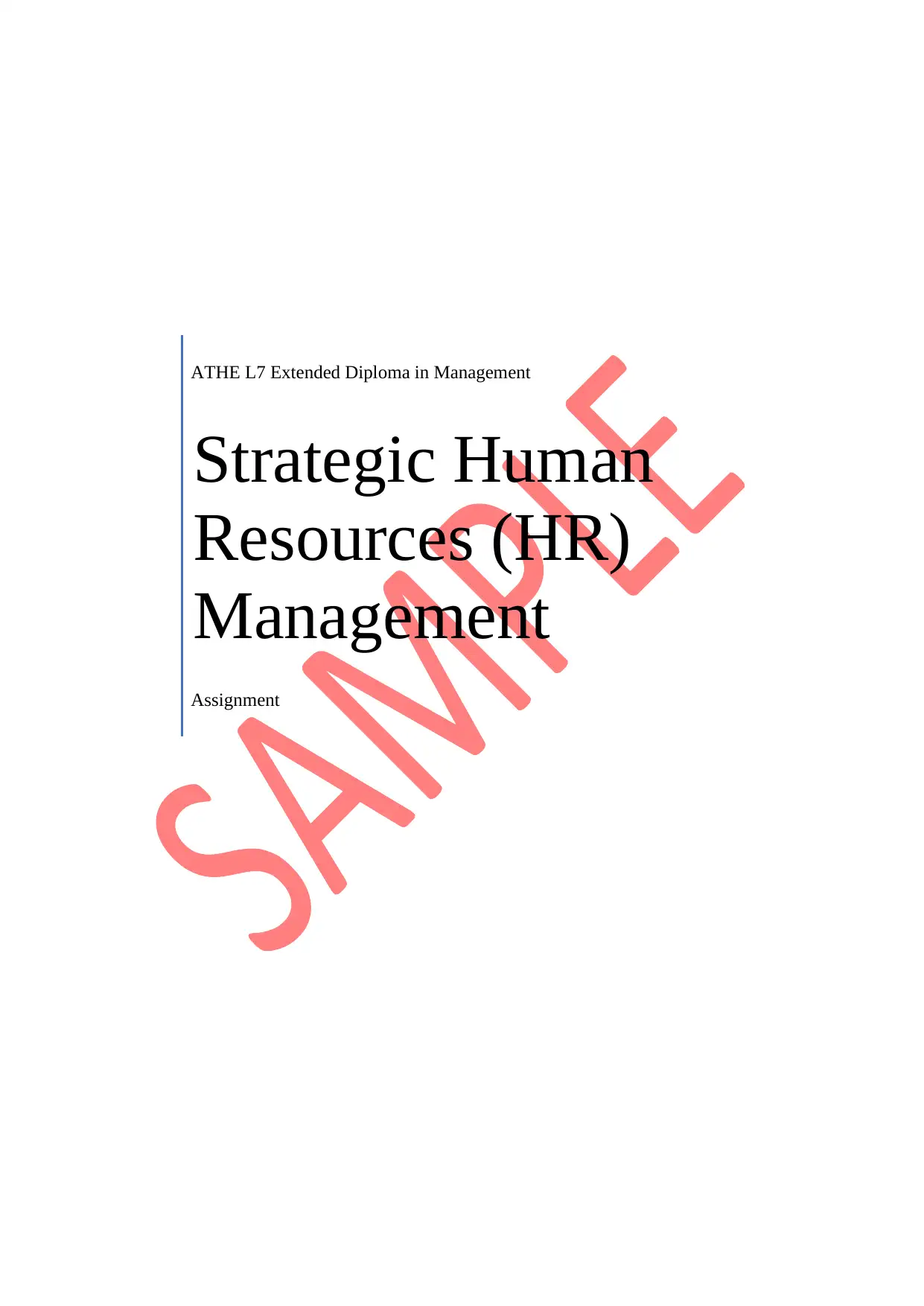
ATHE L7 Extended Diploma in Management
Strategic Human
Resources (HR)
Management
Assignment
Strategic Human
Resources (HR)
Management
Assignment
Secure Best Marks with AI Grader
Need help grading? Try our AI Grader for instant feedback on your assignments.
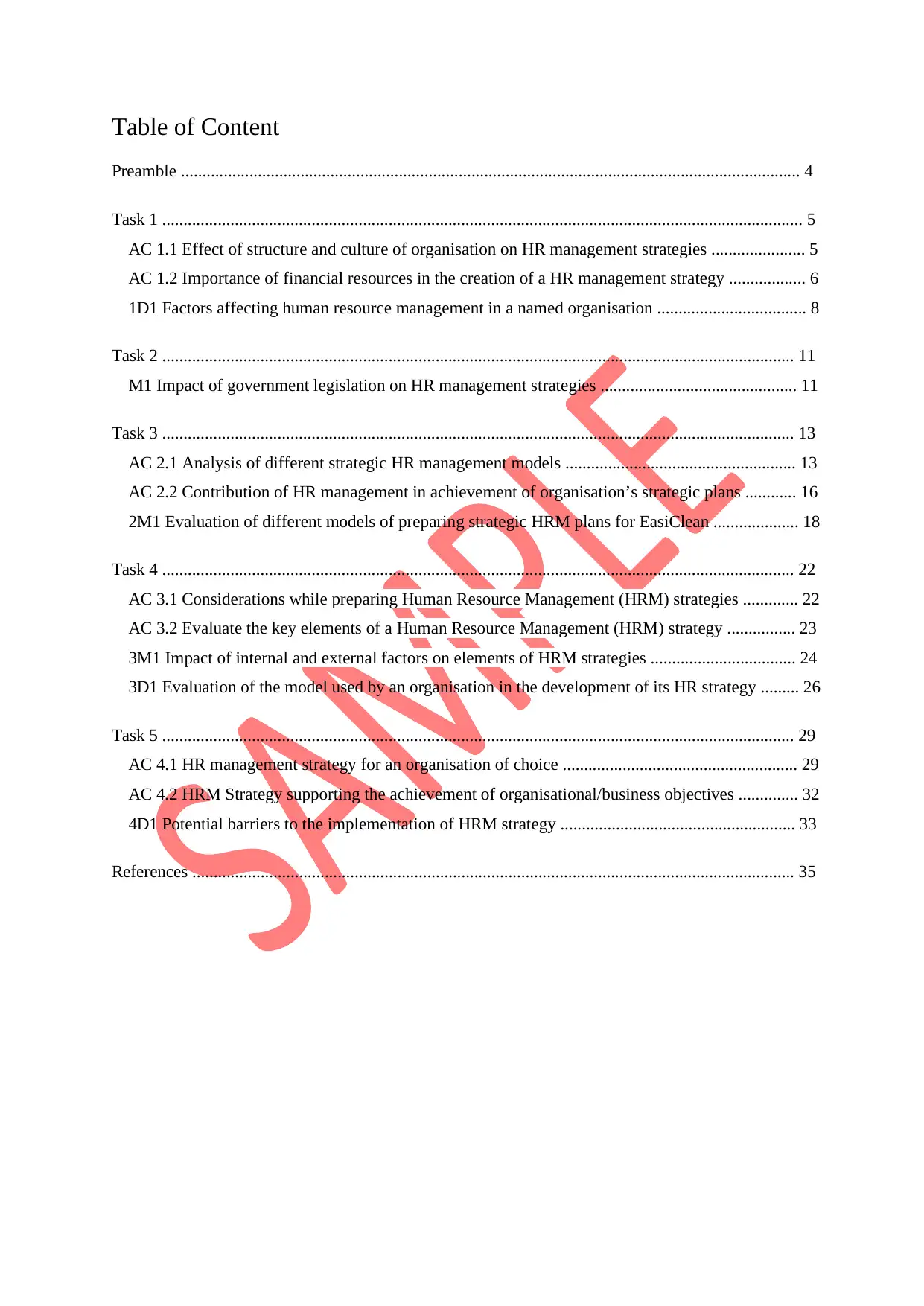
Table of Content
Preamble ................................................................................................................................................. 4
Task 1 ...................................................................................................................................................... 5
AC 1.1 Effect of structure and culture of organisation on HR management strategies ...................... 5
AC 1.2 Importance of financial resources in the creation of a HR management strategy .................. 6
1D1 Factors affecting human resource management in a named organisation ................................... 8
Task 2 .................................................................................................................................................... 11
M1 Impact of government legislation on HR management strategies .............................................. 11
Task 3 .................................................................................................................................................... 13
AC 2.1 Analysis of different strategic HR management models ...................................................... 13
AC 2.2 Contribution of HR management in achievement of organisation’s strategic plans ............ 16
2M1 Evaluation of different models of preparing strategic HRM plans for EasiClean .................... 18
Task 4 .................................................................................................................................................... 22
AC 3.1 Considerations while preparing Human Resource Management (HRM) strategies ............. 22
AC 3.2 Evaluate the key elements of a Human Resource Management (HRM) strategy ................ 23
3M1 Impact of internal and external factors on elements of HRM strategies .................................. 24
3D1 Evaluation of the model used by an organisation in the development of its HR strategy ......... 26
Task 5 .................................................................................................................................................... 29
AC 4.1 HR management strategy for an organisation of choice ....................................................... 29
AC 4.2 HRM Strategy supporting the achievement of organisational/business objectives .............. 32
4D1 Potential barriers to the implementation of HRM strategy ....................................................... 33
References ............................................................................................................................................. 35
Preamble ................................................................................................................................................. 4
Task 1 ...................................................................................................................................................... 5
AC 1.1 Effect of structure and culture of organisation on HR management strategies ...................... 5
AC 1.2 Importance of financial resources in the creation of a HR management strategy .................. 6
1D1 Factors affecting human resource management in a named organisation ................................... 8
Task 2 .................................................................................................................................................... 11
M1 Impact of government legislation on HR management strategies .............................................. 11
Task 3 .................................................................................................................................................... 13
AC 2.1 Analysis of different strategic HR management models ...................................................... 13
AC 2.2 Contribution of HR management in achievement of organisation’s strategic plans ............ 16
2M1 Evaluation of different models of preparing strategic HRM plans for EasiClean .................... 18
Task 4 .................................................................................................................................................... 22
AC 3.1 Considerations while preparing Human Resource Management (HRM) strategies ............. 22
AC 3.2 Evaluate the key elements of a Human Resource Management (HRM) strategy ................ 23
3M1 Impact of internal and external factors on elements of HRM strategies .................................. 24
3D1 Evaluation of the model used by an organisation in the development of its HR strategy ......... 26
Task 5 .................................................................................................................................................... 29
AC 4.1 HR management strategy for an organisation of choice ....................................................... 29
AC 4.2 HRM Strategy supporting the achievement of organisational/business objectives .............. 32
4D1 Potential barriers to the implementation of HRM strategy ....................................................... 33
References ............................................................................................................................................. 35
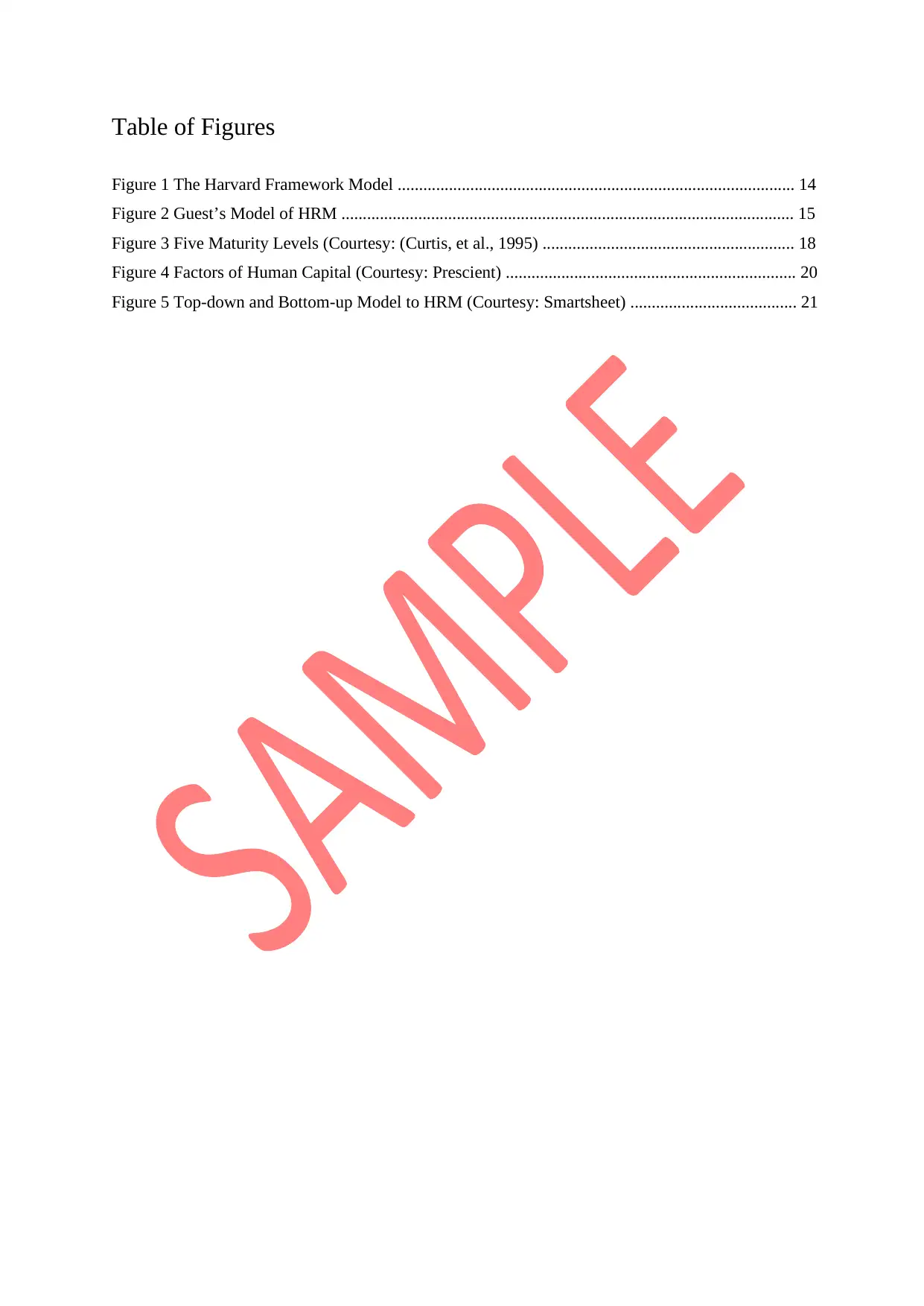
Table of Figures
Figure 1 The Harvard Framework Model ............................................................................................. 14
Figure 2 Guest’s Model of HRM .......................................................................................................... 15
Figure 3 Five Maturity Levels (Courtesy: (Curtis, et al., 1995) ........................................................... 18
Figure 4 Factors of Human Capital (Courtesy: Prescient) .................................................................... 20
Figure 5 Top-down and Bottom-up Model to HRM (Courtesy: Smartsheet) ....................................... 21
Figure 1 The Harvard Framework Model ............................................................................................. 14
Figure 2 Guest’s Model of HRM .......................................................................................................... 15
Figure 3 Five Maturity Levels (Courtesy: (Curtis, et al., 1995) ........................................................... 18
Figure 4 Factors of Human Capital (Courtesy: Prescient) .................................................................... 20
Figure 5 Top-down and Bottom-up Model to HRM (Courtesy: Smartsheet) ....................................... 21
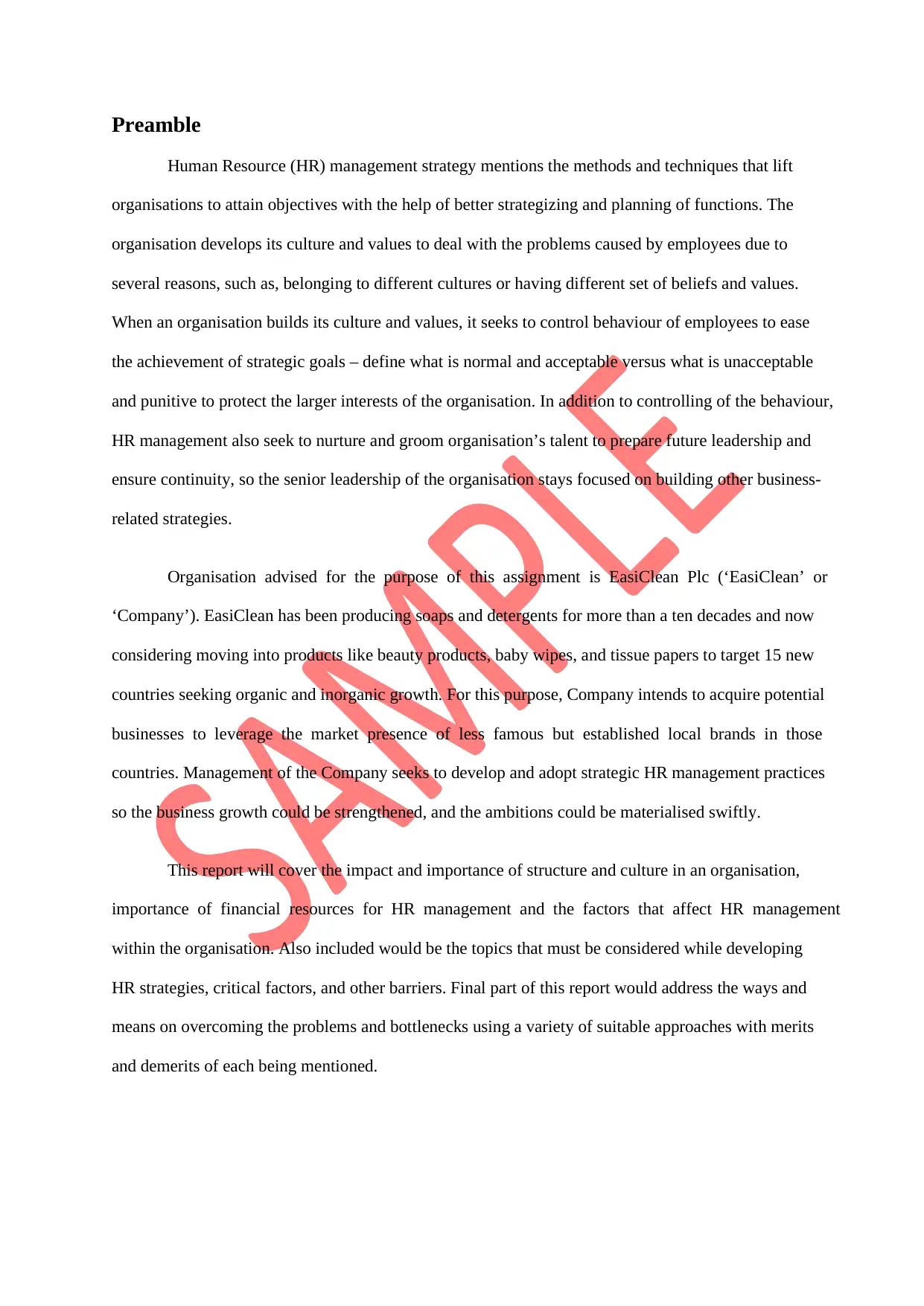
Preamble
Human Resource (HR) management strategy mentions the methods and techniques that lift
organisations to attain objectives with the help of better strategizing and planning of functions. The
organisation develops its culture and values to deal with the problems caused by employees due to
several reasons, such as, belonging to different cultures or having different set of beliefs and values.
When an organisation builds its culture and values, it seeks to control behaviour of employees to ease
the achievement of strategic goals – define what is normal and acceptable versus what is unacceptable
and punitive to protect the larger interests of the organisation. In addition to controlling of the behaviour,
HR management also seek to nurture and groom organisation’s talent to prepare future leadership and
ensure continuity, so the senior leadership of the organisation stays focused on building other business-
related strategies.
Organisation advised for the purpose of this assignment is EasiClean Plc (‘EasiClean’ or
‘Company’). EasiClean has been producing soaps and detergents for more than a ten decades and now
considering moving into products like beauty products, baby wipes, and tissue papers to target 15 new
countries seeking organic and inorganic growth. For this purpose, Company intends to acquire potential
businesses to leverage the market presence of less famous but established local brands in those
countries. Management of the Company seeks to develop and adopt strategic HR management practices
so the business growth could be strengthened, and the ambitions could be materialised swiftly.
This report will cover the impact and importance of structure and culture in an organisation,
importance of financial resources for HR management and the factors that affect HR management
within the organisation. Also included would be the topics that must be considered while developing
HR strategies, critical factors, and other barriers. Final part of this report would address the ways and
means on overcoming the problems and bottlenecks using a variety of suitable approaches with merits
and demerits of each being mentioned.
Human Resource (HR) management strategy mentions the methods and techniques that lift
organisations to attain objectives with the help of better strategizing and planning of functions. The
organisation develops its culture and values to deal with the problems caused by employees due to
several reasons, such as, belonging to different cultures or having different set of beliefs and values.
When an organisation builds its culture and values, it seeks to control behaviour of employees to ease
the achievement of strategic goals – define what is normal and acceptable versus what is unacceptable
and punitive to protect the larger interests of the organisation. In addition to controlling of the behaviour,
HR management also seek to nurture and groom organisation’s talent to prepare future leadership and
ensure continuity, so the senior leadership of the organisation stays focused on building other business-
related strategies.
Organisation advised for the purpose of this assignment is EasiClean Plc (‘EasiClean’ or
‘Company’). EasiClean has been producing soaps and detergents for more than a ten decades and now
considering moving into products like beauty products, baby wipes, and tissue papers to target 15 new
countries seeking organic and inorganic growth. For this purpose, Company intends to acquire potential
businesses to leverage the market presence of less famous but established local brands in those
countries. Management of the Company seeks to develop and adopt strategic HR management practices
so the business growth could be strengthened, and the ambitions could be materialised swiftly.
This report will cover the impact and importance of structure and culture in an organisation,
importance of financial resources for HR management and the factors that affect HR management
within the organisation. Also included would be the topics that must be considered while developing
HR strategies, critical factors, and other barriers. Final part of this report would address the ways and
means on overcoming the problems and bottlenecks using a variety of suitable approaches with merits
and demerits of each being mentioned.
Secure Best Marks with AI Grader
Need help grading? Try our AI Grader for instant feedback on your assignments.
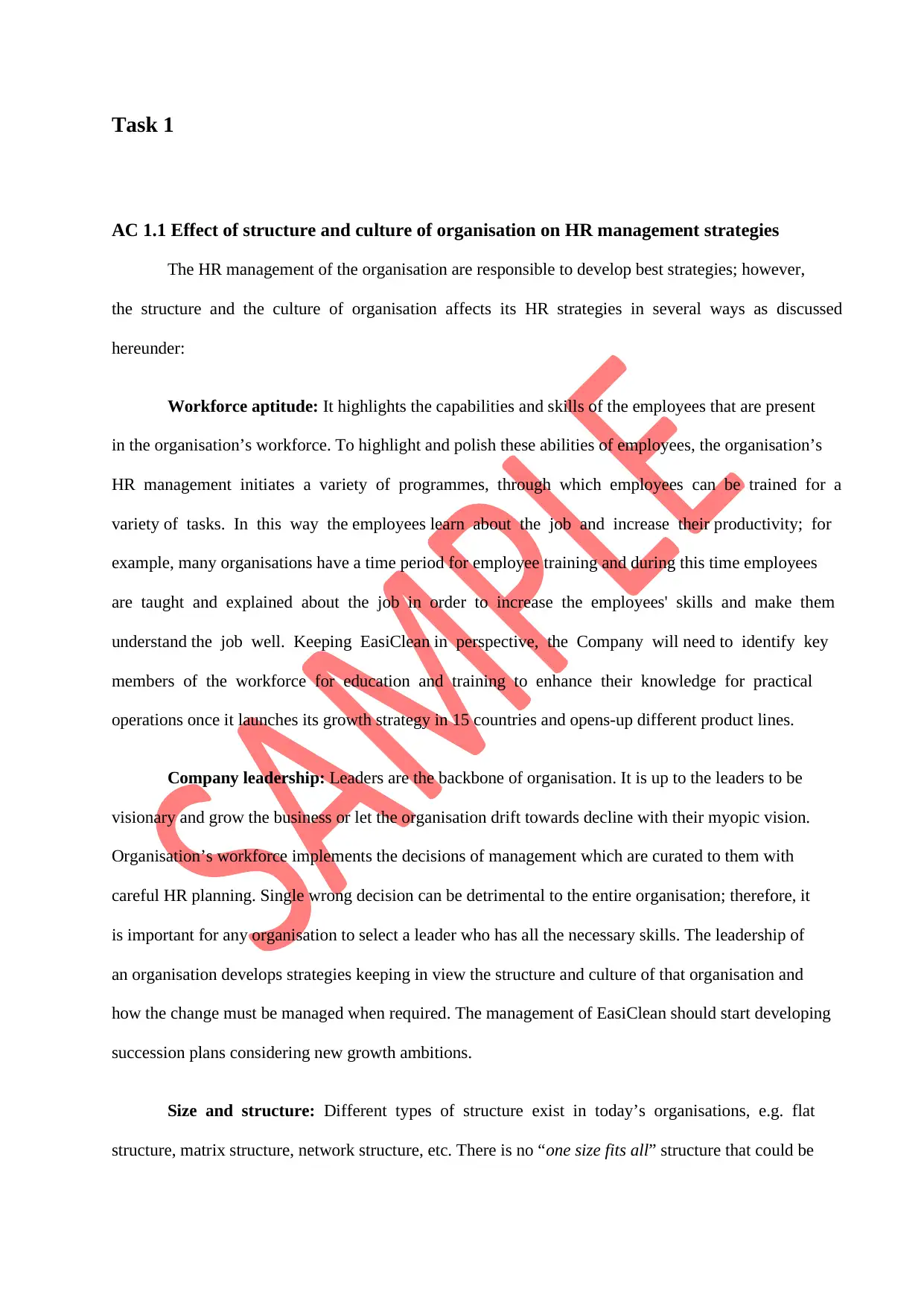
Task 1
AC 1.1 Effect of structure and culture of organisation on HR management strategies
The HR management of the organisation are responsible to develop best strategies; however,
the structure and the culture of organisation affects its HR strategies in several ways as discussed
hereunder:
Workforce aptitude: It highlights the capabilities and skills of the employees that are present
in the organisation’s workforce. To highlight and polish these abilities of employees, the organisation’s
HR management initiates a variety of programmes, through which employees can be trained for a
variety of tasks. In this way the employees learn about the job and increase their productivity; for
example, many organisations have a time period for employee training and during this time employees
are taught and explained about the job in order to increase the employees' skills and make them
understand the job well. Keeping EasiClean in perspective, the Company will need to identify key
members of the workforce for education and training to enhance their knowledge for practical
operations once it launches its growth strategy in 15 countries and opens-up different product lines.
Company leadership: Leaders are the backbone of organisation. It is up to the leaders to be
visionary and grow the business or let the organisation drift towards decline with their myopic vision.
Organisation’s workforce implements the decisions of management which are curated to them with
careful HR planning. Single wrong decision can be detrimental to the entire organisation; therefore, it
is important for any organisation to select a leader who has all the necessary skills. The leadership of
an organisation develops strategies keeping in view the structure and culture of that organisation and
how the change must be managed when required. The management of EasiClean should start developing
succession plans considering new growth ambitions.
Size and structure: Different types of structure exist in today’s organisations, e.g. flat
structure, matrix structure, network structure, etc. There is no “one size fits all” structure that could be
AC 1.1 Effect of structure and culture of organisation on HR management strategies
The HR management of the organisation are responsible to develop best strategies; however,
the structure and the culture of organisation affects its HR strategies in several ways as discussed
hereunder:
Workforce aptitude: It highlights the capabilities and skills of the employees that are present
in the organisation’s workforce. To highlight and polish these abilities of employees, the organisation’s
HR management initiates a variety of programmes, through which employees can be trained for a
variety of tasks. In this way the employees learn about the job and increase their productivity; for
example, many organisations have a time period for employee training and during this time employees
are taught and explained about the job in order to increase the employees' skills and make them
understand the job well. Keeping EasiClean in perspective, the Company will need to identify key
members of the workforce for education and training to enhance their knowledge for practical
operations once it launches its growth strategy in 15 countries and opens-up different product lines.
Company leadership: Leaders are the backbone of organisation. It is up to the leaders to be
visionary and grow the business or let the organisation drift towards decline with their myopic vision.
Organisation’s workforce implements the decisions of management which are curated to them with
careful HR planning. Single wrong decision can be detrimental to the entire organisation; therefore, it
is important for any organisation to select a leader who has all the necessary skills. The leadership of
an organisation develops strategies keeping in view the structure and culture of that organisation and
how the change must be managed when required. The management of EasiClean should start developing
succession plans considering new growth ambitions.
Size and structure: Different types of structure exist in today’s organisations, e.g. flat
structure, matrix structure, network structure, etc. There is no “one size fits all” structure that could be
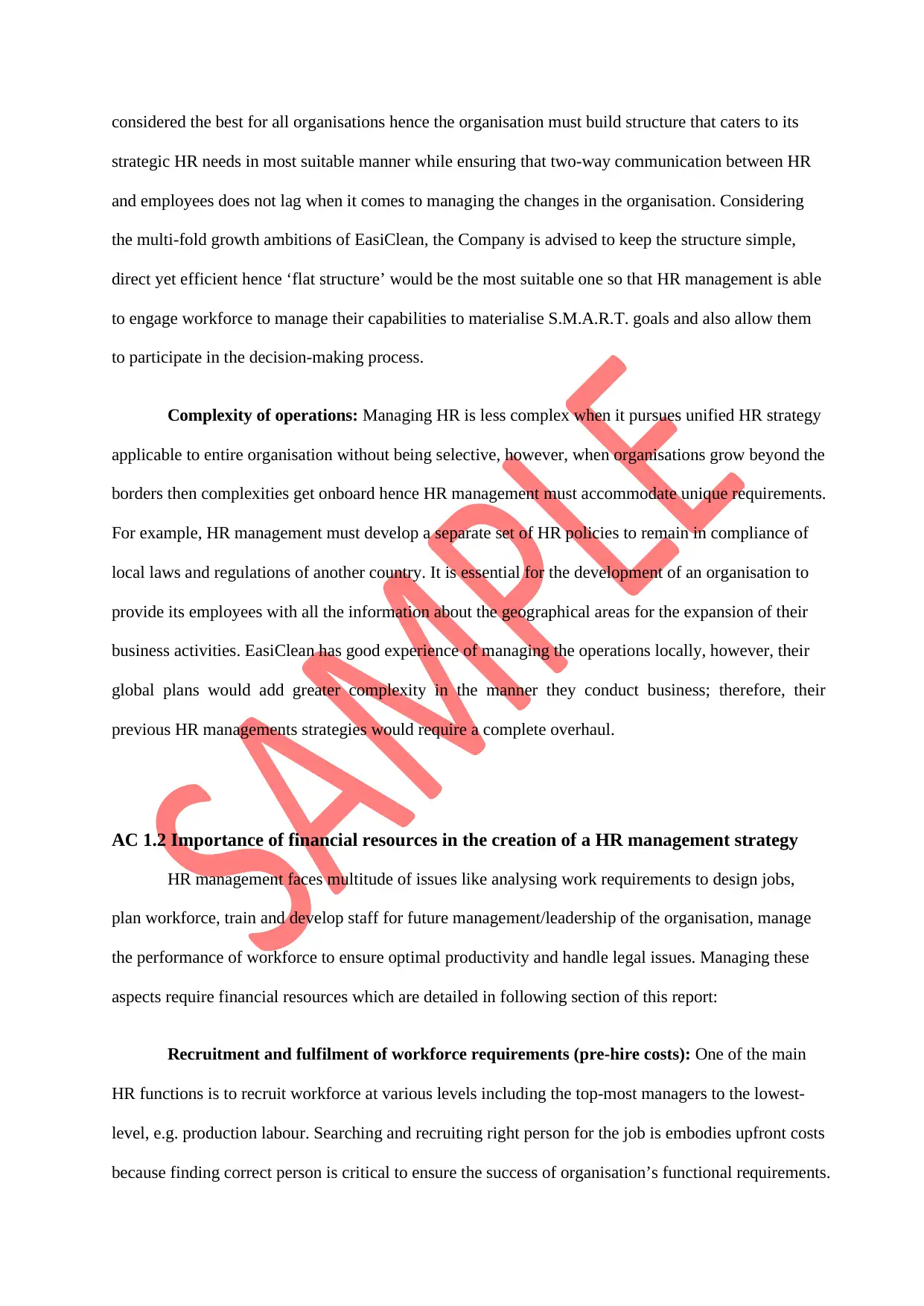
considered the best for all organisations hence the organisation must build structure that caters to its
strategic HR needs in most suitable manner while ensuring that two-way communication between HR
and employees does not lag when it comes to managing the changes in the organisation. Considering
the multi-fold growth ambitions of EasiClean, the Company is advised to keep the structure simple,
direct yet efficient hence ‘flat structure’ would be the most suitable one so that HR management is able
to engage workforce to manage their capabilities to materialise S.M.A.R.T. goals and also allow them
to participate in the decision-making process.
Complexity of operations: Managing HR is less complex when it pursues unified HR strategy
applicable to entire organisation without being selective, however, when organisations grow beyond the
borders then complexities get onboard hence HR management must accommodate unique requirements.
For example, HR management must develop a separate set of HR policies to remain in compliance of
local laws and regulations of another country. It is essential for the development of an organisation to
provide its employees with all the information about the geographical areas for the expansion of their
business activities. EasiClean has good experience of managing the operations locally, however, their
global plans would add greater complexity in the manner they conduct business; therefore, their
previous HR managements strategies would require a complete overhaul.
AC 1.2 Importance of financial resources in the creation of a HR management strategy
HR management faces multitude of issues like analysing work requirements to design jobs,
plan workforce, train and develop staff for future management/leadership of the organisation, manage
the performance of workforce to ensure optimal productivity and handle legal issues. Managing these
aspects require financial resources which are detailed in following section of this report:
Recruitment and fulfilment of workforce requirements (pre-hire costs): One of the main
HR functions is to recruit workforce at various levels including the top-most managers to the lowest-
level, e.g. production labour. Searching and recruiting right person for the job is embodies upfront costs
because finding correct person is critical to ensure the success of organisation’s functional requirements.
strategic HR needs in most suitable manner while ensuring that two-way communication between HR
and employees does not lag when it comes to managing the changes in the organisation. Considering
the multi-fold growth ambitions of EasiClean, the Company is advised to keep the structure simple,
direct yet efficient hence ‘flat structure’ would be the most suitable one so that HR management is able
to engage workforce to manage their capabilities to materialise S.M.A.R.T. goals and also allow them
to participate in the decision-making process.
Complexity of operations: Managing HR is less complex when it pursues unified HR strategy
applicable to entire organisation without being selective, however, when organisations grow beyond the
borders then complexities get onboard hence HR management must accommodate unique requirements.
For example, HR management must develop a separate set of HR policies to remain in compliance of
local laws and regulations of another country. It is essential for the development of an organisation to
provide its employees with all the information about the geographical areas for the expansion of their
business activities. EasiClean has good experience of managing the operations locally, however, their
global plans would add greater complexity in the manner they conduct business; therefore, their
previous HR managements strategies would require a complete overhaul.
AC 1.2 Importance of financial resources in the creation of a HR management strategy
HR management faces multitude of issues like analysing work requirements to design jobs,
plan workforce, train and develop staff for future management/leadership of the organisation, manage
the performance of workforce to ensure optimal productivity and handle legal issues. Managing these
aspects require financial resources which are detailed in following section of this report:
Recruitment and fulfilment of workforce requirements (pre-hire costs): One of the main
HR functions is to recruit workforce at various levels including the top-most managers to the lowest-
level, e.g. production labour. Searching and recruiting right person for the job is embodies upfront costs
because finding correct person is critical to ensure the success of organisation’s functional requirements.
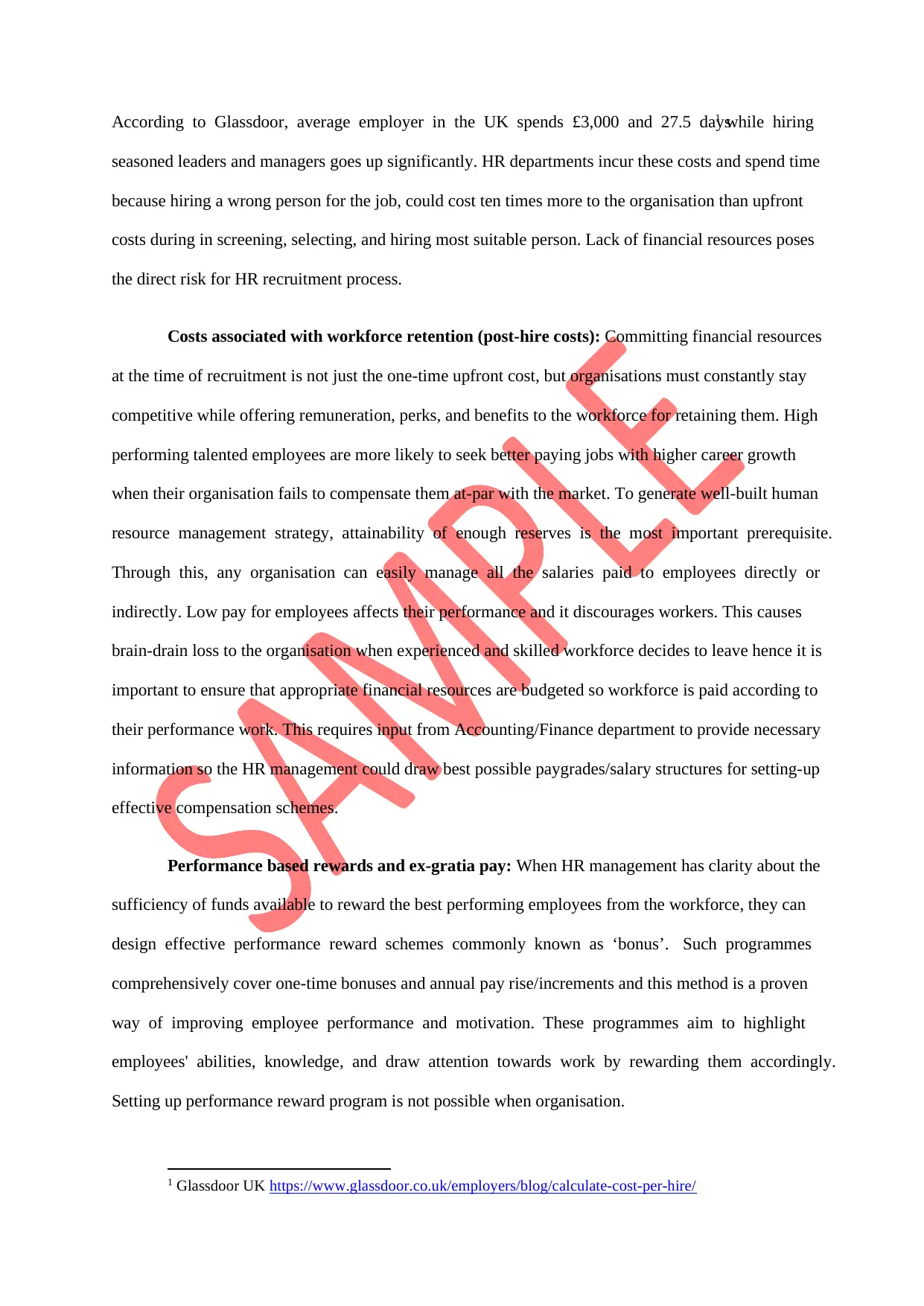
According to Glassdoor, average employer in the UK spends £3,000 and 27.5 days1 while hiring
seasoned leaders and managers goes up significantly. HR departments incur these costs and spend time
because hiring a wrong person for the job, could cost ten times more to the organisation than upfront
costs during in screening, selecting, and hiring most suitable person. Lack of financial resources poses
the direct risk for HR recruitment process.
Costs associated with workforce retention (post-hire costs): Committing financial resources
at the time of recruitment is not just the one-time upfront cost, but organisations must constantly stay
competitive while offering remuneration, perks, and benefits to the workforce for retaining them. High
performing talented employees are more likely to seek better paying jobs with higher career growth
when their organisation fails to compensate them at-par with the market. To generate well-built human
resource management strategy, attainability of enough reserves is the most important prerequisite.
Through this, any organisation can easily manage all the salaries paid to employees directly or
indirectly. Low pay for employees affects their performance and it discourages workers. This causes
brain-drain loss to the organisation when experienced and skilled workforce decides to leave hence it is
important to ensure that appropriate financial resources are budgeted so workforce is paid according to
their performance work. This requires input from Accounting/Finance department to provide necessary
information so the HR management could draw best possible paygrades/salary structures for setting-up
effective compensation schemes.
Performance based rewards and ex-gratia pay: When HR management has clarity about the
sufficiency of funds available to reward the best performing employees from the workforce, they can
design effective performance reward schemes commonly known as ‘bonus’. Such programmes
comprehensively cover one-time bonuses and annual pay rise/increments and this method is a proven
way of improving employee performance and motivation. These programmes aim to highlight
employees' abilities, knowledge, and draw attention towards work by rewarding them accordingly.
Setting up performance reward program is not possible when organisation.
1 Glassdoor UK https://www.glassdoor.co.uk/employers/blog/calculate-cost-per-hire/
seasoned leaders and managers goes up significantly. HR departments incur these costs and spend time
because hiring a wrong person for the job, could cost ten times more to the organisation than upfront
costs during in screening, selecting, and hiring most suitable person. Lack of financial resources poses
the direct risk for HR recruitment process.
Costs associated with workforce retention (post-hire costs): Committing financial resources
at the time of recruitment is not just the one-time upfront cost, but organisations must constantly stay
competitive while offering remuneration, perks, and benefits to the workforce for retaining them. High
performing talented employees are more likely to seek better paying jobs with higher career growth
when their organisation fails to compensate them at-par with the market. To generate well-built human
resource management strategy, attainability of enough reserves is the most important prerequisite.
Through this, any organisation can easily manage all the salaries paid to employees directly or
indirectly. Low pay for employees affects their performance and it discourages workers. This causes
brain-drain loss to the organisation when experienced and skilled workforce decides to leave hence it is
important to ensure that appropriate financial resources are budgeted so workforce is paid according to
their performance work. This requires input from Accounting/Finance department to provide necessary
information so the HR management could draw best possible paygrades/salary structures for setting-up
effective compensation schemes.
Performance based rewards and ex-gratia pay: When HR management has clarity about the
sufficiency of funds available to reward the best performing employees from the workforce, they can
design effective performance reward schemes commonly known as ‘bonus’. Such programmes
comprehensively cover one-time bonuses and annual pay rise/increments and this method is a proven
way of improving employee performance and motivation. These programmes aim to highlight
employees' abilities, knowledge, and draw attention towards work by rewarding them accordingly.
Setting up performance reward program is not possible when organisation.
1 Glassdoor UK https://www.glassdoor.co.uk/employers/blog/calculate-cost-per-hire/
Paraphrase This Document
Need a fresh take? Get an instant paraphrase of this document with our AI Paraphraser
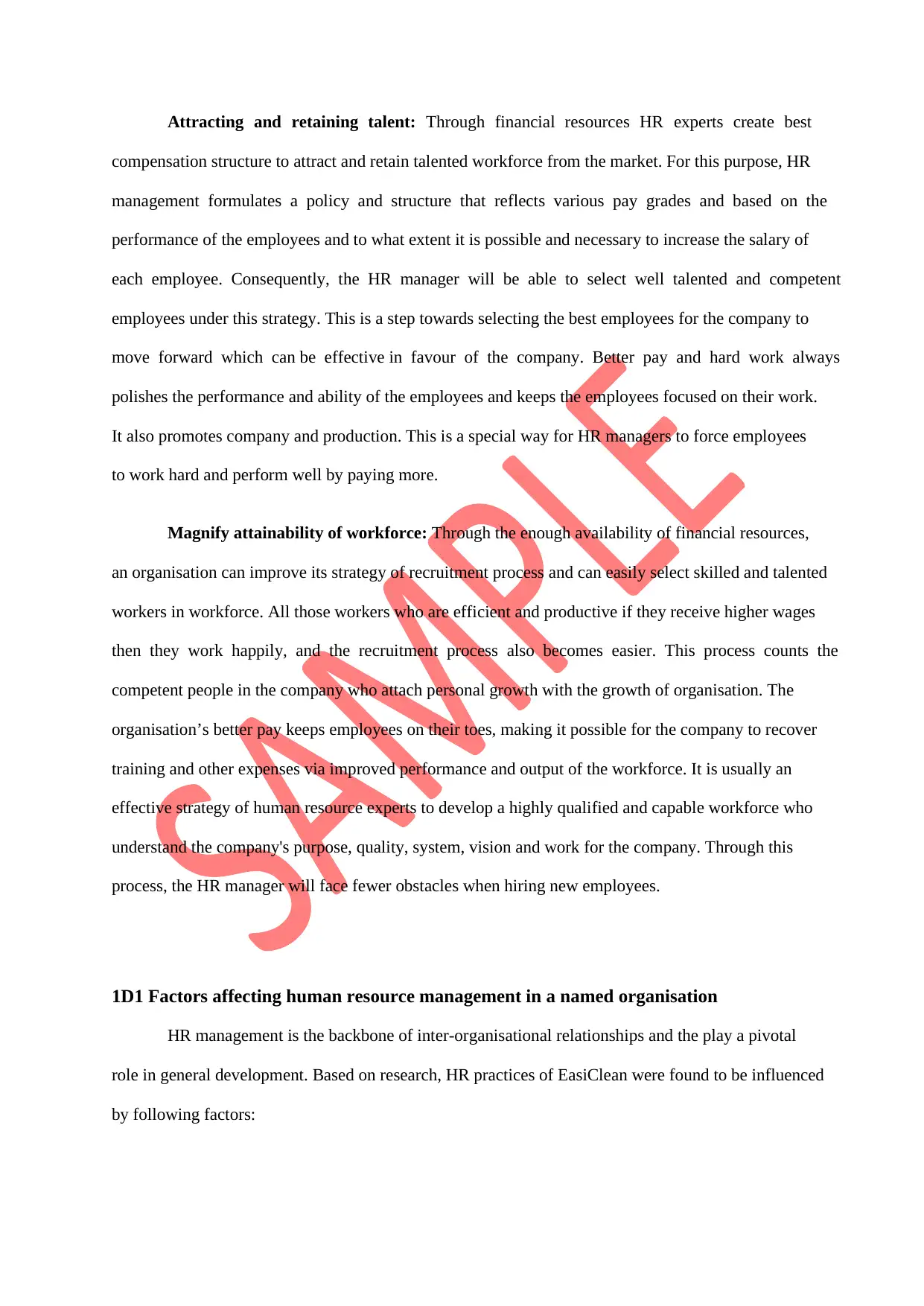
Attracting and retaining talent: Through financial resources HR experts create best
compensation structure to attract and retain talented workforce from the market. For this purpose, HR
management formulates a policy and structure that reflects various pay grades and based on the
performance of the employees and to what extent it is possible and necessary to increase the salary of
each employee. Consequently, the HR manager will be able to select well talented and competent
employees under this strategy. This is a step towards selecting the best employees for the company to
move forward which can be effective in favour of the company. Better pay and hard work always
polishes the performance and ability of the employees and keeps the employees focused on their work.
It also promotes company and production. This is a special way for HR managers to force employees
to work hard and perform well by paying more.
Magnify attainability of workforce: Through the enough availability of financial resources,
an organisation can improve its strategy of recruitment process and can easily select skilled and talented
workers in workforce. All those workers who are efficient and productive if they receive higher wages
then they work happily, and the recruitment process also becomes easier. This process counts the
competent people in the company who attach personal growth with the growth of organisation. The
organisation’s better pay keeps employees on their toes, making it possible for the company to recover
training and other expenses via improved performance and output of the workforce. It is usually an
effective strategy of human resource experts to develop a highly qualified and capable workforce who
understand the company's purpose, quality, system, vision and work for the company. Through this
process, the HR manager will face fewer obstacles when hiring new employees.
1D1 Factors affecting human resource management in a named organisation
HR management is the backbone of inter-organisational relationships and the play a pivotal
role in general development. Based on research, HR practices of EasiClean were found to be influenced
by following factors:
compensation structure to attract and retain talented workforce from the market. For this purpose, HR
management formulates a policy and structure that reflects various pay grades and based on the
performance of the employees and to what extent it is possible and necessary to increase the salary of
each employee. Consequently, the HR manager will be able to select well talented and competent
employees under this strategy. This is a step towards selecting the best employees for the company to
move forward which can be effective in favour of the company. Better pay and hard work always
polishes the performance and ability of the employees and keeps the employees focused on their work.
It also promotes company and production. This is a special way for HR managers to force employees
to work hard and perform well by paying more.
Magnify attainability of workforce: Through the enough availability of financial resources,
an organisation can improve its strategy of recruitment process and can easily select skilled and talented
workers in workforce. All those workers who are efficient and productive if they receive higher wages
then they work happily, and the recruitment process also becomes easier. This process counts the
competent people in the company who attach personal growth with the growth of organisation. The
organisation’s better pay keeps employees on their toes, making it possible for the company to recover
training and other expenses via improved performance and output of the workforce. It is usually an
effective strategy of human resource experts to develop a highly qualified and capable workforce who
understand the company's purpose, quality, system, vision and work for the company. Through this
process, the HR manager will face fewer obstacles when hiring new employees.
1D1 Factors affecting human resource management in a named organisation
HR management is the backbone of inter-organisational relationships and the play a pivotal
role in general development. Based on research, HR practices of EasiClean were found to be influenced
by following factors:
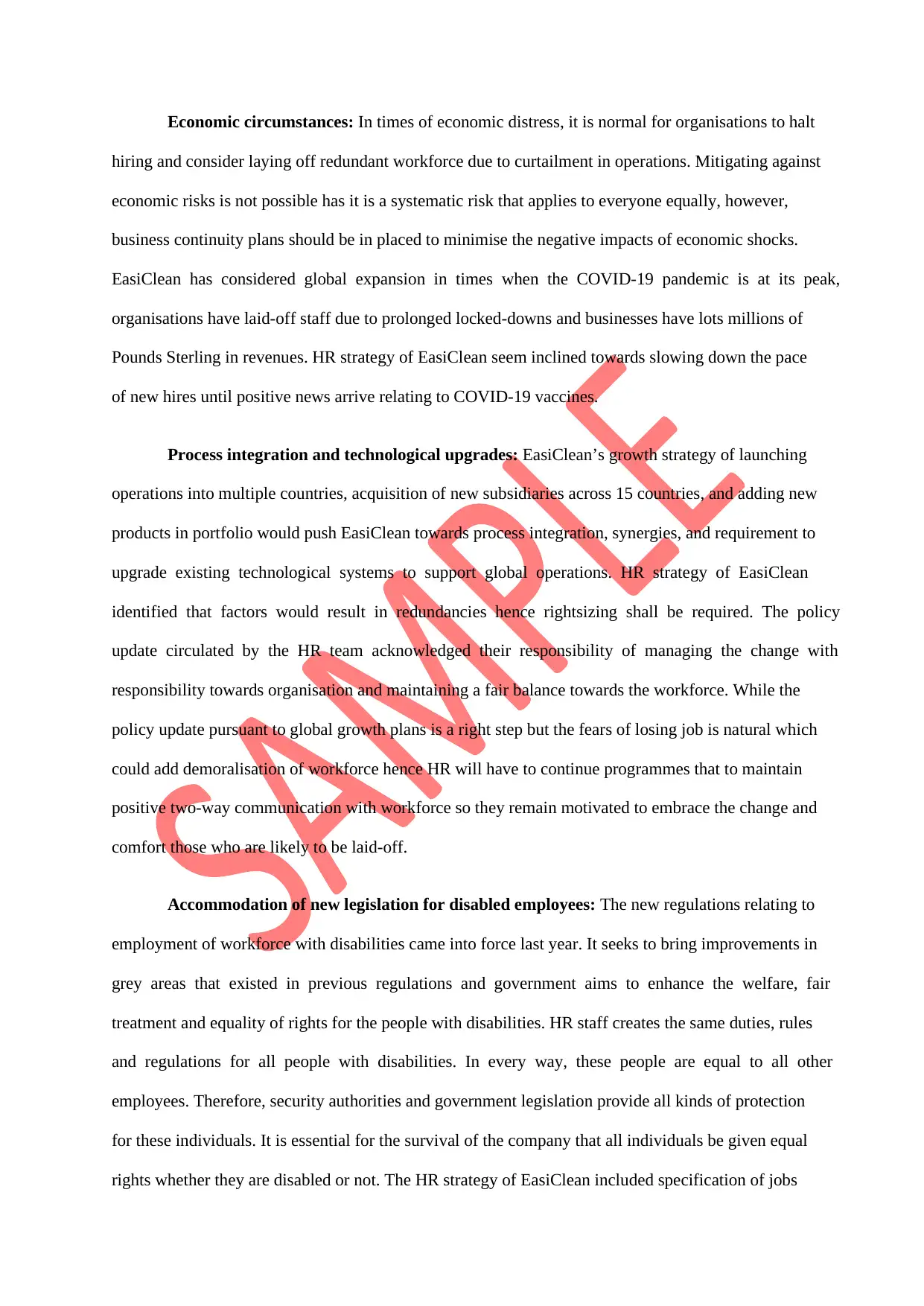
Economic circumstances: In times of economic distress, it is normal for organisations to halt
hiring and consider laying off redundant workforce due to curtailment in operations. Mitigating against
economic risks is not possible has it is a systematic risk that applies to everyone equally, however,
business continuity plans should be in placed to minimise the negative impacts of economic shocks.
EasiClean has considered global expansion in times when the COVID-19 pandemic is at its peak,
organisations have laid-off staff due to prolonged locked-downs and businesses have lots millions of
Pounds Sterling in revenues. HR strategy of EasiClean seem inclined towards slowing down the pace
of new hires until positive news arrive relating to COVID-19 vaccines.
Process integration and technological upgrades: EasiClean’s growth strategy of launching
operations into multiple countries, acquisition of new subsidiaries across 15 countries, and adding new
products in portfolio would push EasiClean towards process integration, synergies, and requirement to
upgrade existing technological systems to support global operations. HR strategy of EasiClean
identified that factors would result in redundancies hence rightsizing shall be required. The policy
update circulated by the HR team acknowledged their responsibility of managing the change with
responsibility towards organisation and maintaining a fair balance towards the workforce. While the
policy update pursuant to global growth plans is a right step but the fears of losing job is natural which
could add demoralisation of workforce hence HR will have to continue programmes that to maintain
positive two-way communication with workforce so they remain motivated to embrace the change and
comfort those who are likely to be laid-off.
Accommodation of new legislation for disabled employees: The new regulations relating to
employment of workforce with disabilities came into force last year. It seeks to bring improvements in
grey areas that existed in previous regulations and government aims to enhance the welfare, fair
treatment and equality of rights for the people with disabilities. HR staff creates the same duties, rules
and regulations for all people with disabilities. In every way, these people are equal to all other
employees. Therefore, security authorities and government legislation provide all kinds of protection
for these individuals. It is essential for the survival of the company that all individuals be given equal
rights whether they are disabled or not. The HR strategy of EasiClean included specification of jobs
hiring and consider laying off redundant workforce due to curtailment in operations. Mitigating against
economic risks is not possible has it is a systematic risk that applies to everyone equally, however,
business continuity plans should be in placed to minimise the negative impacts of economic shocks.
EasiClean has considered global expansion in times when the COVID-19 pandemic is at its peak,
organisations have laid-off staff due to prolonged locked-downs and businesses have lots millions of
Pounds Sterling in revenues. HR strategy of EasiClean seem inclined towards slowing down the pace
of new hires until positive news arrive relating to COVID-19 vaccines.
Process integration and technological upgrades: EasiClean’s growth strategy of launching
operations into multiple countries, acquisition of new subsidiaries across 15 countries, and adding new
products in portfolio would push EasiClean towards process integration, synergies, and requirement to
upgrade existing technological systems to support global operations. HR strategy of EasiClean
identified that factors would result in redundancies hence rightsizing shall be required. The policy
update circulated by the HR team acknowledged their responsibility of managing the change with
responsibility towards organisation and maintaining a fair balance towards the workforce. While the
policy update pursuant to global growth plans is a right step but the fears of losing job is natural which
could add demoralisation of workforce hence HR will have to continue programmes that to maintain
positive two-way communication with workforce so they remain motivated to embrace the change and
comfort those who are likely to be laid-off.
Accommodation of new legislation for disabled employees: The new regulations relating to
employment of workforce with disabilities came into force last year. It seeks to bring improvements in
grey areas that existed in previous regulations and government aims to enhance the welfare, fair
treatment and equality of rights for the people with disabilities. HR staff creates the same duties, rules
and regulations for all people with disabilities. In every way, these people are equal to all other
employees. Therefore, security authorities and government legislation provide all kinds of protection
for these individuals. It is essential for the survival of the company that all individuals be given equal
rights whether they are disabled or not. The HR strategy of EasiClean included specification of jobs
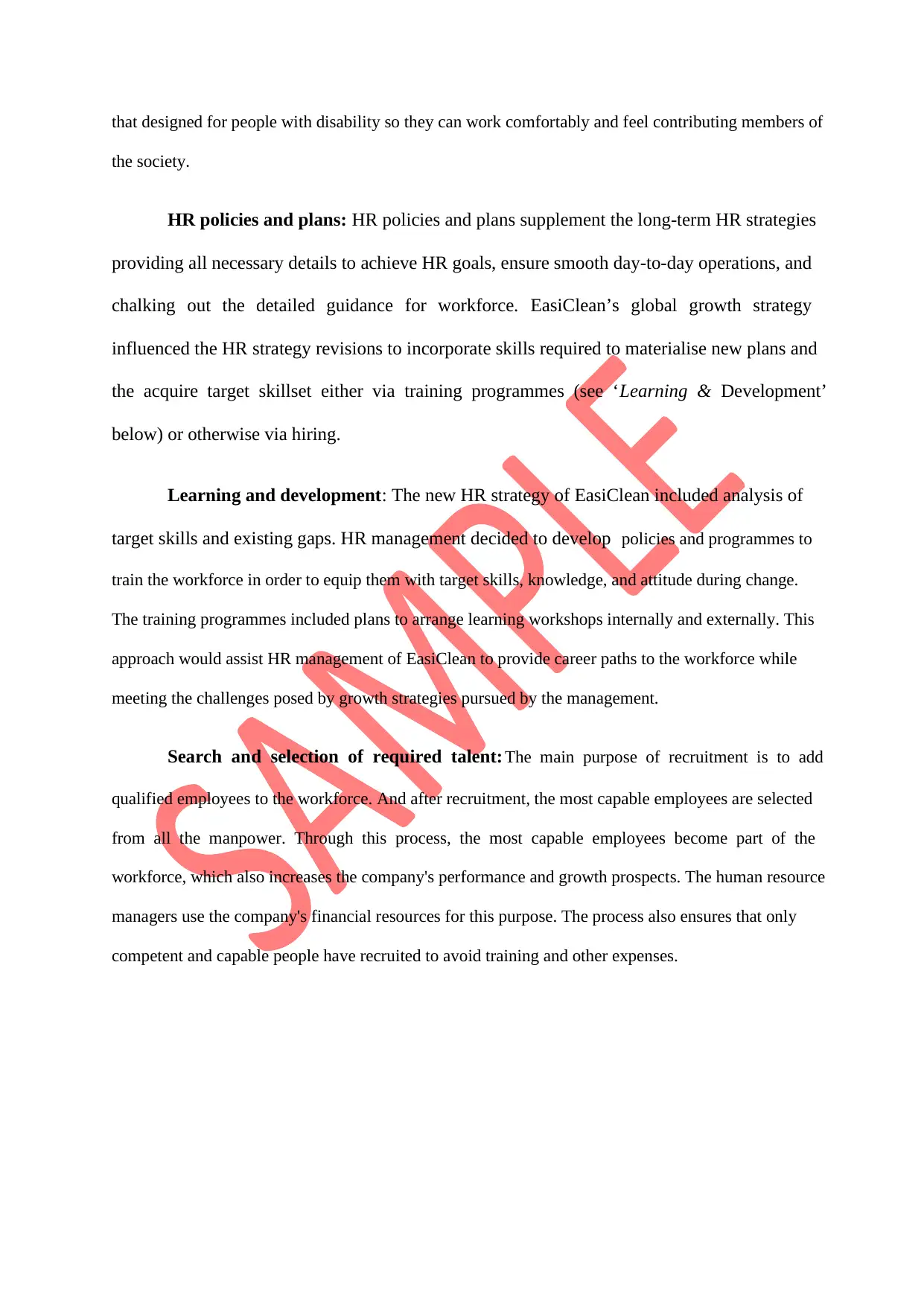
that designed for people with disability so they can work comfortably and feel contributing members of
the society.
HR policies and plans: HR policies and plans supplement the long-term HR strategies
providing all necessary details to achieve HR goals, ensure smooth day-to-day operations, and
chalking out the detailed guidance for workforce. EasiClean’s global growth strategy
influenced the HR strategy revisions to incorporate skills required to materialise new plans and
the acquire target skillset either via training programmes (see ‘Learning & Development’
below) or otherwise via hiring.
Learning and development: The new HR strategy of EasiClean included analysis of
target skills and existing gaps. HR management decided to develop policies and programmes to
train the workforce in order to equip them with target skills, knowledge, and attitude during change.
The training programmes included plans to arrange learning workshops internally and externally. This
approach would assist HR management of EasiClean to provide career paths to the workforce while
meeting the challenges posed by growth strategies pursued by the management.
Search and selection of required talent: The main purpose of recruitment is to add
qualified employees to the workforce. And after recruitment, the most capable employees are selected
from all the manpower. Through this process, the most capable employees become part of the
workforce, which also increases the company's performance and growth prospects. The human resource
managers use the company's financial resources for this purpose. The process also ensures that only
competent and capable people have recruited to avoid training and other expenses.
the society.
HR policies and plans: HR policies and plans supplement the long-term HR strategies
providing all necessary details to achieve HR goals, ensure smooth day-to-day operations, and
chalking out the detailed guidance for workforce. EasiClean’s global growth strategy
influenced the HR strategy revisions to incorporate skills required to materialise new plans and
the acquire target skillset either via training programmes (see ‘Learning & Development’
below) or otherwise via hiring.
Learning and development: The new HR strategy of EasiClean included analysis of
target skills and existing gaps. HR management decided to develop policies and programmes to
train the workforce in order to equip them with target skills, knowledge, and attitude during change.
The training programmes included plans to arrange learning workshops internally and externally. This
approach would assist HR management of EasiClean to provide career paths to the workforce while
meeting the challenges posed by growth strategies pursued by the management.
Search and selection of required talent: The main purpose of recruitment is to add
qualified employees to the workforce. And after recruitment, the most capable employees are selected
from all the manpower. Through this process, the most capable employees become part of the
workforce, which also increases the company's performance and growth prospects. The human resource
managers use the company's financial resources for this purpose. The process also ensures that only
competent and capable people have recruited to avoid training and other expenses.
Secure Best Marks with AI Grader
Need help grading? Try our AI Grader for instant feedback on your assignments.
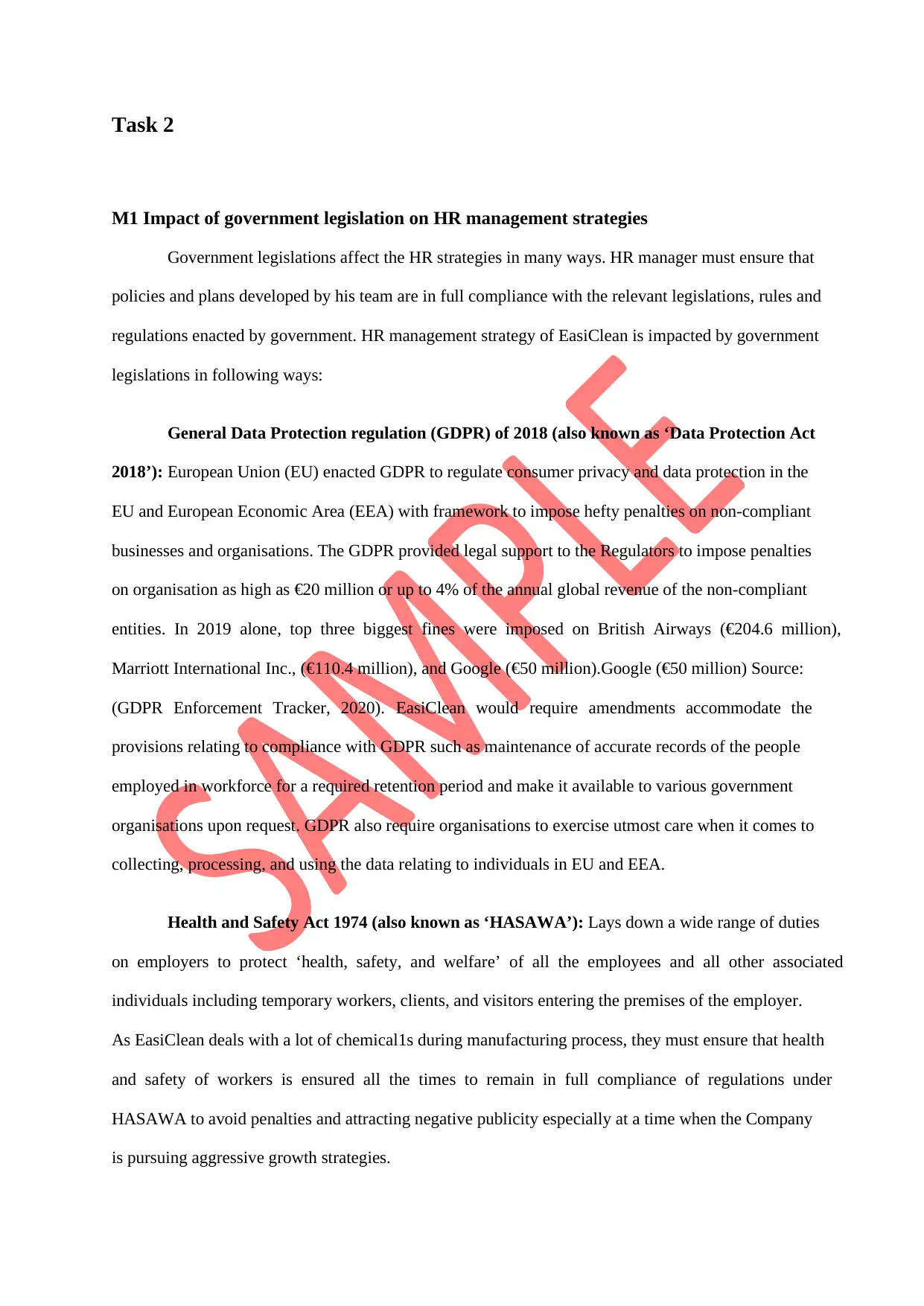
Task 2
M1 Impact of government legislation on HR management strategies
Government legislations affect the HR strategies in many ways. HR manager must ensure that
policies and plans developed by his team are in full compliance with the relevant legislations, rules and
regulations enacted by government. HR management strategy of EasiClean is impacted by government
legislations in following ways:
General Data Protection regulation (GDPR) of 2018 (also known as ‘Data Protection Act
2018’): European Union (EU) enacted GDPR to regulate consumer privacy and data protection in the
EU and European Economic Area (EEA) with framework to impose hefty penalties on non-compliant
businesses and organisations. The GDPR provided legal support to the Regulators to impose penalties
on organisation as high as €20 million or up to 4% of the annual global revenue of the non-compliant
entities. In 2019 alone, top three biggest fines were imposed on British Airways (€204.6 million),
Marriott International Inc., (€110.4 million), and Google (€50 million).Google (€50 million) Source:
(GDPR Enforcement Tracker, 2020). EasiClean would require amendments accommodate the
provisions relating to compliance with GDPR such as maintenance of accurate records of the people
employed in workforce for a required retention period and make it available to various government
organisations upon request. GDPR also require organisations to exercise utmost care when it comes to
collecting, processing, and using the data relating to individuals in EU and EEA.
Health and Safety Act 1974 (also known as ‘HASAWA’): Lays down a wide range of duties
on employers to protect ‘health, safety, and welfare’ of all the employees and all other associated
individuals including temporary workers, clients, and visitors entering the premises of the employer.
As EasiClean deals with a lot of chemical1s during manufacturing process, they must ensure that health
and safety of workers is ensured all the times to remain in full compliance of regulations under
HASAWA to avoid penalties and attracting negative publicity especially at a time when the Company
is pursuing aggressive growth strategies.
M1 Impact of government legislation on HR management strategies
Government legislations affect the HR strategies in many ways. HR manager must ensure that
policies and plans developed by his team are in full compliance with the relevant legislations, rules and
regulations enacted by government. HR management strategy of EasiClean is impacted by government
legislations in following ways:
General Data Protection regulation (GDPR) of 2018 (also known as ‘Data Protection Act
2018’): European Union (EU) enacted GDPR to regulate consumer privacy and data protection in the
EU and European Economic Area (EEA) with framework to impose hefty penalties on non-compliant
businesses and organisations. The GDPR provided legal support to the Regulators to impose penalties
on organisation as high as €20 million or up to 4% of the annual global revenue of the non-compliant
entities. In 2019 alone, top three biggest fines were imposed on British Airways (€204.6 million),
Marriott International Inc., (€110.4 million), and Google (€50 million).Google (€50 million) Source:
(GDPR Enforcement Tracker, 2020). EasiClean would require amendments accommodate the
provisions relating to compliance with GDPR such as maintenance of accurate records of the people
employed in workforce for a required retention period and make it available to various government
organisations upon request. GDPR also require organisations to exercise utmost care when it comes to
collecting, processing, and using the data relating to individuals in EU and EEA.
Health and Safety Act 1974 (also known as ‘HASAWA’): Lays down a wide range of duties
on employers to protect ‘health, safety, and welfare’ of all the employees and all other associated
individuals including temporary workers, clients, and visitors entering the premises of the employer.
As EasiClean deals with a lot of chemical1s during manufacturing process, they must ensure that health
and safety of workers is ensured all the times to remain in full compliance of regulations under
HASAWA to avoid penalties and attracting negative publicity especially at a time when the Company
is pursuing aggressive growth strategies.
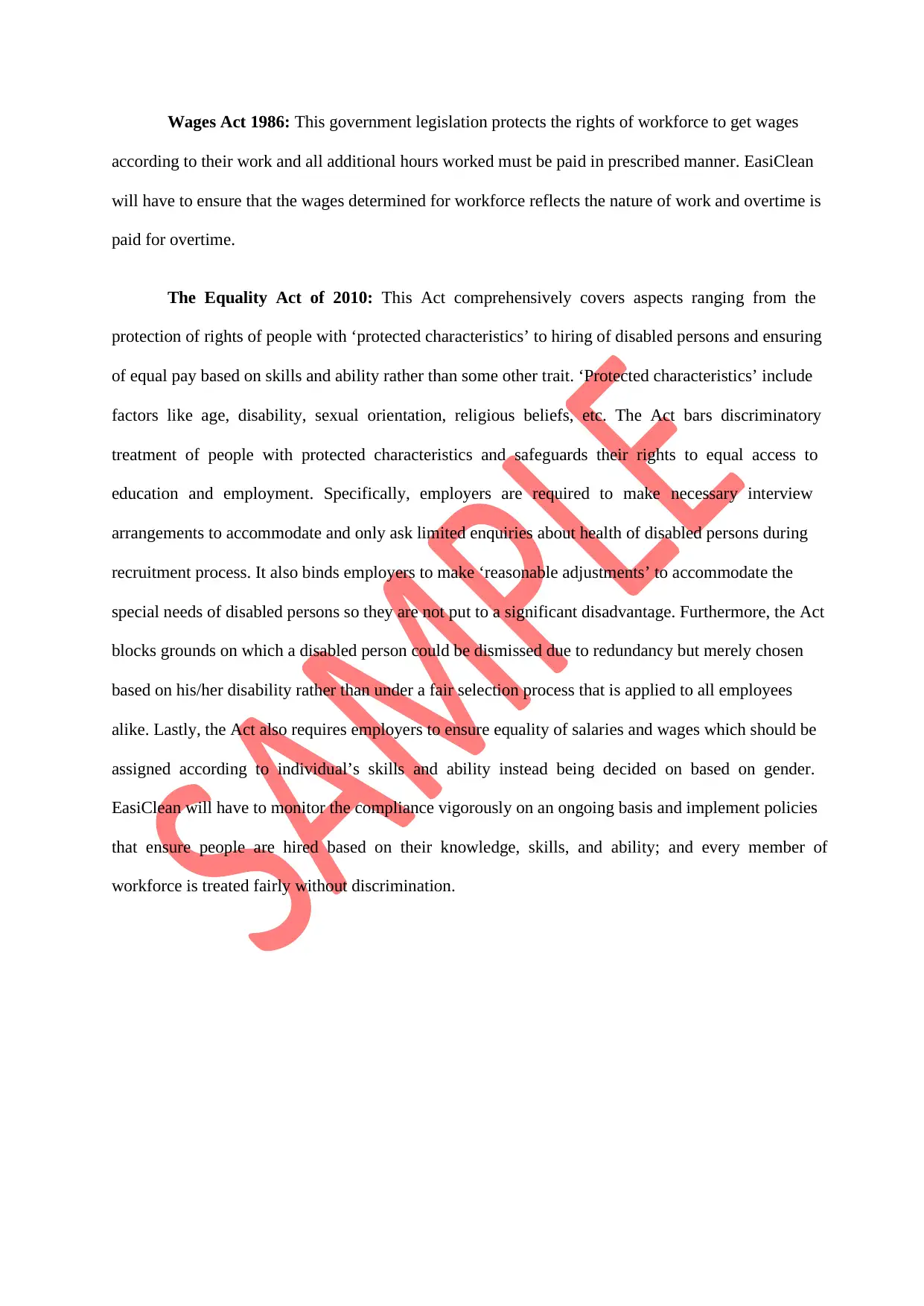
Wages Act 1986: This government legislation protects the rights of workforce to get wages
according to their work and all additional hours worked must be paid in prescribed manner. EasiClean
will have to ensure that the wages determined for workforce reflects the nature of work and overtime is
paid for overtime.
The Equality Act of 2010: This Act comprehensively covers aspects ranging from the
protection of rights of people with ‘protected characteristics’ to hiring of disabled persons and ensuring
of equal pay based on skills and ability rather than some other trait. ‘Protected characteristics’ include
factors like age, disability, sexual orientation, religious beliefs, etc. The Act bars discriminatory
treatment of people with protected characteristics and safeguards their rights to equal access to
education and employment. Specifically, employers are required to make necessary interview
arrangements to accommodate and only ask limited enquiries about health of disabled persons during
recruitment process. It also binds employers to make ‘reasonable adjustments’ to accommodate the
special needs of disabled persons so they are not put to a significant disadvantage. Furthermore, the Act
blocks grounds on which a disabled person could be dismissed due to redundancy but merely chosen
based on his/her disability rather than under a fair selection process that is applied to all employees
alike. Lastly, the Act also requires employers to ensure equality of salaries and wages which should be
assigned according to individual’s skills and ability instead being decided on based on gender.
EasiClean will have to monitor the compliance vigorously on an ongoing basis and implement policies
that ensure people are hired based on their knowledge, skills, and ability; and every member of
workforce is treated fairly without discrimination.
according to their work and all additional hours worked must be paid in prescribed manner. EasiClean
will have to ensure that the wages determined for workforce reflects the nature of work and overtime is
paid for overtime.
The Equality Act of 2010: This Act comprehensively covers aspects ranging from the
protection of rights of people with ‘protected characteristics’ to hiring of disabled persons and ensuring
of equal pay based on skills and ability rather than some other trait. ‘Protected characteristics’ include
factors like age, disability, sexual orientation, religious beliefs, etc. The Act bars discriminatory
treatment of people with protected characteristics and safeguards their rights to equal access to
education and employment. Specifically, employers are required to make necessary interview
arrangements to accommodate and only ask limited enquiries about health of disabled persons during
recruitment process. It also binds employers to make ‘reasonable adjustments’ to accommodate the
special needs of disabled persons so they are not put to a significant disadvantage. Furthermore, the Act
blocks grounds on which a disabled person could be dismissed due to redundancy but merely chosen
based on his/her disability rather than under a fair selection process that is applied to all employees
alike. Lastly, the Act also requires employers to ensure equality of salaries and wages which should be
assigned according to individual’s skills and ability instead being decided on based on gender.
EasiClean will have to monitor the compliance vigorously on an ongoing basis and implement policies
that ensure people are hired based on their knowledge, skills, and ability; and every member of
workforce is treated fairly without discrimination.
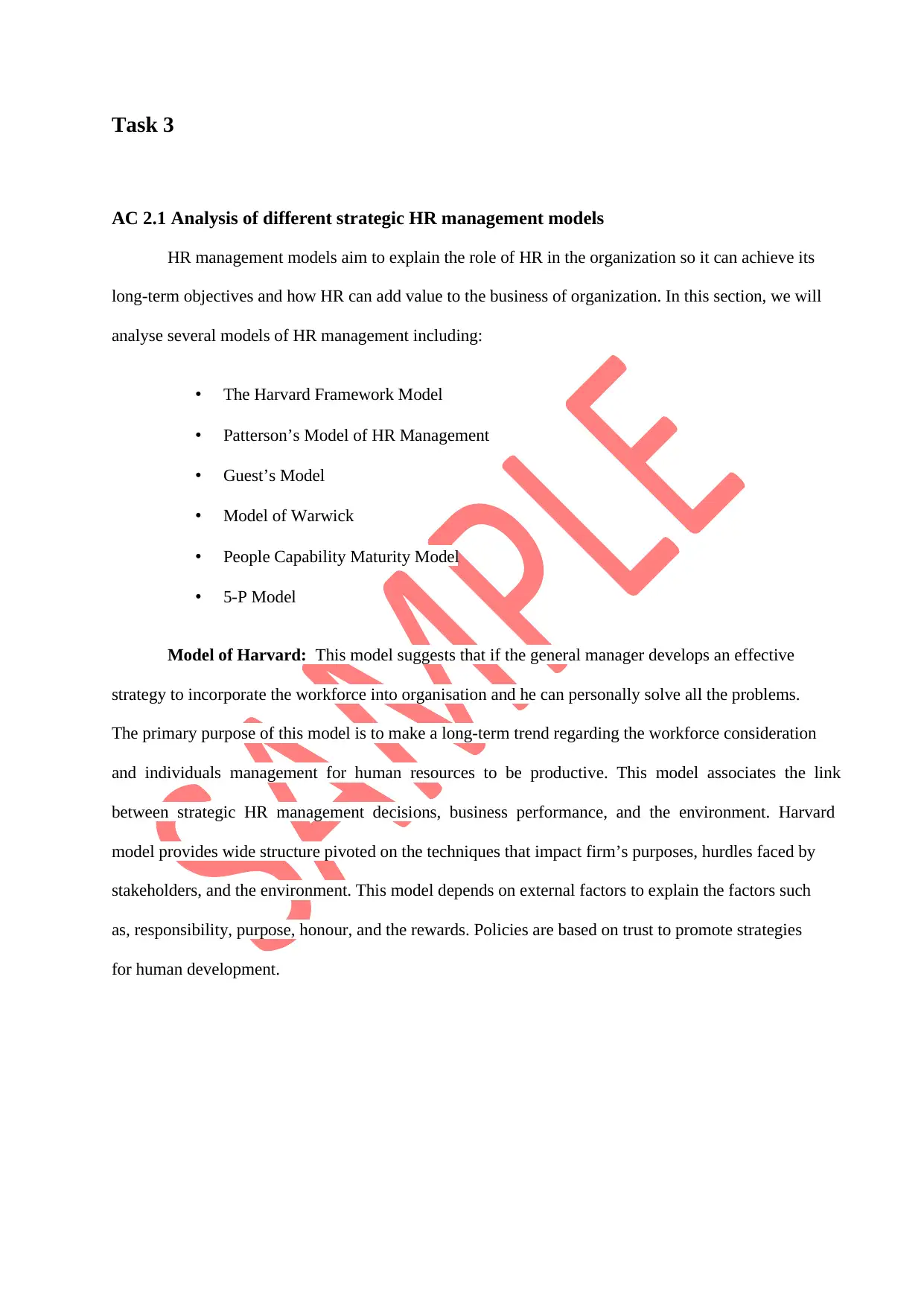
Task 3
AC 2.1 Analysis of different strategic HR management models
HR management models aim to explain the role of HR in the organization so it can achieve its
long-term objectives and how HR can add value to the business of organization. In this section, we will
analyse several models of HR management including:
• The Harvard Framework Model
• Patterson’s Model of HR Management
• Guest’s Model
• Model of Warwick
• People Capability Maturity Model
• 5-P Model
Model of Harvard: This model suggests that if the general manager develops an effective
strategy to incorporate the workforce into organisation and he can personally solve all the problems.
The primary purpose of this model is to make a long-term trend regarding the workforce consideration
and individuals management for human resources to be productive. This model associates the link
between strategic HR management decisions, business performance, and the environment. Harvard
model provides wide structure pivoted on the techniques that impact firm’s purposes, hurdles faced by
stakeholders, and the environment. This model depends on external factors to explain the factors such
as, responsibility, purpose, honour, and the rewards. Policies are based on trust to promote strategies
for human development.
AC 2.1 Analysis of different strategic HR management models
HR management models aim to explain the role of HR in the organization so it can achieve its
long-term objectives and how HR can add value to the business of organization. In this section, we will
analyse several models of HR management including:
• The Harvard Framework Model
• Patterson’s Model of HR Management
• Guest’s Model
• Model of Warwick
• People Capability Maturity Model
• 5-P Model
Model of Harvard: This model suggests that if the general manager develops an effective
strategy to incorporate the workforce into organisation and he can personally solve all the problems.
The primary purpose of this model is to make a long-term trend regarding the workforce consideration
and individuals management for human resources to be productive. This model associates the link
between strategic HR management decisions, business performance, and the environment. Harvard
model provides wide structure pivoted on the techniques that impact firm’s purposes, hurdles faced by
stakeholders, and the environment. This model depends on external factors to explain the factors such
as, responsibility, purpose, honour, and the rewards. Policies are based on trust to promote strategies
for human development.
Paraphrase This Document
Need a fresh take? Get an instant paraphrase of this document with our AI Paraphraser
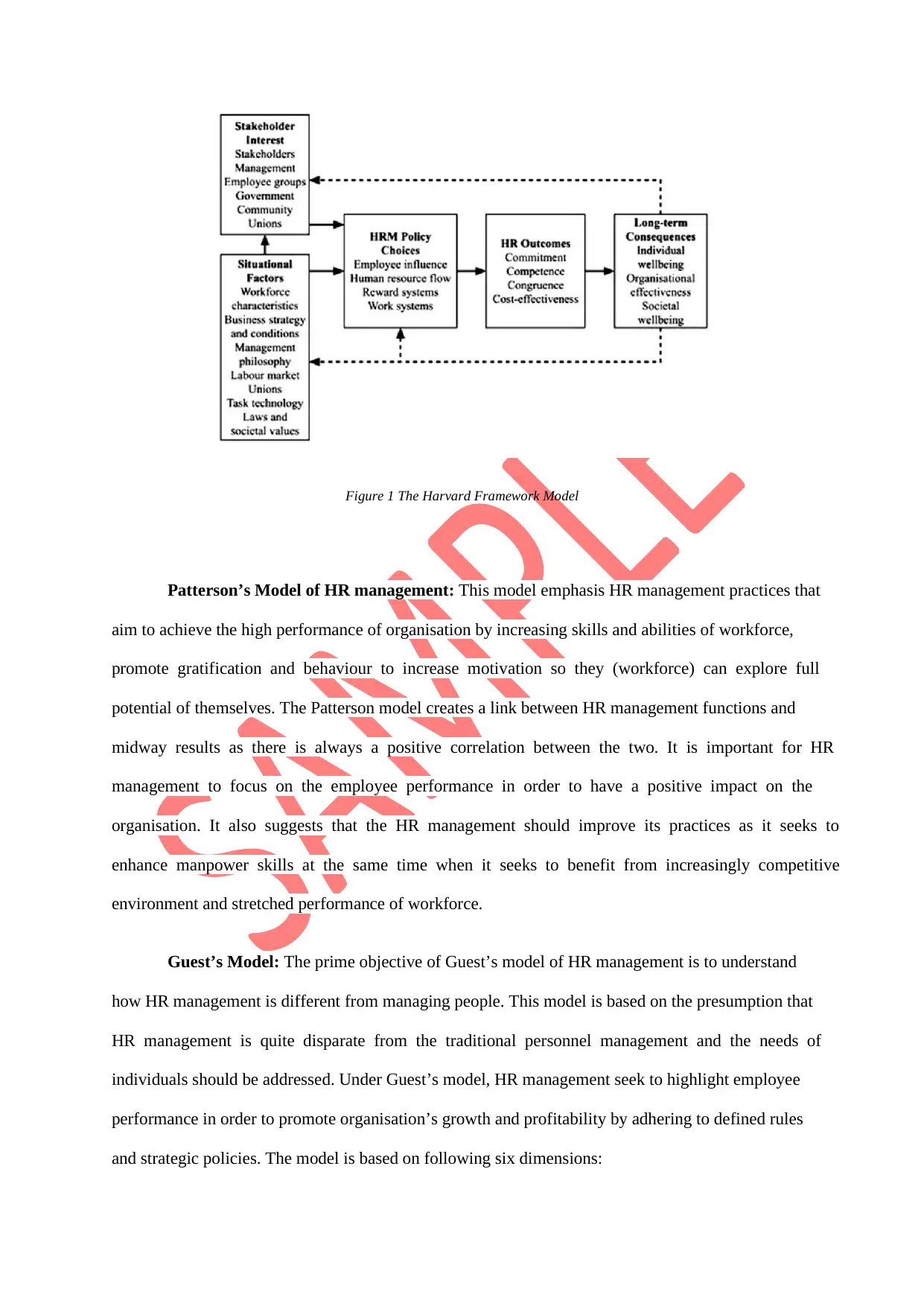
Figure 1 The Harvard Framework Model
Patterson’s Model of HR management: This model emphasis HR management practices that
aim to achieve the high performance of organisation by increasing skills and abilities of workforce,
promote gratification and behaviour to increase motivation so they (workforce) can explore full
potential of themselves. The Patterson model creates a link between HR management functions and
midway results as there is always a positive correlation between the two. It is important for HR
management to focus on the employee performance in order to have a positive impact on the
organisation. It also suggests that the HR management should improve its practices as it seeks to
enhance manpower skills at the same time when it seeks to benefit from increasingly competitive
environment and stretched performance of workforce.
Guest’s Model: The prime objective of Guest’s model of HR management is to understand
how HR management is different from managing people. This model is based on the presumption that
HR management is quite disparate from the traditional personnel management and the needs of
individuals should be addressed. Under Guest’s model, HR management seek to highlight employee
performance in order to promote organisation’s growth and profitability by adhering to defined rules
and strategic policies. The model is based on following six dimensions:
Patterson’s Model of HR management: This model emphasis HR management practices that
aim to achieve the high performance of organisation by increasing skills and abilities of workforce,
promote gratification and behaviour to increase motivation so they (workforce) can explore full
potential of themselves. The Patterson model creates a link between HR management functions and
midway results as there is always a positive correlation between the two. It is important for HR
management to focus on the employee performance in order to have a positive impact on the
organisation. It also suggests that the HR management should improve its practices as it seeks to
enhance manpower skills at the same time when it seeks to benefit from increasingly competitive
environment and stretched performance of workforce.
Guest’s Model: The prime objective of Guest’s model of HR management is to understand
how HR management is different from managing people. This model is based on the presumption that
HR management is quite disparate from the traditional personnel management and the needs of
individuals should be addressed. Under Guest’s model, HR management seek to highlight employee
performance in order to promote organisation’s growth and profitability by adhering to defined rules
and strategic policies. The model is based on following six dimensions:
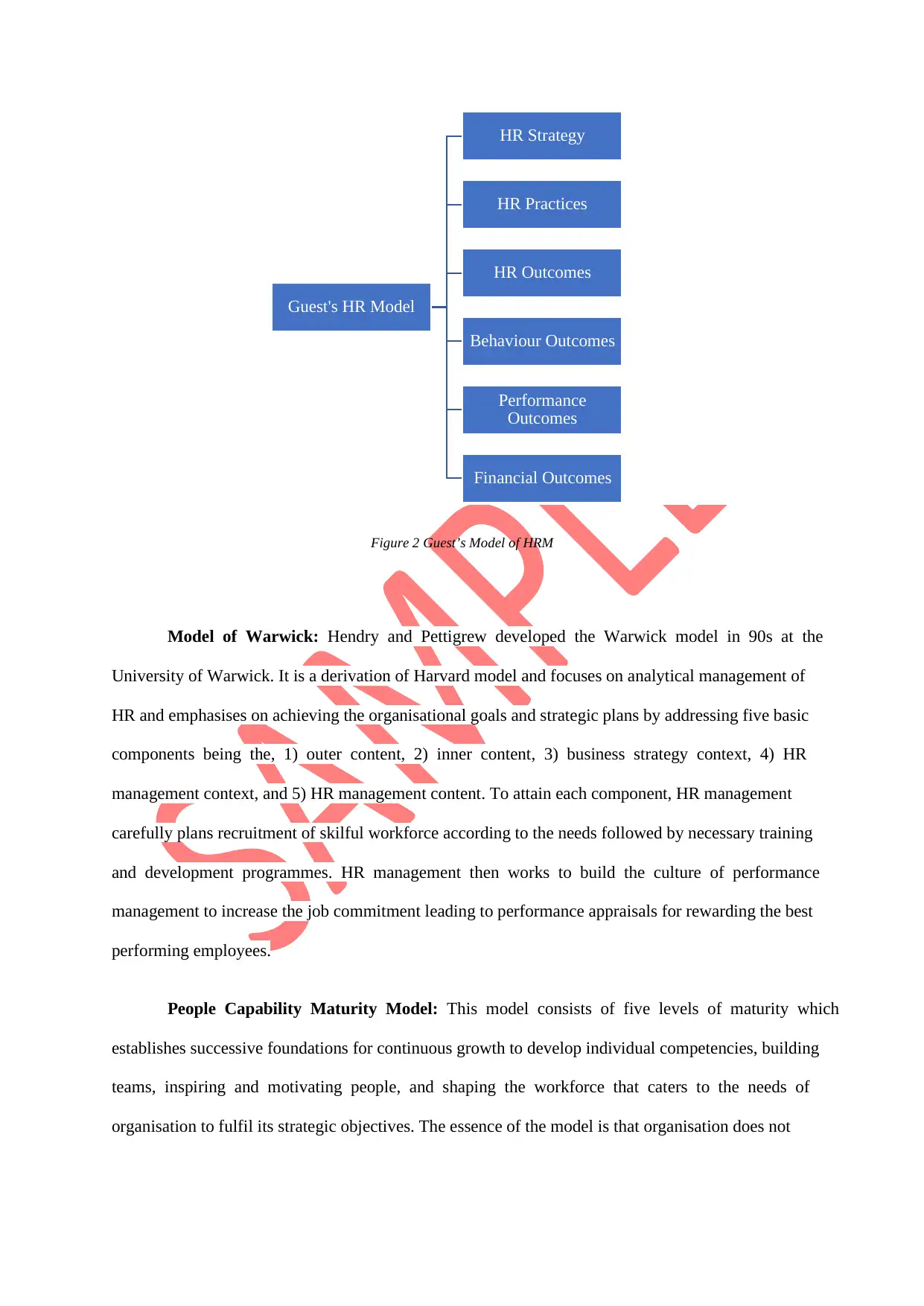
Figure 2 Guest’s Model of HRM
Model of Warwick: Hendry and Pettigrew developed the Warwick model in 90s at the
University of Warwick. It is a derivation of Harvard model and focuses on analytical management of
HR and emphasises on achieving the organisational goals and strategic plans by addressing five basic
components being the, 1) outer content, 2) inner content, 3) business strategy context, 4) HR
management context, and 5) HR management content. To attain each component, HR management
carefully plans recruitment of skilful workforce according to the needs followed by necessary training
and development programmes. HR management then works to build the culture of performance
management to increase the job commitment leading to performance appraisals for rewarding the best
performing employees.
People Capability Maturity Model: This model consists of five levels of maturity which
establishes successive foundations for continuous growth to develop individual competencies, building
teams, inspiring and motivating people, and shaping the workforce that caters to the needs of
organisation to fulfil its strategic objectives. The essence of the model is that organisation does not
Guest's HR Model
HR Strategy
HR Practices
HR Outcomes
Behaviour Outcomes
Performance
Outcomes
Financial Outcomes
Model of Warwick: Hendry and Pettigrew developed the Warwick model in 90s at the
University of Warwick. It is a derivation of Harvard model and focuses on analytical management of
HR and emphasises on achieving the organisational goals and strategic plans by addressing five basic
components being the, 1) outer content, 2) inner content, 3) business strategy context, 4) HR
management context, and 5) HR management content. To attain each component, HR management
carefully plans recruitment of skilful workforce according to the needs followed by necessary training
and development programmes. HR management then works to build the culture of performance
management to increase the job commitment leading to performance appraisals for rewarding the best
performing employees.
People Capability Maturity Model: This model consists of five levels of maturity which
establishes successive foundations for continuous growth to develop individual competencies, building
teams, inspiring and motivating people, and shaping the workforce that caters to the needs of
organisation to fulfil its strategic objectives. The essence of the model is that organisation does not
Guest's HR Model
HR Strategy
HR Practices
HR Outcomes
Behaviour Outcomes
Performance
Outcomes
Financial Outcomes
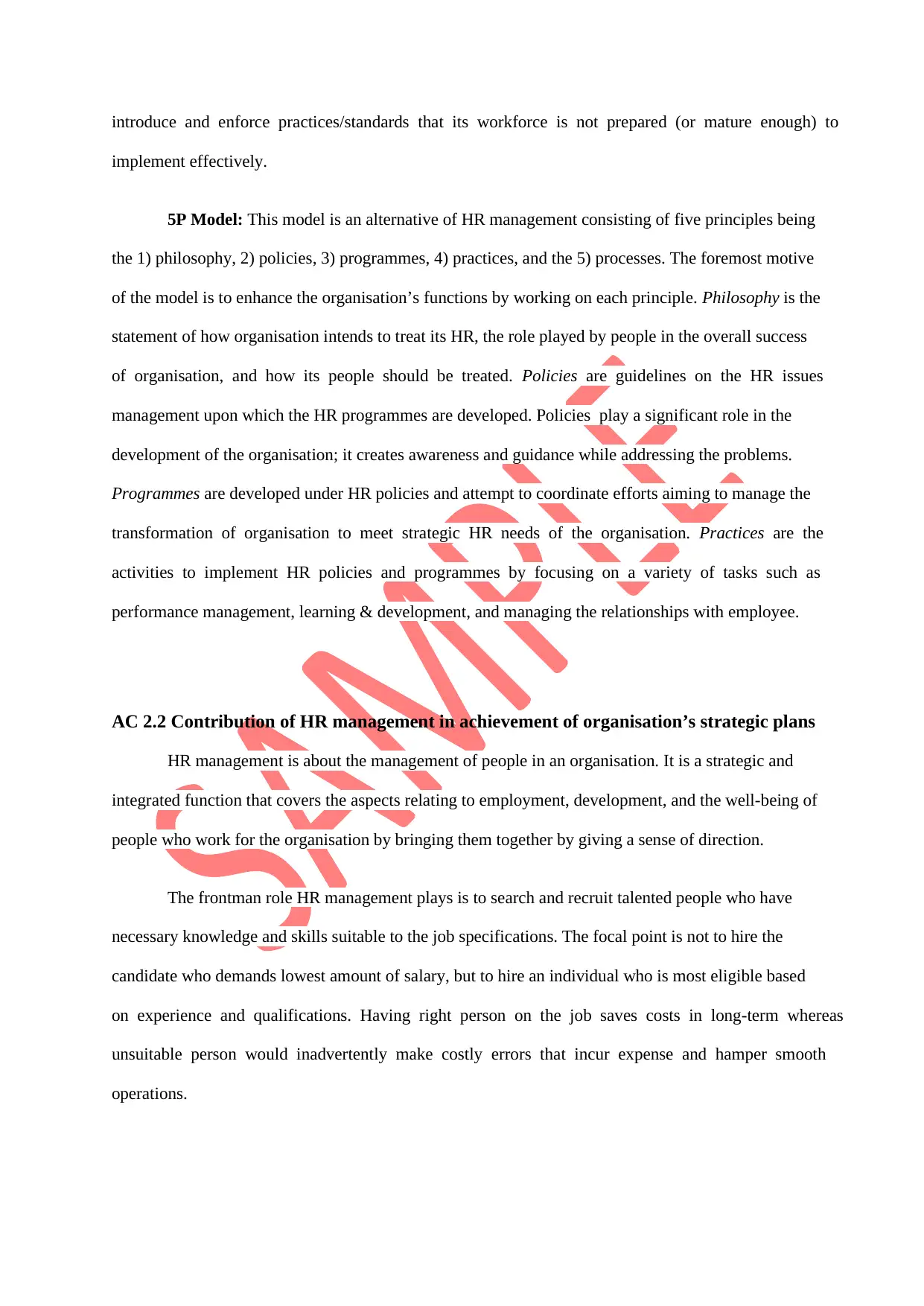
introduce and enforce practices/standards that its workforce is not prepared (or mature enough) to
implement effectively.
5P Model: This model is an alternative of HR management consisting of five principles being
the 1) philosophy, 2) policies, 3) programmes, 4) practices, and the 5) processes. The foremost motive
of the model is to enhance the organisation’s functions by working on each principle. Philosophy is the
statement of how organisation intends to treat its HR, the role played by people in the overall success
of organisation, and how its people should be treated. Policies are guidelines on the HR issues
management upon which the HR programmes are developed. Policies play a significant role in the
development of the organisation; it creates awareness and guidance while addressing the problems.
Programmes are developed under HR policies and attempt to coordinate efforts aiming to manage the
transformation of organisation to meet strategic HR needs of the organisation. Practices are the
activities to implement HR policies and programmes by focusing on a variety of tasks such as
performance management, learning & development, and managing the relationships with employee.
AC 2.2 Contribution of HR management in achievement of organisation’s strategic plans
HR management is about the management of people in an organisation. It is a strategic and
integrated function that covers the aspects relating to employment, development, and the well-being of
people who work for the organisation by bringing them together by giving a sense of direction.
The frontman role HR management plays is to search and recruit talented people who have
necessary knowledge and skills suitable to the job specifications. The focal point is not to hire the
candidate who demands lowest amount of salary, but to hire an individual who is most eligible based
on experience and qualifications. Having right person on the job saves costs in long-term whereas
unsuitable person would inadvertently make costly errors that incur expense and hamper smooth
operations.
implement effectively.
5P Model: This model is an alternative of HR management consisting of five principles being
the 1) philosophy, 2) policies, 3) programmes, 4) practices, and the 5) processes. The foremost motive
of the model is to enhance the organisation’s functions by working on each principle. Philosophy is the
statement of how organisation intends to treat its HR, the role played by people in the overall success
of organisation, and how its people should be treated. Policies are guidelines on the HR issues
management upon which the HR programmes are developed. Policies play a significant role in the
development of the organisation; it creates awareness and guidance while addressing the problems.
Programmes are developed under HR policies and attempt to coordinate efforts aiming to manage the
transformation of organisation to meet strategic HR needs of the organisation. Practices are the
activities to implement HR policies and programmes by focusing on a variety of tasks such as
performance management, learning & development, and managing the relationships with employee.
AC 2.2 Contribution of HR management in achievement of organisation’s strategic plans
HR management is about the management of people in an organisation. It is a strategic and
integrated function that covers the aspects relating to employment, development, and the well-being of
people who work for the organisation by bringing them together by giving a sense of direction.
The frontman role HR management plays is to search and recruit talented people who have
necessary knowledge and skills suitable to the job specifications. The focal point is not to hire the
candidate who demands lowest amount of salary, but to hire an individual who is most eligible based
on experience and qualifications. Having right person on the job saves costs in long-term whereas
unsuitable person would inadvertently make costly errors that incur expense and hamper smooth
operations.
Secure Best Marks with AI Grader
Need help grading? Try our AI Grader for instant feedback on your assignments.
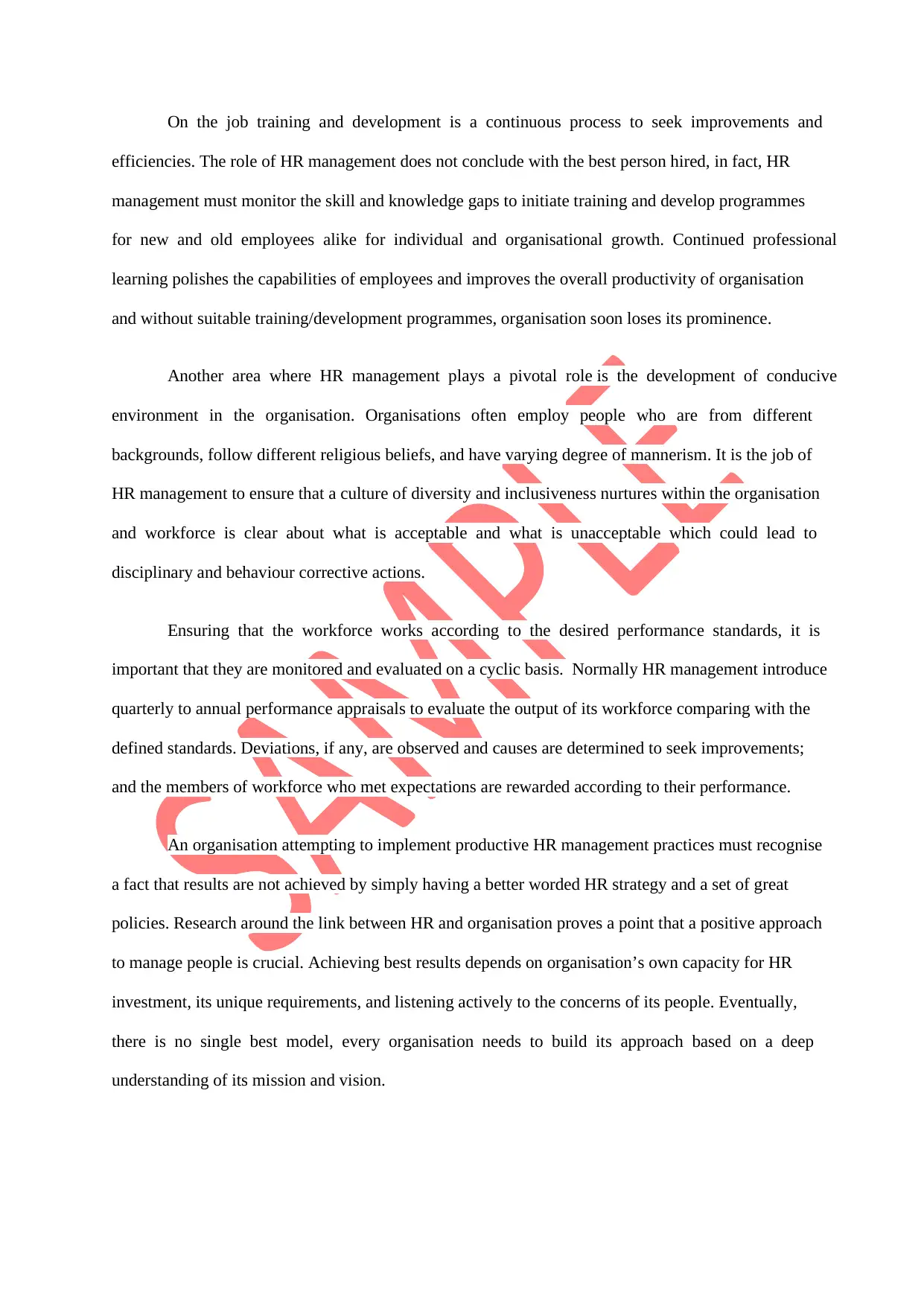
On the job training and development is a continuous process to seek improvements and
efficiencies. The role of HR management does not conclude with the best person hired, in fact, HR
management must monitor the skill and knowledge gaps to initiate training and develop programmes
for new and old employees alike for individual and organisational growth. Continued professional
learning polishes the capabilities of employees and improves the overall productivity of organisation
and without suitable training/development programmes, organisation soon loses its prominence.
Another area where HR management plays a pivotal role is the development of conducive
environment in the organisation. Organisations often employ people who are from different
backgrounds, follow different religious beliefs, and have varying degree of mannerism. It is the job of
HR management to ensure that a culture of diversity and inclusiveness nurtures within the organisation
and workforce is clear about what is acceptable and what is unacceptable which could lead to
disciplinary and behaviour corrective actions.
Ensuring that the workforce works according to the desired performance standards, it is
important that they are monitored and evaluated on a cyclic basis. Normally HR management introduce
quarterly to annual performance appraisals to evaluate the output of its workforce comparing with the
defined standards. Deviations, if any, are observed and causes are determined to seek improvements;
and the members of workforce who met expectations are rewarded according to their performance.
An organisation attempting to implement productive HR management practices must recognise
a fact that results are not achieved by simply having a better worded HR strategy and a set of great
policies. Research around the link between HR and organisation proves a point that a positive approach
to manage people is crucial. Achieving best results depends on organisation’s own capacity for HR
investment, its unique requirements, and listening actively to the concerns of its people. Eventually,
there is no single best model, every organisation needs to build its approach based on a deep
understanding of its mission and vision.
efficiencies. The role of HR management does not conclude with the best person hired, in fact, HR
management must monitor the skill and knowledge gaps to initiate training and develop programmes
for new and old employees alike for individual and organisational growth. Continued professional
learning polishes the capabilities of employees and improves the overall productivity of organisation
and without suitable training/development programmes, organisation soon loses its prominence.
Another area where HR management plays a pivotal role is the development of conducive
environment in the organisation. Organisations often employ people who are from different
backgrounds, follow different religious beliefs, and have varying degree of mannerism. It is the job of
HR management to ensure that a culture of diversity and inclusiveness nurtures within the organisation
and workforce is clear about what is acceptable and what is unacceptable which could lead to
disciplinary and behaviour corrective actions.
Ensuring that the workforce works according to the desired performance standards, it is
important that they are monitored and evaluated on a cyclic basis. Normally HR management introduce
quarterly to annual performance appraisals to evaluate the output of its workforce comparing with the
defined standards. Deviations, if any, are observed and causes are determined to seek improvements;
and the members of workforce who met expectations are rewarded according to their performance.
An organisation attempting to implement productive HR management practices must recognise
a fact that results are not achieved by simply having a better worded HR strategy and a set of great
policies. Research around the link between HR and organisation proves a point that a positive approach
to manage people is crucial. Achieving best results depends on organisation’s own capacity for HR
investment, its unique requirements, and listening actively to the concerns of its people. Eventually,
there is no single best model, every organisation needs to build its approach based on a deep
understanding of its mission and vision.
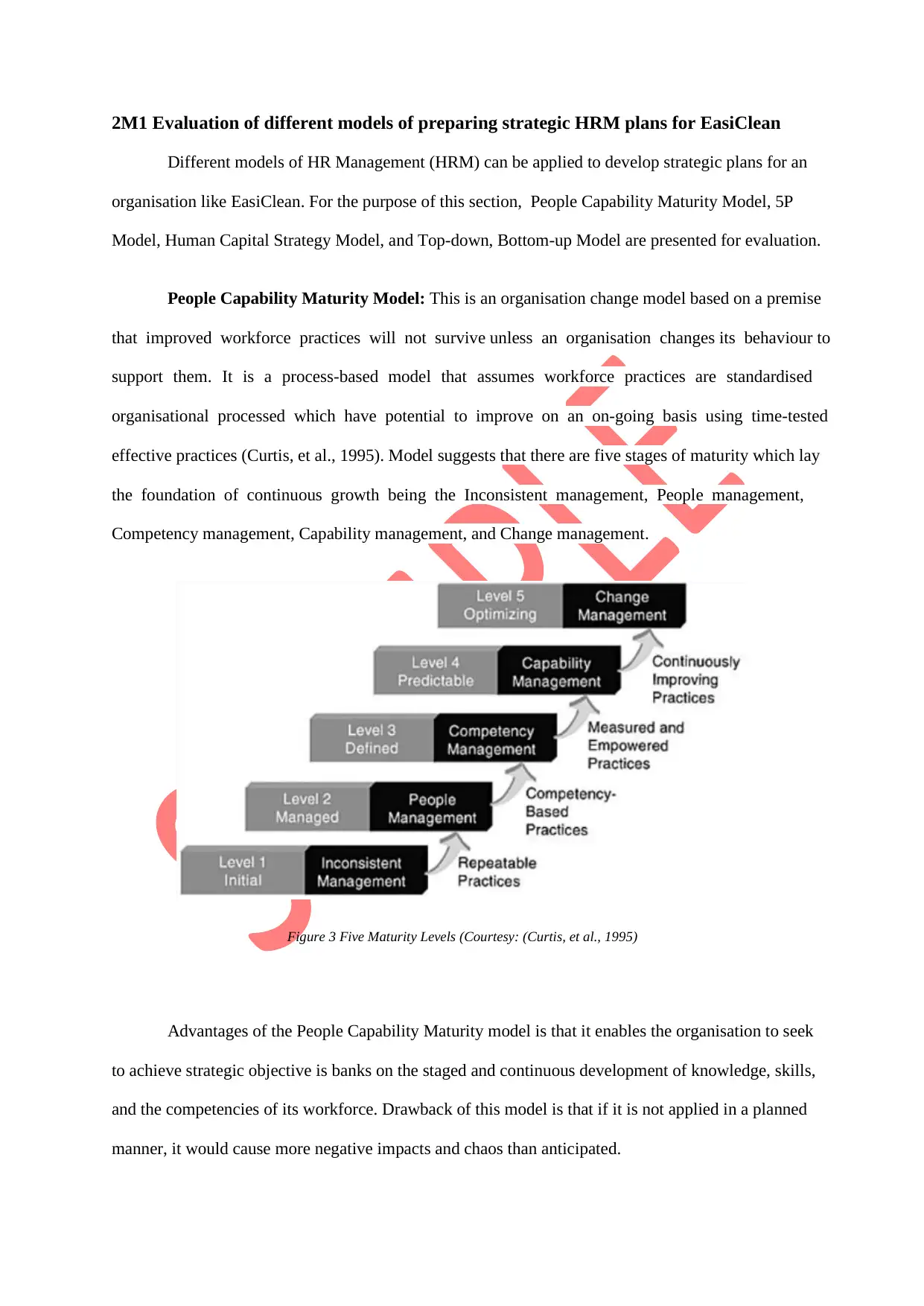
2M1 Evaluation of different models of preparing strategic HRM plans for EasiClean
Different models of HR Management (HRM) can be applied to develop strategic plans for an
organisation like EasiClean. For the purpose of this section, People Capability Maturity Model, 5P
Model, Human Capital Strategy Model, and Top-down, Bottom-up Model are presented for evaluation.
People Capability Maturity Model: This is an organisation change model based on a premise
that improved workforce practices will not survive unless an organisation changes its behaviour to
support them. It is a process-based model that assumes workforce practices are standardised
organisational processed which have potential to improve on an on-going basis using time-tested
effective practices (Curtis, et al., 1995). Model suggests that there are five stages of maturity which lay
the foundation of continuous growth being the Inconsistent management, People management,
Competency management, Capability management, and Change management.
Figure 3 Five Maturity Levels (Courtesy: (Curtis, et al., 1995)
Advantages of the People Capability Maturity model is that it enables the organisation to seek
to achieve strategic objective is banks on the staged and continuous development of knowledge, skills,
and the competencies of its workforce. Drawback of this model is that if it is not applied in a planned
manner, it would cause more negative impacts and chaos than anticipated.
Different models of HR Management (HRM) can be applied to develop strategic plans for an
organisation like EasiClean. For the purpose of this section, People Capability Maturity Model, 5P
Model, Human Capital Strategy Model, and Top-down, Bottom-up Model are presented for evaluation.
People Capability Maturity Model: This is an organisation change model based on a premise
that improved workforce practices will not survive unless an organisation changes its behaviour to
support them. It is a process-based model that assumes workforce practices are standardised
organisational processed which have potential to improve on an on-going basis using time-tested
effective practices (Curtis, et al., 1995). Model suggests that there are five stages of maturity which lay
the foundation of continuous growth being the Inconsistent management, People management,
Competency management, Capability management, and Change management.
Figure 3 Five Maturity Levels (Courtesy: (Curtis, et al., 1995)
Advantages of the People Capability Maturity model is that it enables the organisation to seek
to achieve strategic objective is banks on the staged and continuous development of knowledge, skills,
and the competencies of its workforce. Drawback of this model is that if it is not applied in a planned
manner, it would cause more negative impacts and chaos than anticipated.
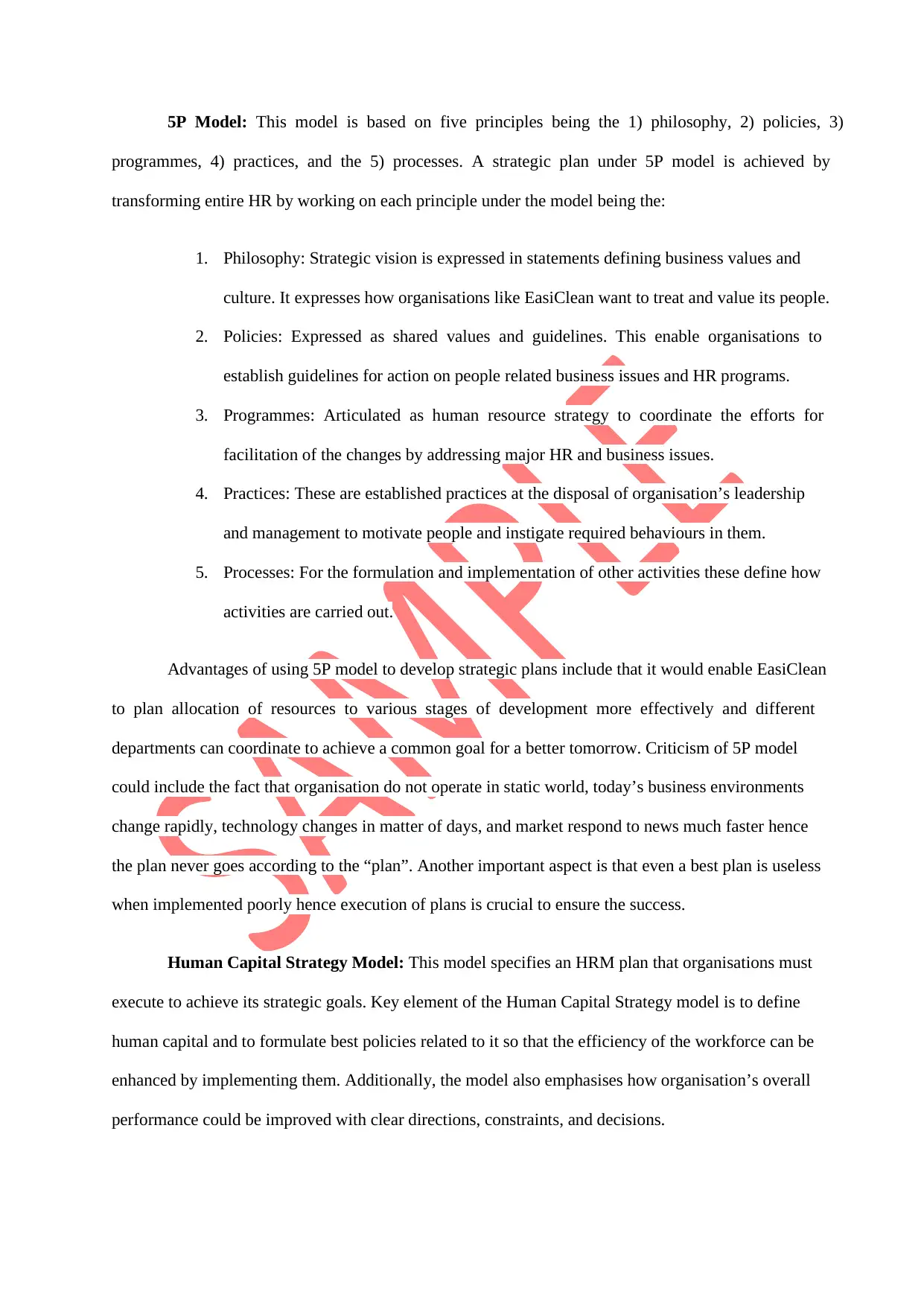
5P Model: This model is based on five principles being the 1) philosophy, 2) policies, 3)
programmes, 4) practices, and the 5) processes. A strategic plan under 5P model is achieved by
transforming entire HR by working on each principle under the model being the:
1. Philosophy: Strategic vision is expressed in statements defining business values and
culture. It expresses how organisations like EasiClean want to treat and value its people.
2. Policies: Expressed as shared values and guidelines. This enable organisations to
establish guidelines for action on people related business issues and HR programs.
3. Programmes: Articulated as human resource strategy to coordinate the efforts for
facilitation of the changes by addressing major HR and business issues.
4. Practices: These are established practices at the disposal of organisation’s leadership
and management to motivate people and instigate required behaviours in them.
5. Processes: For the formulation and implementation of other activities these define how
activities are carried out.
Advantages of using 5P model to develop strategic plans include that it would enable EasiClean
to plan allocation of resources to various stages of development more effectively and different
departments can coordinate to achieve a common goal for a better tomorrow. Criticism of 5P model
could include the fact that organisation do not operate in static world, today’s business environments
change rapidly, technology changes in matter of days, and market respond to news much faster hence
the plan never goes according to the “plan”. Another important aspect is that even a best plan is useless
when implemented poorly hence execution of plans is crucial to ensure the success.
Human Capital Strategy Model: This model specifies an HRM plan that organisations must
execute to achieve its strategic goals. Key element of the Human Capital Strategy model is to define
human capital and to formulate best policies related to it so that the efficiency of the workforce can be
enhanced by implementing them. Additionally, the model also emphasises how organisation’s overall
performance could be improved with clear directions, constraints, and decisions.
programmes, 4) practices, and the 5) processes. A strategic plan under 5P model is achieved by
transforming entire HR by working on each principle under the model being the:
1. Philosophy: Strategic vision is expressed in statements defining business values and
culture. It expresses how organisations like EasiClean want to treat and value its people.
2. Policies: Expressed as shared values and guidelines. This enable organisations to
establish guidelines for action on people related business issues and HR programs.
3. Programmes: Articulated as human resource strategy to coordinate the efforts for
facilitation of the changes by addressing major HR and business issues.
4. Practices: These are established practices at the disposal of organisation’s leadership
and management to motivate people and instigate required behaviours in them.
5. Processes: For the formulation and implementation of other activities these define how
activities are carried out.
Advantages of using 5P model to develop strategic plans include that it would enable EasiClean
to plan allocation of resources to various stages of development more effectively and different
departments can coordinate to achieve a common goal for a better tomorrow. Criticism of 5P model
could include the fact that organisation do not operate in static world, today’s business environments
change rapidly, technology changes in matter of days, and market respond to news much faster hence
the plan never goes according to the “plan”. Another important aspect is that even a best plan is useless
when implemented poorly hence execution of plans is crucial to ensure the success.
Human Capital Strategy Model: This model specifies an HRM plan that organisations must
execute to achieve its strategic goals. Key element of the Human Capital Strategy model is to define
human capital and to formulate best policies related to it so that the efficiency of the workforce can be
enhanced by implementing them. Additionally, the model also emphasises how organisation’s overall
performance could be improved with clear directions, constraints, and decisions.
Paraphrase This Document
Need a fresh take? Get an instant paraphrase of this document with our AI Paraphraser
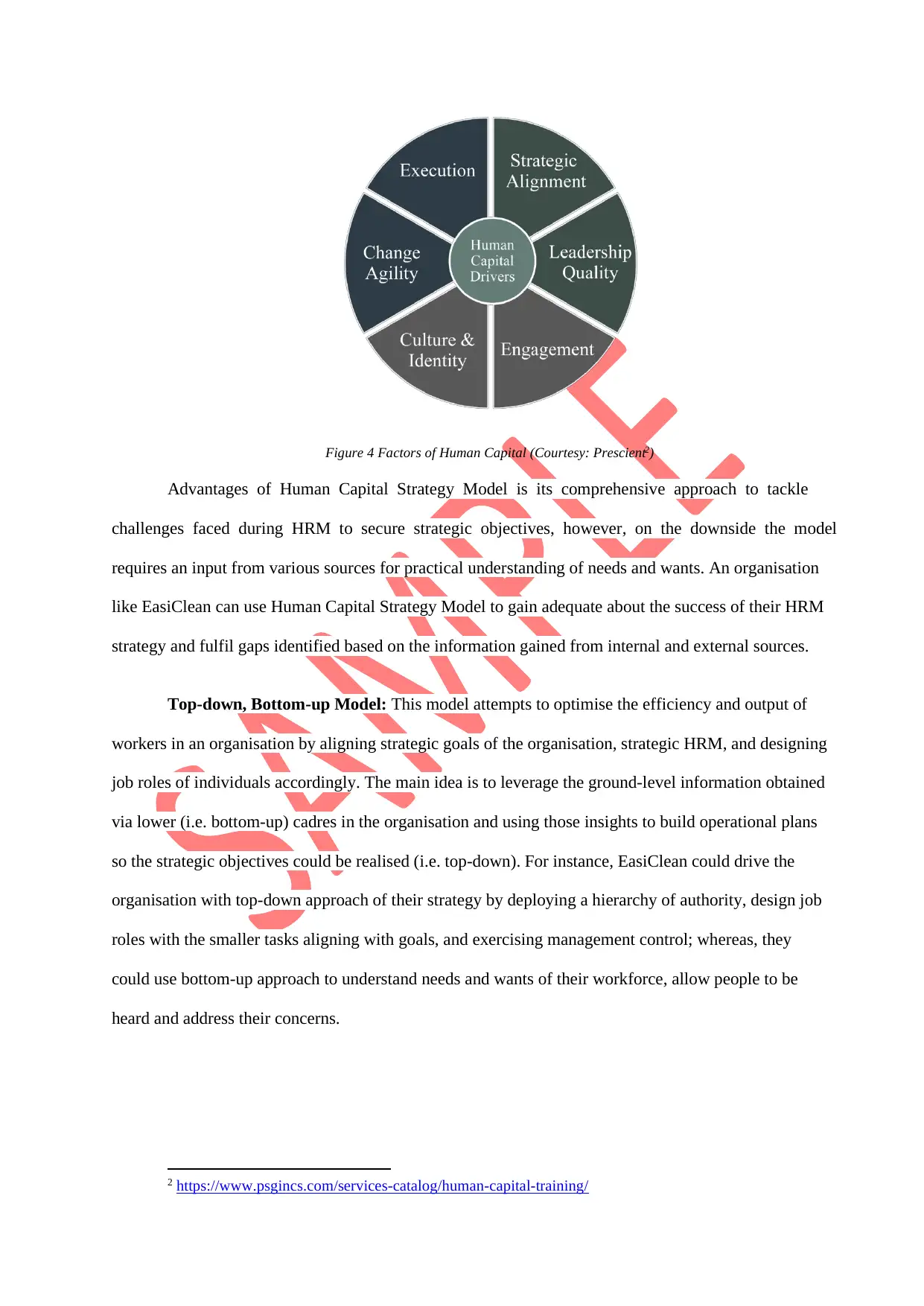
Figure 4 Factors of Human Capital (Courtesy: Prescient2)
Advantages of Human Capital Strategy Model is its comprehensive approach to tackle
challenges faced during HRM to secure strategic objectives, however, on the downside the model
requires an input from various sources for practical understanding of needs and wants. An organisation
like EasiClean can use Human Capital Strategy Model to gain adequate about the success of their HRM
strategy and fulfil gaps identified based on the information gained from internal and external sources.
Top-down, Bottom-up Model: This model attempts to optimise the efficiency and output of
workers in an organisation by aligning strategic goals of the organisation, strategic HRM, and designing
job roles of individuals accordingly. The main idea is to leverage the ground-level information obtained
via lower (i.e. bottom-up) cadres in the organisation and using those insights to build operational plans
so the strategic objectives could be realised (i.e. top-down). For instance, EasiClean could drive the
organisation with top-down approach of their strategy by deploying a hierarchy of authority, design job
roles with the smaller tasks aligning with goals, and exercising management control; whereas, they
could use bottom-up approach to understand needs and wants of their workforce, allow people to be
heard and address their concerns.
2 https://www.psgincs.com/services-catalog/human-capital-training/
Advantages of Human Capital Strategy Model is its comprehensive approach to tackle
challenges faced during HRM to secure strategic objectives, however, on the downside the model
requires an input from various sources for practical understanding of needs and wants. An organisation
like EasiClean can use Human Capital Strategy Model to gain adequate about the success of their HRM
strategy and fulfil gaps identified based on the information gained from internal and external sources.
Top-down, Bottom-up Model: This model attempts to optimise the efficiency and output of
workers in an organisation by aligning strategic goals of the organisation, strategic HRM, and designing
job roles of individuals accordingly. The main idea is to leverage the ground-level information obtained
via lower (i.e. bottom-up) cadres in the organisation and using those insights to build operational plans
so the strategic objectives could be realised (i.e. top-down). For instance, EasiClean could drive the
organisation with top-down approach of their strategy by deploying a hierarchy of authority, design job
roles with the smaller tasks aligning with goals, and exercising management control; whereas, they
could use bottom-up approach to understand needs and wants of their workforce, allow people to be
heard and address their concerns.
2 https://www.psgincs.com/services-catalog/human-capital-training/
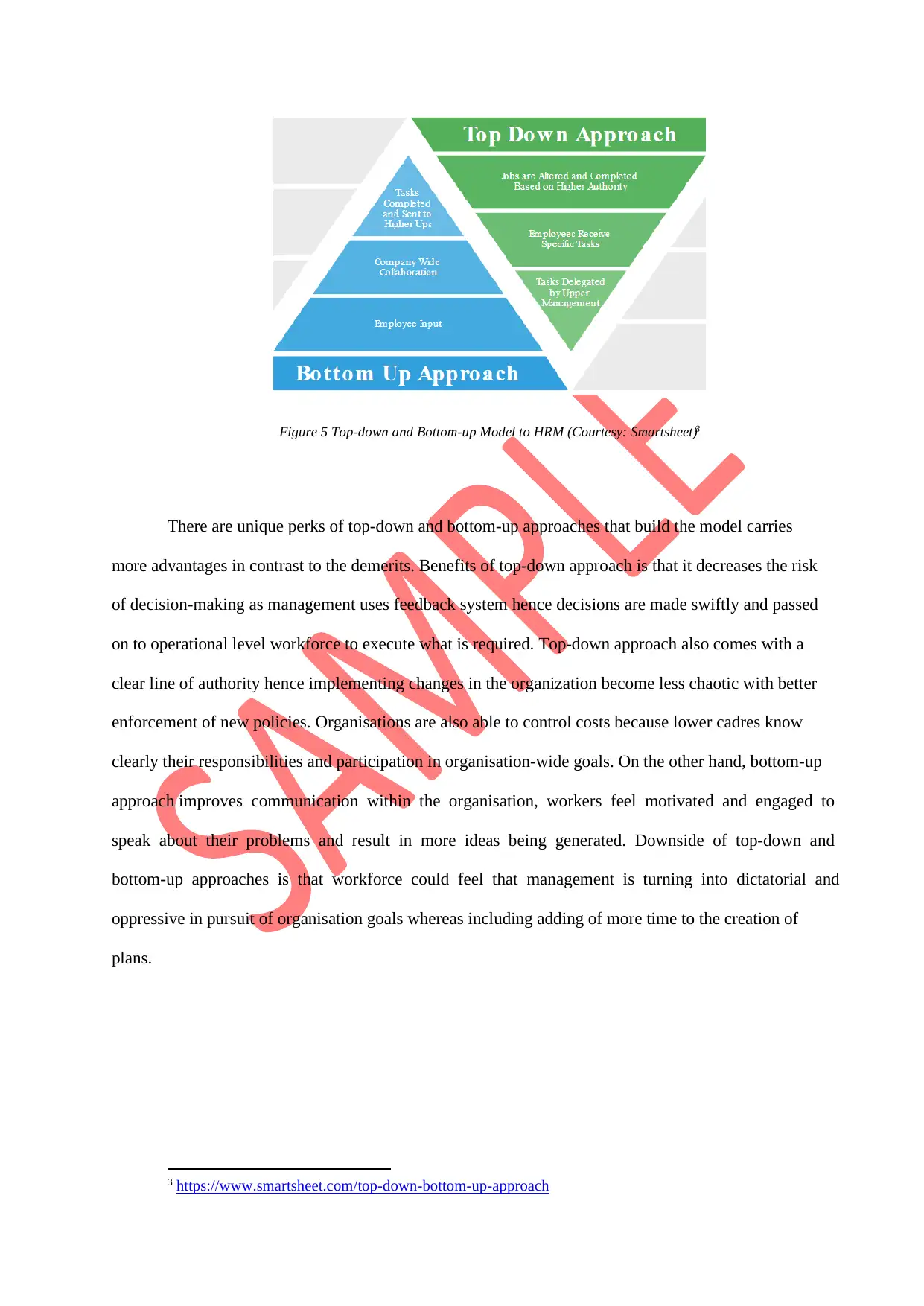
Figure 5 Top-down and Bottom-up Model to HRM (Courtesy: Smartsheet)3
There are unique perks of top-down and bottom-up approaches that build the model carries
more advantages in contrast to the demerits. Benefits of top-down approach is that it decreases the risk
of decision-making as management uses feedback system hence decisions are made swiftly and passed
on to operational level workforce to execute what is required. Top-down approach also comes with a
clear line of authority hence implementing changes in the organization become less chaotic with better
enforcement of new policies. Organisations are also able to control costs because lower cadres know
clearly their responsibilities and participation in organisation-wide goals. On the other hand, bottom-up
approach improves communication within the organisation, workers feel motivated and engaged to
speak about their problems and result in more ideas being generated. Downside of top-down and
bottom-up approaches is that workforce could feel that management is turning into dictatorial and
oppressive in pursuit of organisation goals whereas including adding of more time to the creation of
plans.
3 https://www.smartsheet.com/top-down-bottom-up-approach
There are unique perks of top-down and bottom-up approaches that build the model carries
more advantages in contrast to the demerits. Benefits of top-down approach is that it decreases the risk
of decision-making as management uses feedback system hence decisions are made swiftly and passed
on to operational level workforce to execute what is required. Top-down approach also comes with a
clear line of authority hence implementing changes in the organization become less chaotic with better
enforcement of new policies. Organisations are also able to control costs because lower cadres know
clearly their responsibilities and participation in organisation-wide goals. On the other hand, bottom-up
approach improves communication within the organisation, workers feel motivated and engaged to
speak about their problems and result in more ideas being generated. Downside of top-down and
bottom-up approaches is that workforce could feel that management is turning into dictatorial and
oppressive in pursuit of organisation goals whereas including adding of more time to the creation of
plans.
3 https://www.smartsheet.com/top-down-bottom-up-approach
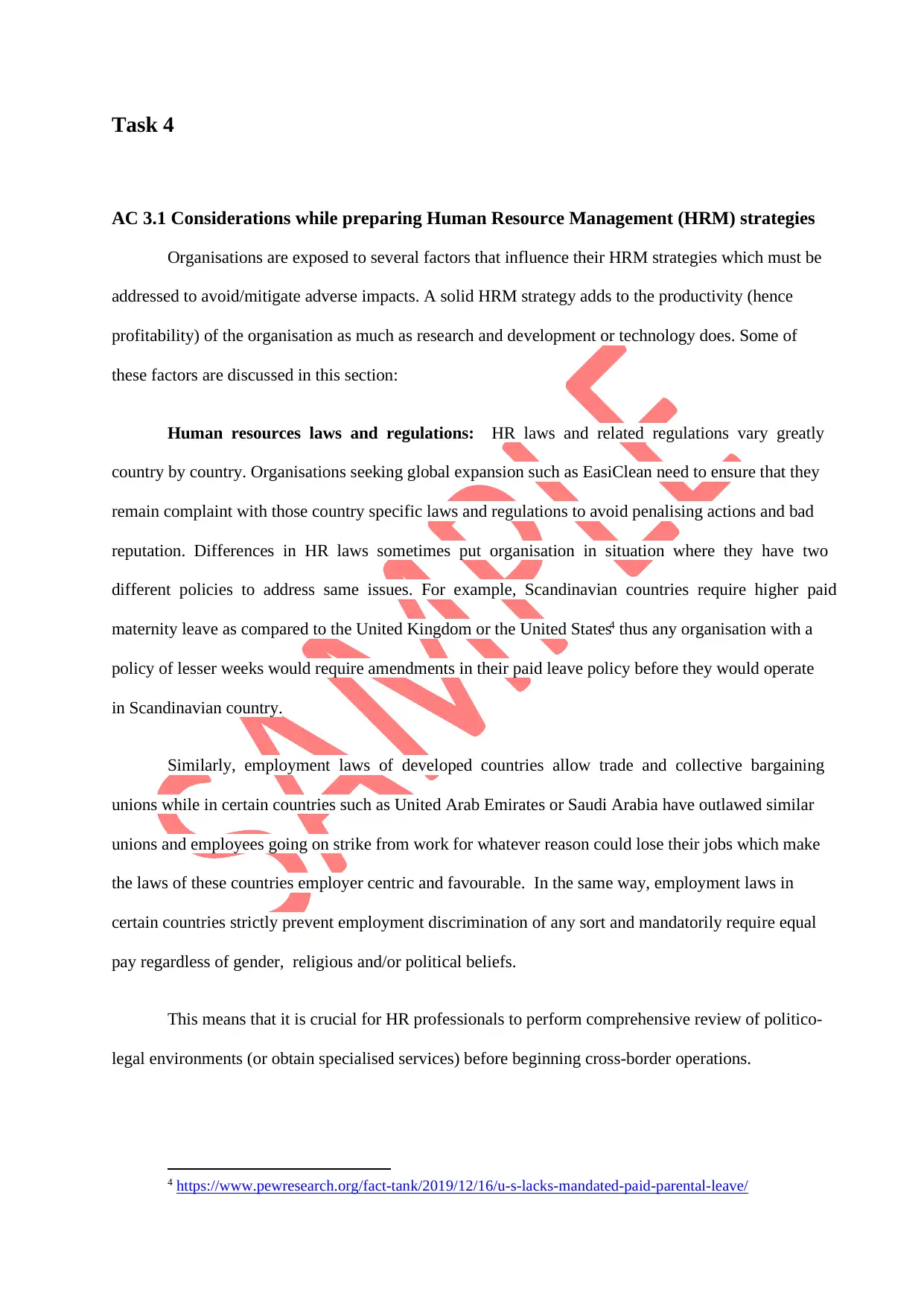
Task 4
AC 3.1 Considerations while preparing Human Resource Management (HRM) strategies
Organisations are exposed to several factors that influence their HRM strategies which must be
addressed to avoid/mitigate adverse impacts. A solid HRM strategy adds to the productivity (hence
profitability) of the organisation as much as research and development or technology does. Some of
these factors are discussed in this section:
Human resources laws and regulations: HR laws and related regulations vary greatly
country by country. Organisations seeking global expansion such as EasiClean need to ensure that they
remain complaint with those country specific laws and regulations to avoid penalising actions and bad
reputation. Differences in HR laws sometimes put organisation in situation where they have two
different policies to address same issues. For example, Scandinavian countries require higher paid
maternity leave as compared to the United Kingdom or the United States4 thus any organisation with a
policy of lesser weeks would require amendments in their paid leave policy before they would operate
in Scandinavian country.
Similarly, employment laws of developed countries allow trade and collective bargaining
unions while in certain countries such as United Arab Emirates or Saudi Arabia have outlawed similar
unions and employees going on strike from work for whatever reason could lose their jobs which make
the laws of these countries employer centric and favourable. In the same way, employment laws in
certain countries strictly prevent employment discrimination of any sort and mandatorily require equal
pay regardless of gender, religious and/or political beliefs.
This means that it is crucial for HR professionals to perform comprehensive review of politico-
legal environments (or obtain specialised services) before beginning cross-border operations.
4 https://www.pewresearch.org/fact-tank/2019/12/16/u-s-lacks-mandated-paid-parental-leave/
AC 3.1 Considerations while preparing Human Resource Management (HRM) strategies
Organisations are exposed to several factors that influence their HRM strategies which must be
addressed to avoid/mitigate adverse impacts. A solid HRM strategy adds to the productivity (hence
profitability) of the organisation as much as research and development or technology does. Some of
these factors are discussed in this section:
Human resources laws and regulations: HR laws and related regulations vary greatly
country by country. Organisations seeking global expansion such as EasiClean need to ensure that they
remain complaint with those country specific laws and regulations to avoid penalising actions and bad
reputation. Differences in HR laws sometimes put organisation in situation where they have two
different policies to address same issues. For example, Scandinavian countries require higher paid
maternity leave as compared to the United Kingdom or the United States4 thus any organisation with a
policy of lesser weeks would require amendments in their paid leave policy before they would operate
in Scandinavian country.
Similarly, employment laws of developed countries allow trade and collective bargaining
unions while in certain countries such as United Arab Emirates or Saudi Arabia have outlawed similar
unions and employees going on strike from work for whatever reason could lose their jobs which make
the laws of these countries employer centric and favourable. In the same way, employment laws in
certain countries strictly prevent employment discrimination of any sort and mandatorily require equal
pay regardless of gender, religious and/or political beliefs.
This means that it is crucial for HR professionals to perform comprehensive review of politico-
legal environments (or obtain specialised services) before beginning cross-border operations.
4 https://www.pewresearch.org/fact-tank/2019/12/16/u-s-lacks-mandated-paid-parental-leave/
Secure Best Marks with AI Grader
Need help grading? Try our AI Grader for instant feedback on your assignments.
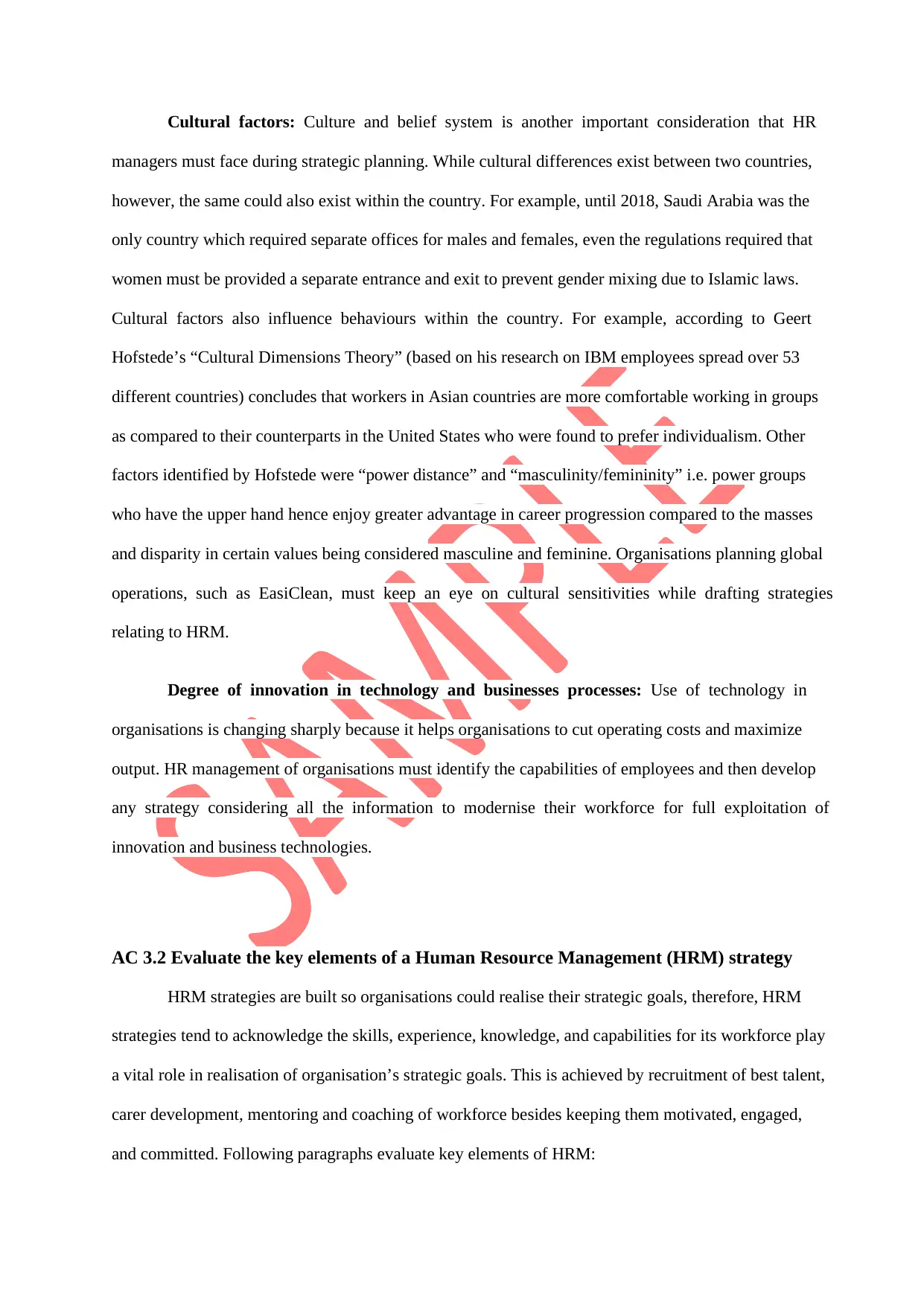
Cultural factors: Culture and belief system is another important consideration that HR
managers must face during strategic planning. While cultural differences exist between two countries,
however, the same could also exist within the country. For example, until 2018, Saudi Arabia was the
only country which required separate offices for males and females, even the regulations required that
women must be provided a separate entrance and exit to prevent gender mixing due to Islamic laws.
Cultural factors also influence behaviours within the country. For example, according to Geert
Hofstede’s “Cultural Dimensions Theory” (based on his research on IBM employees spread over 53
different countries) concludes that workers in Asian countries are more comfortable working in groups
as compared to their counterparts in the United States who were found to prefer individualism. Other
factors identified by Hofstede were “power distance” and “masculinity/femininity” i.e. power groups
who have the upper hand hence enjoy greater advantage in career progression compared to the masses
and disparity in certain values being considered masculine and feminine. Organisations planning global
operations, such as EasiClean, must keep an eye on cultural sensitivities while drafting strategies
relating to HRM.
Degree of innovation in technology and businesses processes: Use of technology in
organisations is changing sharply because it helps organisations to cut operating costs and maximize
output. HR management of organisations must identify the capabilities of employees and then develop
any strategy considering all the information to modernise their workforce for full exploitation of
innovation and business technologies.
AC 3.2 Evaluate the key elements of a Human Resource Management (HRM) strategy
HRM strategies are built so organisations could realise their strategic goals, therefore, HRM
strategies tend to acknowledge the skills, experience, knowledge, and capabilities for its workforce play
a vital role in realisation of organisation’s strategic goals. This is achieved by recruitment of best talent,
carer development, mentoring and coaching of workforce besides keeping them motivated, engaged,
and committed. Following paragraphs evaluate key elements of HRM:
managers must face during strategic planning. While cultural differences exist between two countries,
however, the same could also exist within the country. For example, until 2018, Saudi Arabia was the
only country which required separate offices for males and females, even the regulations required that
women must be provided a separate entrance and exit to prevent gender mixing due to Islamic laws.
Cultural factors also influence behaviours within the country. For example, according to Geert
Hofstede’s “Cultural Dimensions Theory” (based on his research on IBM employees spread over 53
different countries) concludes that workers in Asian countries are more comfortable working in groups
as compared to their counterparts in the United States who were found to prefer individualism. Other
factors identified by Hofstede were “power distance” and “masculinity/femininity” i.e. power groups
who have the upper hand hence enjoy greater advantage in career progression compared to the masses
and disparity in certain values being considered masculine and feminine. Organisations planning global
operations, such as EasiClean, must keep an eye on cultural sensitivities while drafting strategies
relating to HRM.
Degree of innovation in technology and businesses processes: Use of technology in
organisations is changing sharply because it helps organisations to cut operating costs and maximize
output. HR management of organisations must identify the capabilities of employees and then develop
any strategy considering all the information to modernise their workforce for full exploitation of
innovation and business technologies.
AC 3.2 Evaluate the key elements of a Human Resource Management (HRM) strategy
HRM strategies are built so organisations could realise their strategic goals, therefore, HRM
strategies tend to acknowledge the skills, experience, knowledge, and capabilities for its workforce play
a vital role in realisation of organisation’s strategic goals. This is achieved by recruitment of best talent,
carer development, mentoring and coaching of workforce besides keeping them motivated, engaged,
and committed. Following paragraphs evaluate key elements of HRM:
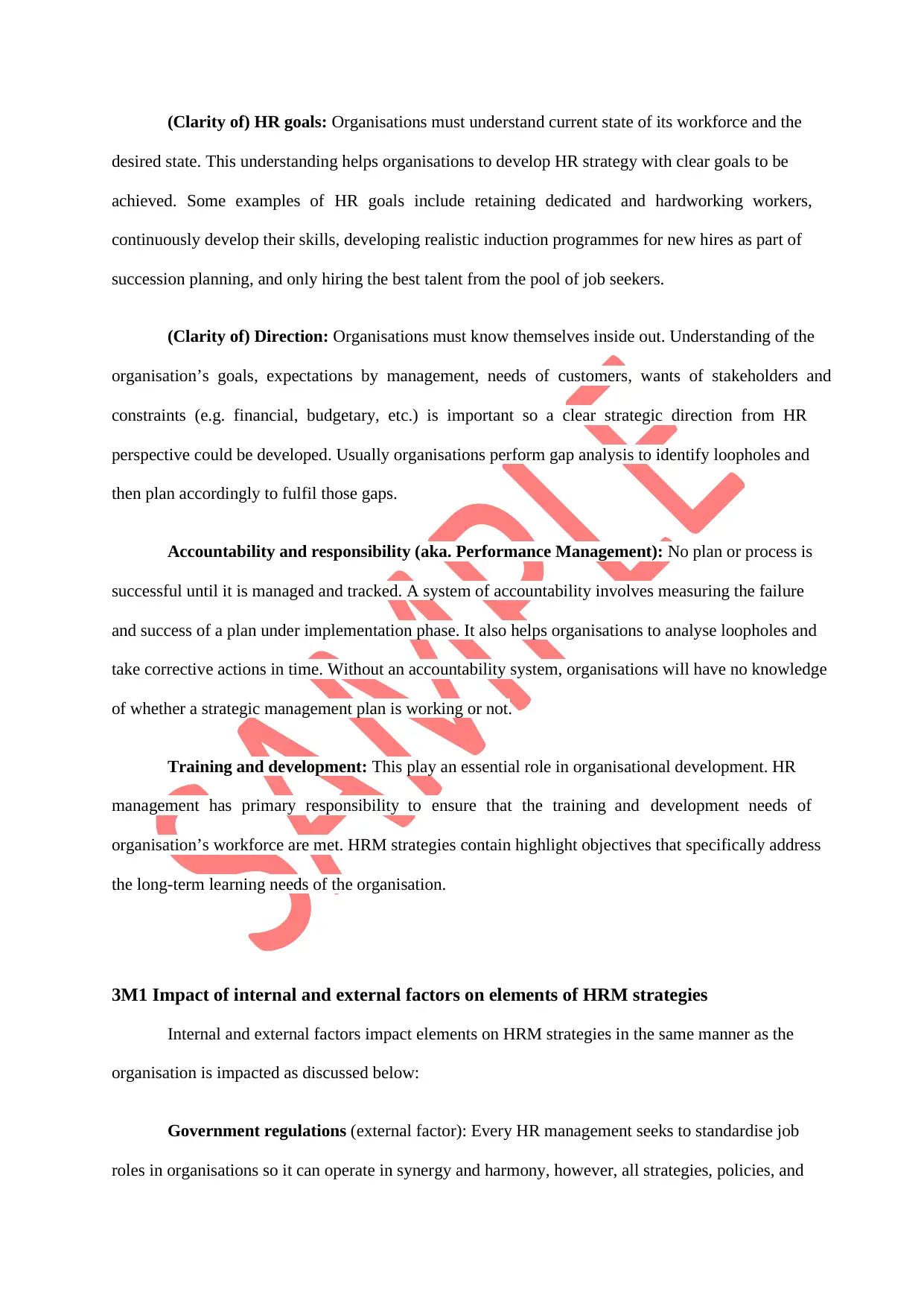
(Clarity of) HR goals: Organisations must understand current state of its workforce and the
desired state. This understanding helps organisations to develop HR strategy with clear goals to be
achieved. Some examples of HR goals include retaining dedicated and hardworking workers,
continuously develop their skills, developing realistic induction programmes for new hires as part of
succession planning, and only hiring the best talent from the pool of job seekers.
(Clarity of) Direction: Organisations must know themselves inside out. Understanding of the
organisation’s goals, expectations by management, needs of customers, wants of stakeholders and
constraints (e.g. financial, budgetary, etc.) is important so a clear strategic direction from HR
perspective could be developed. Usually organisations perform gap analysis to identify loopholes and
then plan accordingly to fulfil those gaps.
Accountability and responsibility (aka. Performance Management): No plan or process is
successful until it is managed and tracked. A system of accountability involves measuring the failure
and success of a plan under implementation phase. It also helps organisations to analyse loopholes and
take corrective actions in time. Without an accountability system, organisations will have no knowledge
of whether a strategic management plan is working or not.
Training and development: This play an essential role in organisational development. HR
management has primary responsibility to ensure that the training and development needs of
organisation’s workforce are met. HRM strategies contain highlight objectives that specifically address
the long-term learning needs of the organisation.
3M1 Impact of internal and external factors on elements of HRM strategies
Internal and external factors impact elements on HRM strategies in the same manner as the
organisation is impacted as discussed below:
Government regulations (external factor): Every HR management seeks to standardise job
roles in organisations so it can operate in synergy and harmony, however, all strategies, policies, and
desired state. This understanding helps organisations to develop HR strategy with clear goals to be
achieved. Some examples of HR goals include retaining dedicated and hardworking workers,
continuously develop their skills, developing realistic induction programmes for new hires as part of
succession planning, and only hiring the best talent from the pool of job seekers.
(Clarity of) Direction: Organisations must know themselves inside out. Understanding of the
organisation’s goals, expectations by management, needs of customers, wants of stakeholders and
constraints (e.g. financial, budgetary, etc.) is important so a clear strategic direction from HR
perspective could be developed. Usually organisations perform gap analysis to identify loopholes and
then plan accordingly to fulfil those gaps.
Accountability and responsibility (aka. Performance Management): No plan or process is
successful until it is managed and tracked. A system of accountability involves measuring the failure
and success of a plan under implementation phase. It also helps organisations to analyse loopholes and
take corrective actions in time. Without an accountability system, organisations will have no knowledge
of whether a strategic management plan is working or not.
Training and development: This play an essential role in organisational development. HR
management has primary responsibility to ensure that the training and development needs of
organisation’s workforce are met. HRM strategies contain highlight objectives that specifically address
the long-term learning needs of the organisation.
3M1 Impact of internal and external factors on elements of HRM strategies
Internal and external factors impact elements on HRM strategies in the same manner as the
organisation is impacted as discussed below:
Government regulations (external factor): Every HR management seeks to standardise job
roles in organisations so it can operate in synergy and harmony, however, all strategies, policies, and
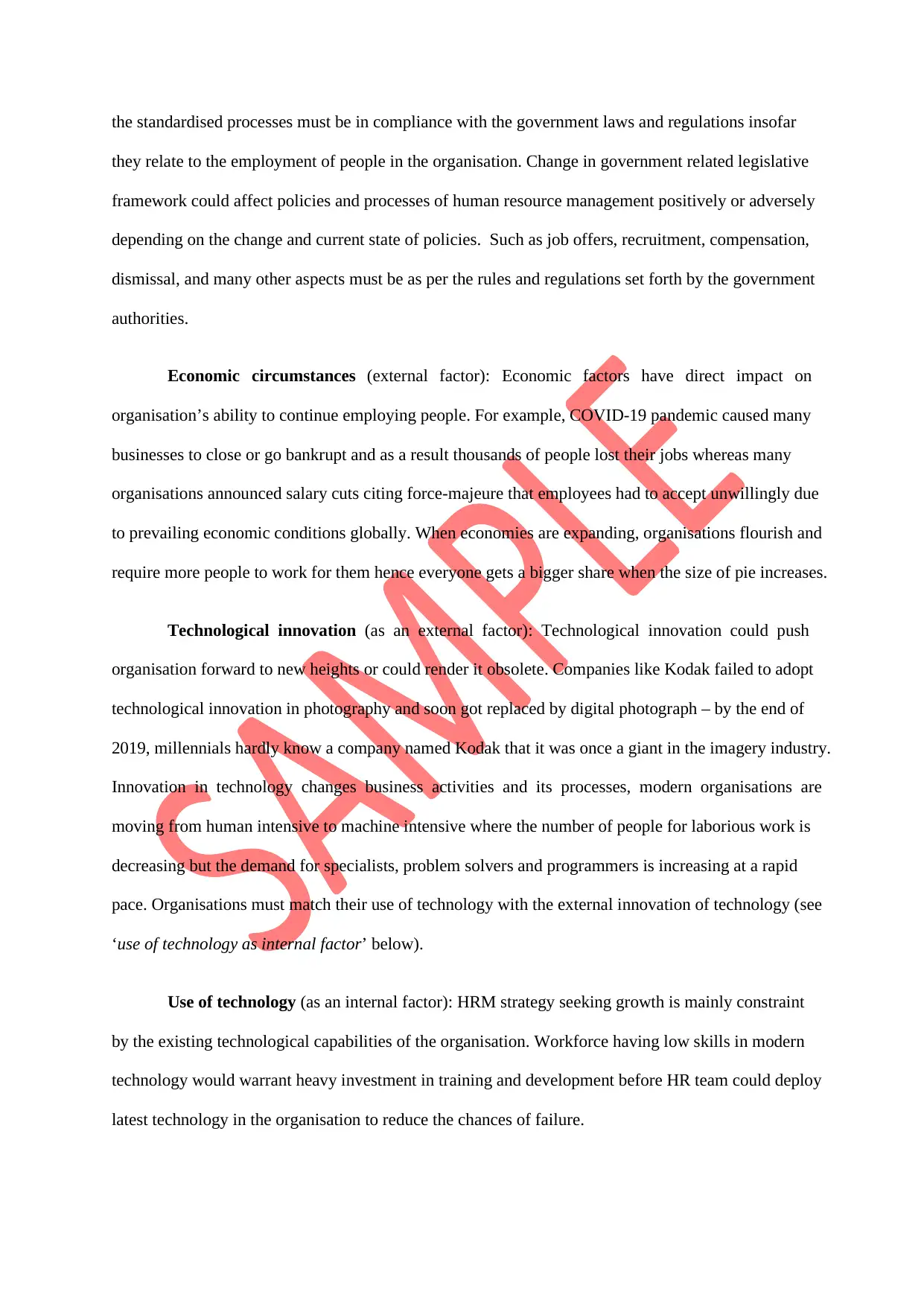
the standardised processes must be in compliance with the government laws and regulations insofar
they relate to the employment of people in the organisation. Change in government related legislative
framework could affect policies and processes of human resource management positively or adversely
depending on the change and current state of policies. Such as job offers, recruitment, compensation,
dismissal, and many other aspects must be as per the rules and regulations set forth by the government
authorities.
Economic circumstances (external factor): Economic factors have direct impact on
organisation’s ability to continue employing people. For example, COVID-19 pandemic caused many
businesses to close or go bankrupt and as a result thousands of people lost their jobs whereas many
organisations announced salary cuts citing force-majeure that employees had to accept unwillingly due
to prevailing economic conditions globally. When economies are expanding, organisations flourish and
require more people to work for them hence everyone gets a bigger share when the size of pie increases.
Technological innovation (as an external factor): Technological innovation could push
organisation forward to new heights or could render it obsolete. Companies like Kodak failed to adopt
technological innovation in photography and soon got replaced by digital photograph – by the end of
2019, millennials hardly know a company named Kodak that it was once a giant in the imagery industry.
Innovation in technology changes business activities and its processes, modern organisations are
moving from human intensive to machine intensive where the number of people for laborious work is
decreasing but the demand for specialists, problem solvers and programmers is increasing at a rapid
pace. Organisations must match their use of technology with the external innovation of technology (see
‘use of technology as internal factor’ below).
Use of technology (as an internal factor): HRM strategy seeking growth is mainly constraint
by the existing technological capabilities of the organisation. Workforce having low skills in modern
technology would warrant heavy investment in training and development before HR team could deploy
latest technology in the organisation to reduce the chances of failure.
they relate to the employment of people in the organisation. Change in government related legislative
framework could affect policies and processes of human resource management positively or adversely
depending on the change and current state of policies. Such as job offers, recruitment, compensation,
dismissal, and many other aspects must be as per the rules and regulations set forth by the government
authorities.
Economic circumstances (external factor): Economic factors have direct impact on
organisation’s ability to continue employing people. For example, COVID-19 pandemic caused many
businesses to close or go bankrupt and as a result thousands of people lost their jobs whereas many
organisations announced salary cuts citing force-majeure that employees had to accept unwillingly due
to prevailing economic conditions globally. When economies are expanding, organisations flourish and
require more people to work for them hence everyone gets a bigger share when the size of pie increases.
Technological innovation (as an external factor): Technological innovation could push
organisation forward to new heights or could render it obsolete. Companies like Kodak failed to adopt
technological innovation in photography and soon got replaced by digital photograph – by the end of
2019, millennials hardly know a company named Kodak that it was once a giant in the imagery industry.
Innovation in technology changes business activities and its processes, modern organisations are
moving from human intensive to machine intensive where the number of people for laborious work is
decreasing but the demand for specialists, problem solvers and programmers is increasing at a rapid
pace. Organisations must match their use of technology with the external innovation of technology (see
‘use of technology as internal factor’ below).
Use of technology (as an internal factor): HRM strategy seeking growth is mainly constraint
by the existing technological capabilities of the organisation. Workforce having low skills in modern
technology would warrant heavy investment in training and development before HR team could deploy
latest technology in the organisation to reduce the chances of failure.
Paraphrase This Document
Need a fresh take? Get an instant paraphrase of this document with our AI Paraphraser
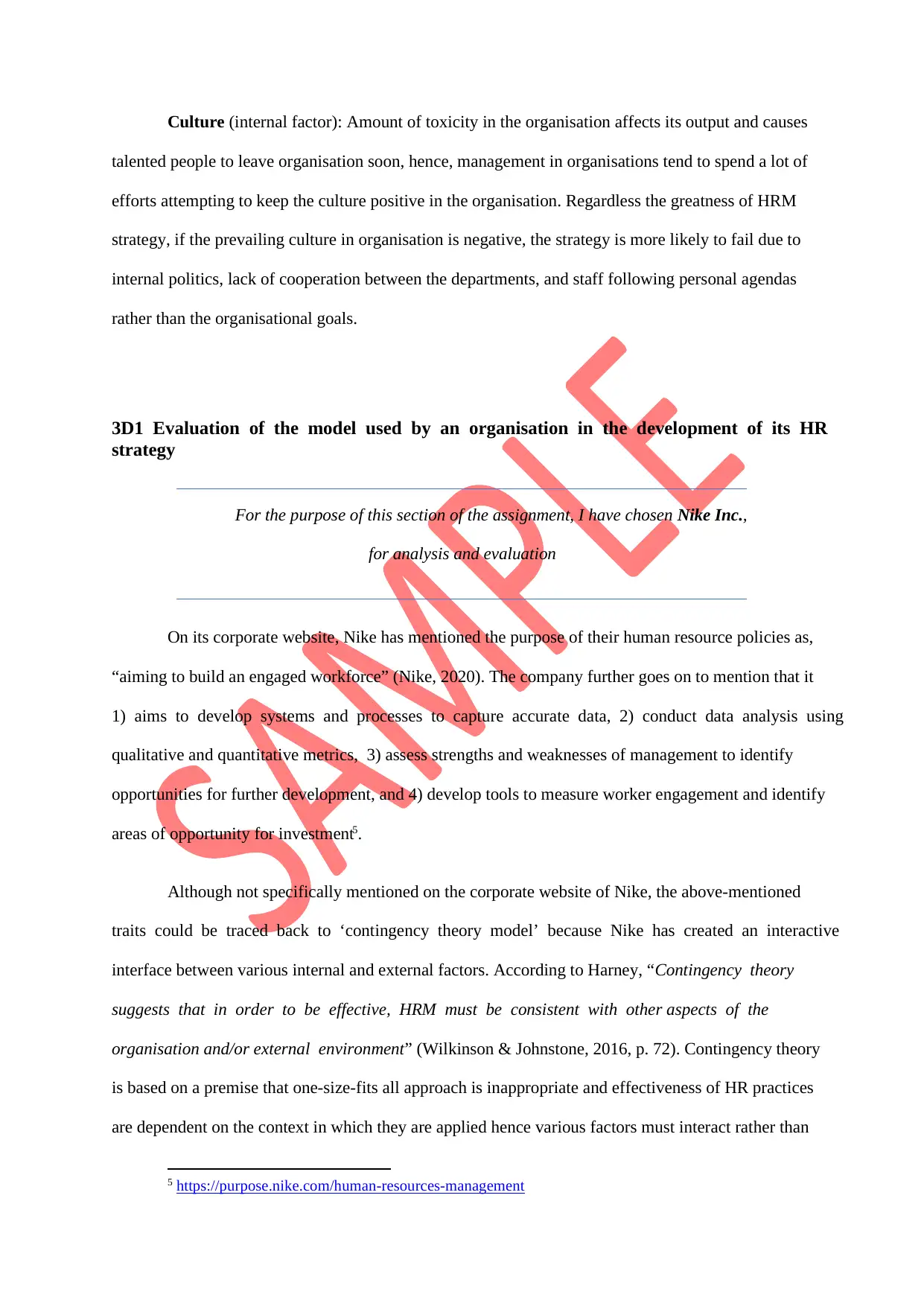
Culture (internal factor): Amount of toxicity in the organisation affects its output and causes
talented people to leave organisation soon, hence, management in organisations tend to spend a lot of
efforts attempting to keep the culture positive in the organisation. Regardless the greatness of HRM
strategy, if the prevailing culture in organisation is negative, the strategy is more likely to fail due to
internal politics, lack of cooperation between the departments, and staff following personal agendas
rather than the organisational goals.
3D1 Evaluation of the model used by an organisation in the development of its HR
strategy
For the purpose of this section of the assignment, I have chosen Nike Inc.,
for analysis and evaluation
On its corporate website, Nike has mentioned the purpose of their human resource policies as,
“aiming to build an engaged workforce” (Nike, 2020). The company further goes on to mention that it
1) aims to develop systems and processes to capture accurate data, 2) conduct data analysis using
qualitative and quantitative metrics, 3) assess strengths and weaknesses of management to identify
opportunities for further development, and 4) develop tools to measure worker engagement and identify
areas of opportunity for investment5.
Although not specifically mentioned on the corporate website of Nike, the above-mentioned
traits could be traced back to ‘contingency theory model’ because Nike has created an interactive
interface between various internal and external factors. According to Harney, “Contingency theory
suggests that in order to be effective, HRM must be consistent with other aspects of the
organisation and/or external environment” (Wilkinson & Johnstone, 2016, p. 72). Contingency theory
is based on a premise that one-size-fits all approach is inappropriate and effectiveness of HR practices
are dependent on the context in which they are applied hence various factors must interact rather than
5 https://purpose.nike.com/human-resources-management
talented people to leave organisation soon, hence, management in organisations tend to spend a lot of
efforts attempting to keep the culture positive in the organisation. Regardless the greatness of HRM
strategy, if the prevailing culture in organisation is negative, the strategy is more likely to fail due to
internal politics, lack of cooperation between the departments, and staff following personal agendas
rather than the organisational goals.
3D1 Evaluation of the model used by an organisation in the development of its HR
strategy
For the purpose of this section of the assignment, I have chosen Nike Inc.,
for analysis and evaluation
On its corporate website, Nike has mentioned the purpose of their human resource policies as,
“aiming to build an engaged workforce” (Nike, 2020). The company further goes on to mention that it
1) aims to develop systems and processes to capture accurate data, 2) conduct data analysis using
qualitative and quantitative metrics, 3) assess strengths and weaknesses of management to identify
opportunities for further development, and 4) develop tools to measure worker engagement and identify
areas of opportunity for investment5.
Although not specifically mentioned on the corporate website of Nike, the above-mentioned
traits could be traced back to ‘contingency theory model’ because Nike has created an interactive
interface between various internal and external factors. According to Harney, “Contingency theory
suggests that in order to be effective, HRM must be consistent with other aspects of the
organisation and/or external environment” (Wilkinson & Johnstone, 2016, p. 72). Contingency theory
is based on a premise that one-size-fits all approach is inappropriate and effectiveness of HR practices
are dependent on the context in which they are applied hence various factors must interact rather than
5 https://purpose.nike.com/human-resources-management
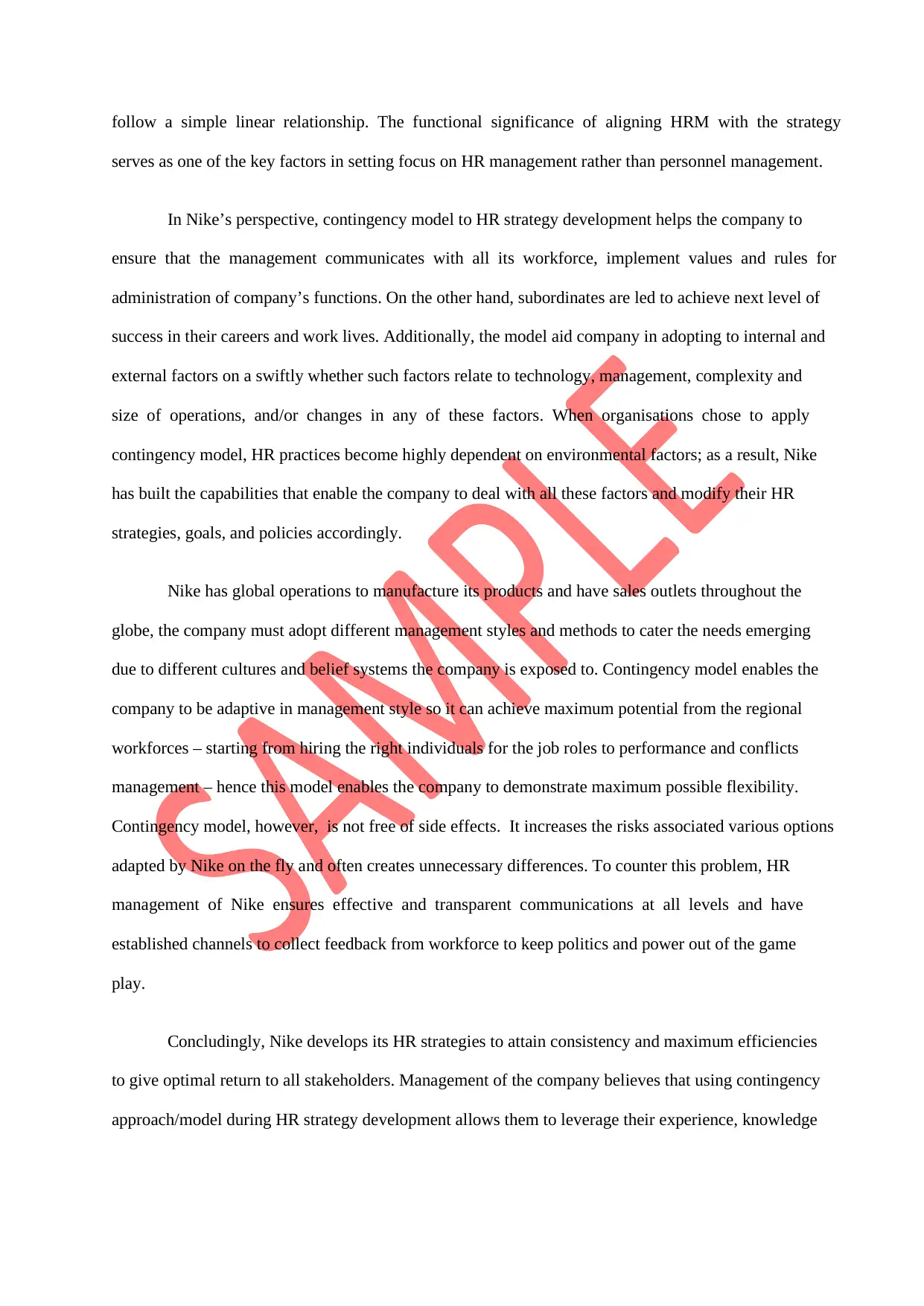
follow a simple linear relationship. The functional significance of aligning HRM with the strategy
serves as one of the key factors in setting focus on HR management rather than personnel management.
In Nike’s perspective, contingency model to HR strategy development helps the company to
ensure that the management communicates with all its workforce, implement values and rules for
administration of company’s functions. On the other hand, subordinates are led to achieve next level of
success in their careers and work lives. Additionally, the model aid company in adopting to internal and
external factors on a swiftly whether such factors relate to technology, management, complexity and
size of operations, and/or changes in any of these factors. When organisations chose to apply
contingency model, HR practices become highly dependent on environmental factors; as a result, Nike
has built the capabilities that enable the company to deal with all these factors and modify their HR
strategies, goals, and policies accordingly.
Nike has global operations to manufacture its products and have sales outlets throughout the
globe, the company must adopt different management styles and methods to cater the needs emerging
due to different cultures and belief systems the company is exposed to. Contingency model enables the
company to be adaptive in management style so it can achieve maximum potential from the regional
workforces – starting from hiring the right individuals for the job roles to performance and conflicts
management – hence this model enables the company to demonstrate maximum possible flexibility.
Contingency model, however, is not free of side effects. It increases the risks associated various options
adapted by Nike on the fly and often creates unnecessary differences. To counter this problem, HR
management of Nike ensures effective and transparent communications at all levels and have
established channels to collect feedback from workforce to keep politics and power out of the game
play.
Concludingly, Nike develops its HR strategies to attain consistency and maximum efficiencies
to give optimal return to all stakeholders. Management of the company believes that using contingency
approach/model during HR strategy development allows them to leverage their experience, knowledge
serves as one of the key factors in setting focus on HR management rather than personnel management.
In Nike’s perspective, contingency model to HR strategy development helps the company to
ensure that the management communicates with all its workforce, implement values and rules for
administration of company’s functions. On the other hand, subordinates are led to achieve next level of
success in their careers and work lives. Additionally, the model aid company in adopting to internal and
external factors on a swiftly whether such factors relate to technology, management, complexity and
size of operations, and/or changes in any of these factors. When organisations chose to apply
contingency model, HR practices become highly dependent on environmental factors; as a result, Nike
has built the capabilities that enable the company to deal with all these factors and modify their HR
strategies, goals, and policies accordingly.
Nike has global operations to manufacture its products and have sales outlets throughout the
globe, the company must adopt different management styles and methods to cater the needs emerging
due to different cultures and belief systems the company is exposed to. Contingency model enables the
company to be adaptive in management style so it can achieve maximum potential from the regional
workforces – starting from hiring the right individuals for the job roles to performance and conflicts
management – hence this model enables the company to demonstrate maximum possible flexibility.
Contingency model, however, is not free of side effects. It increases the risks associated various options
adapted by Nike on the fly and often creates unnecessary differences. To counter this problem, HR
management of Nike ensures effective and transparent communications at all levels and have
established channels to collect feedback from workforce to keep politics and power out of the game
play.
Concludingly, Nike develops its HR strategies to attain consistency and maximum efficiencies
to give optimal return to all stakeholders. Management of the company believes that using contingency
approach/model during HR strategy development allows them to leverage their experience, knowledge
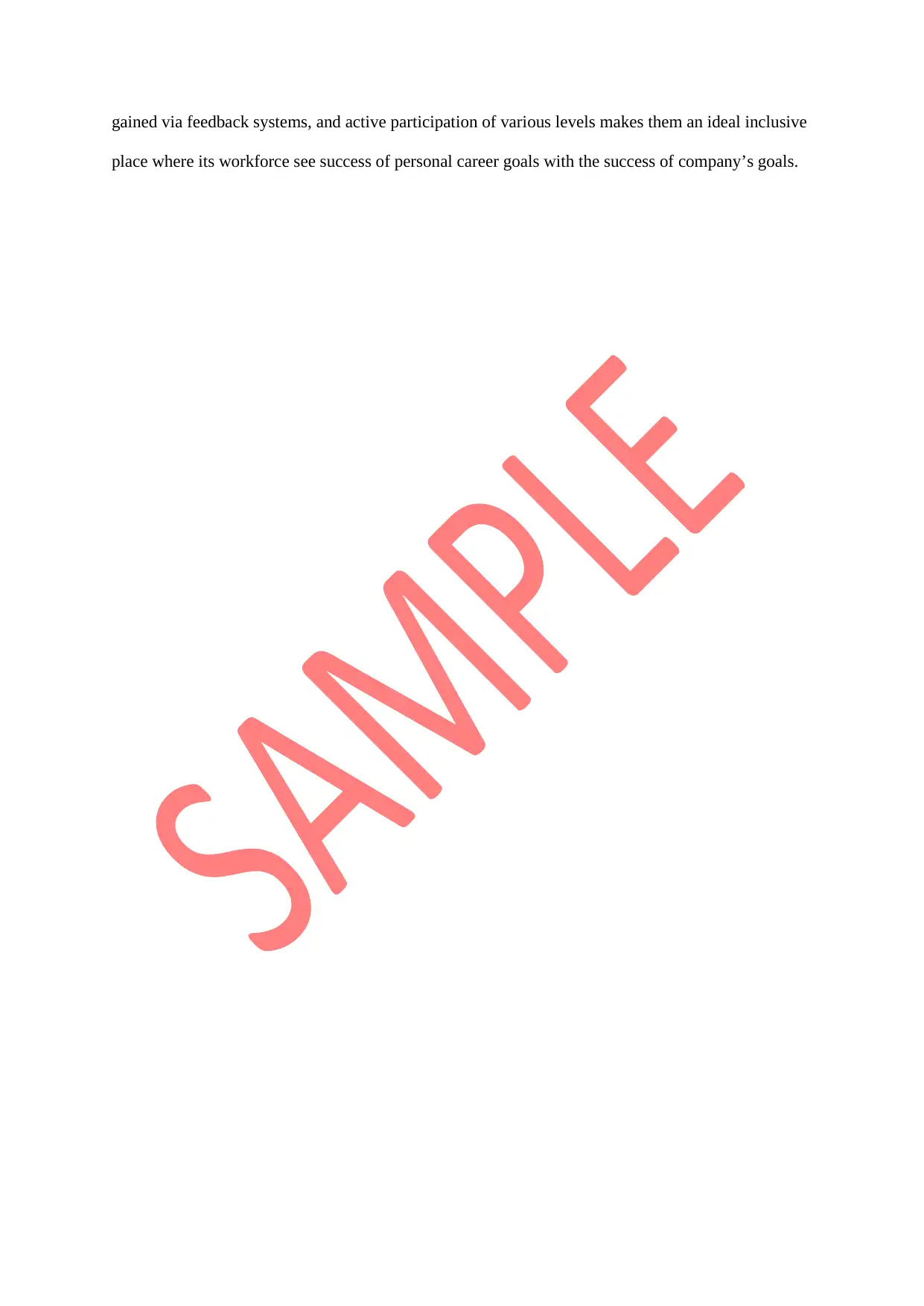
gained via feedback systems, and active participation of various levels makes them an ideal inclusive
place where its workforce see success of personal career goals with the success of company’s goals.
place where its workforce see success of personal career goals with the success of company’s goals.
Secure Best Marks with AI Grader
Need help grading? Try our AI Grader for instant feedback on your assignments.
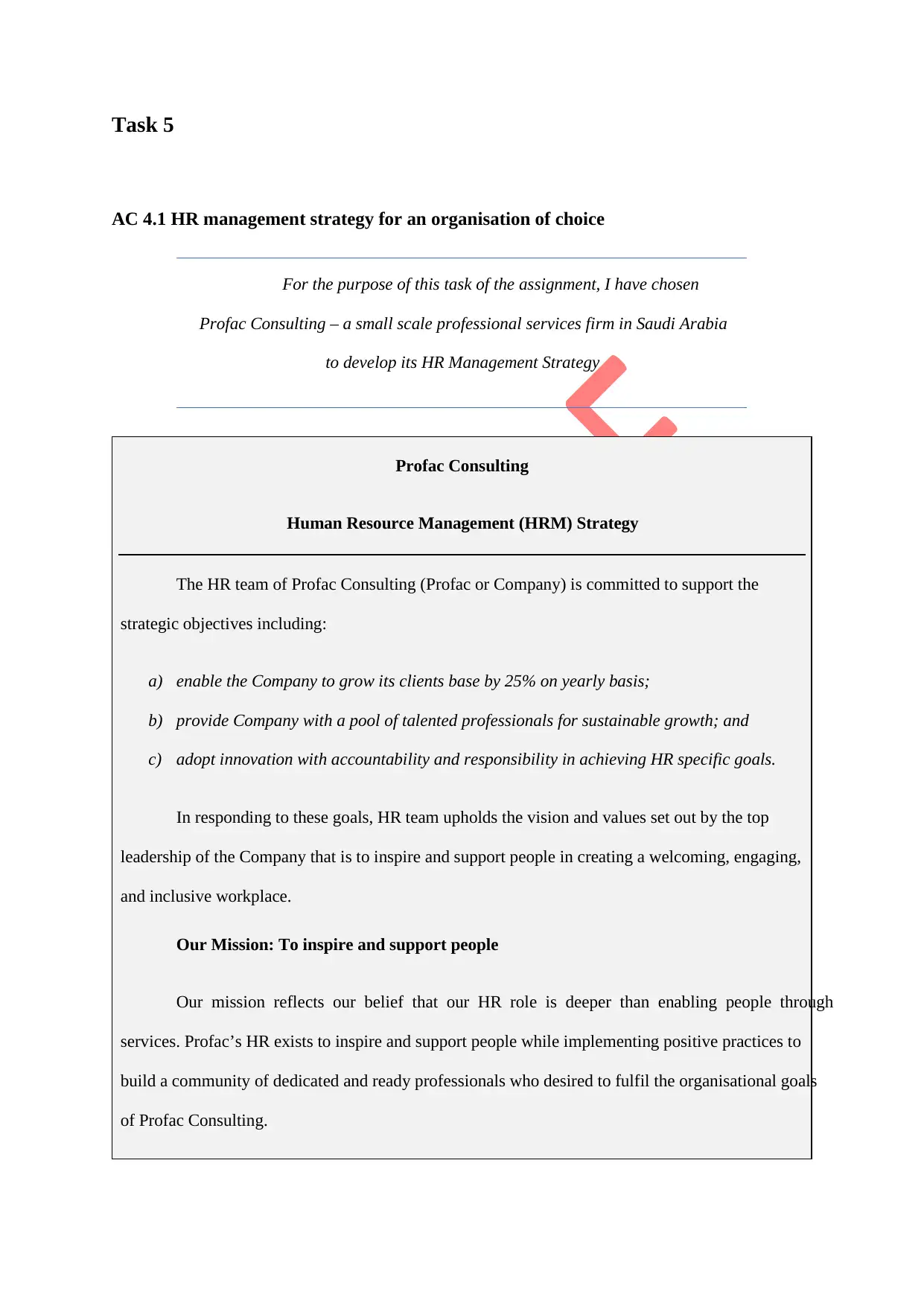
Task 5
AC 4.1 HR management strategy for an organisation of choice
For the purpose of this task of the assignment, I have chosen
Profac Consulting – a small scale professional services firm in Saudi Arabia
to develop its HR Management Strategy
Profac Consulting
Human Resource Management (HRM) Strategy
The HR team of Profac Consulting (Profac or Company) is committed to support the
strategic objectives including:
a) enable the Company to grow its clients base by 25% on yearly basis;
b) provide Company with a pool of talented professionals for sustainable growth; and
c) adopt innovation with accountability and responsibility in achieving HR specific goals.
In responding to these goals, HR team upholds the vision and values set out by the top
leadership of the Company that is to inspire and support people in creating a welcoming, engaging,
and inclusive workplace.
Our Mission: To inspire and support people
Our mission reflects our belief that our HR role is deeper than enabling people through
services. Profac’s HR exists to inspire and support people while implementing positive practices to
build a community of dedicated and ready professionals who desired to fulfil the organisational goals
of Profac Consulting.
AC 4.1 HR management strategy for an organisation of choice
For the purpose of this task of the assignment, I have chosen
Profac Consulting – a small scale professional services firm in Saudi Arabia
to develop its HR Management Strategy
Profac Consulting
Human Resource Management (HRM) Strategy
The HR team of Profac Consulting (Profac or Company) is committed to support the
strategic objectives including:
a) enable the Company to grow its clients base by 25% on yearly basis;
b) provide Company with a pool of talented professionals for sustainable growth; and
c) adopt innovation with accountability and responsibility in achieving HR specific goals.
In responding to these goals, HR team upholds the vision and values set out by the top
leadership of the Company that is to inspire and support people in creating a welcoming, engaging,
and inclusive workplace.
Our Mission: To inspire and support people
Our mission reflects our belief that our HR role is deeper than enabling people through
services. Profac’s HR exists to inspire and support people while implementing positive practices to
build a community of dedicated and ready professionals who desired to fulfil the organisational goals
of Profac Consulting.
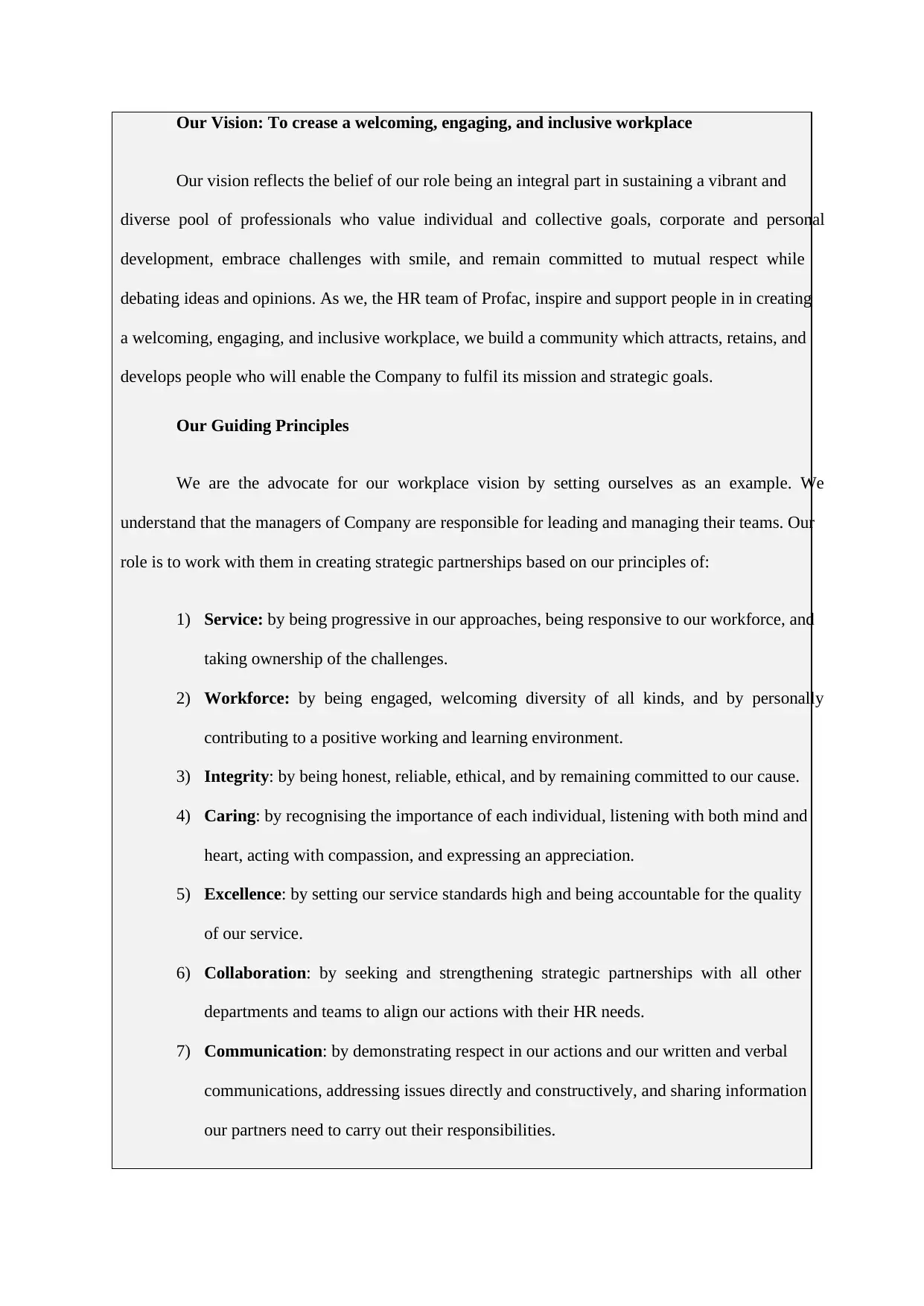
Our Vision: To crease a welcoming, engaging, and inclusive workplace
Our vision reflects the belief of our role being an integral part in sustaining a vibrant and
diverse pool of professionals who value individual and collective goals, corporate and personal
development, embrace challenges with smile, and remain committed to mutual respect while
debating ideas and opinions. As we, the HR team of Profac, inspire and support people in in creating
a welcoming, engaging, and inclusive workplace, we build a community which attracts, retains, and
develops people who will enable the Company to fulfil its mission and strategic goals.
Our Guiding Principles
We are the advocate for our workplace vision by setting ourselves as an example. We
understand that the managers of Company are responsible for leading and managing their teams. Our
role is to work with them in creating strategic partnerships based on our principles of:
1) Service: by being progressive in our approaches, being responsive to our workforce, and
taking ownership of the challenges.
2) Workforce: by being engaged, welcoming diversity of all kinds, and by personally
contributing to a positive working and learning environment.
3) Integrity: by being honest, reliable, ethical, and by remaining committed to our cause.
4) Caring: by recognising the importance of each individual, listening with both mind and
heart, acting with compassion, and expressing an appreciation.
5) Excellence: by setting our service standards high and being accountable for the quality
of our service.
6) Collaboration: by seeking and strengthening strategic partnerships with all other
departments and teams to align our actions with their HR needs.
7) Communication: by demonstrating respect in our actions and our written and verbal
communications, addressing issues directly and constructively, and sharing information
our partners need to carry out their responsibilities.
Our vision reflects the belief of our role being an integral part in sustaining a vibrant and
diverse pool of professionals who value individual and collective goals, corporate and personal
development, embrace challenges with smile, and remain committed to mutual respect while
debating ideas and opinions. As we, the HR team of Profac, inspire and support people in in creating
a welcoming, engaging, and inclusive workplace, we build a community which attracts, retains, and
develops people who will enable the Company to fulfil its mission and strategic goals.
Our Guiding Principles
We are the advocate for our workplace vision by setting ourselves as an example. We
understand that the managers of Company are responsible for leading and managing their teams. Our
role is to work with them in creating strategic partnerships based on our principles of:
1) Service: by being progressive in our approaches, being responsive to our workforce, and
taking ownership of the challenges.
2) Workforce: by being engaged, welcoming diversity of all kinds, and by personally
contributing to a positive working and learning environment.
3) Integrity: by being honest, reliable, ethical, and by remaining committed to our cause.
4) Caring: by recognising the importance of each individual, listening with both mind and
heart, acting with compassion, and expressing an appreciation.
5) Excellence: by setting our service standards high and being accountable for the quality
of our service.
6) Collaboration: by seeking and strengthening strategic partnerships with all other
departments and teams to align our actions with their HR needs.
7) Communication: by demonstrating respect in our actions and our written and verbal
communications, addressing issues directly and constructively, and sharing information
our partners need to carry out their responsibilities.
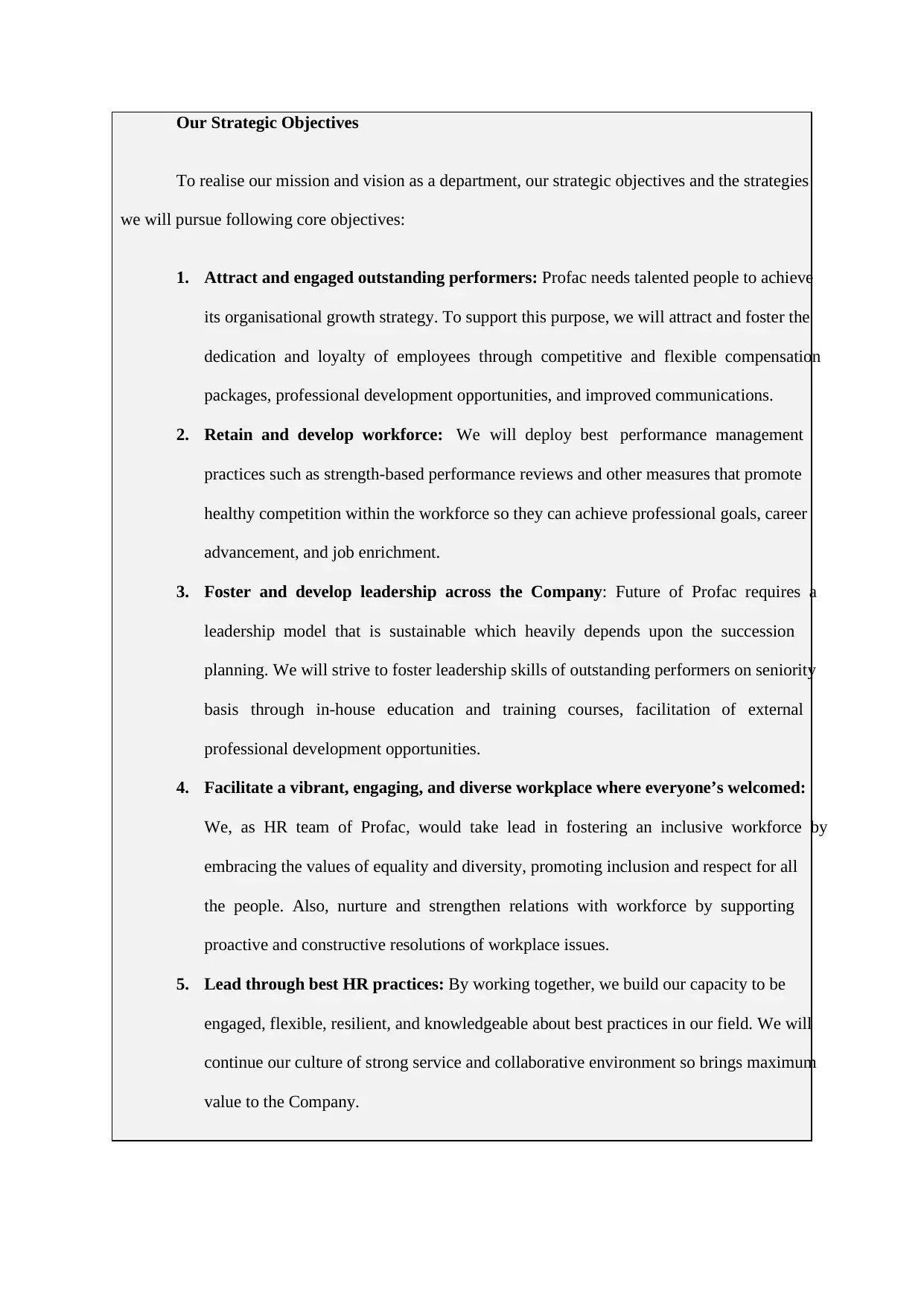
Our Strategic Objectives
To realise our mission and vision as a department, our strategic objectives and the strategies
we will pursue following core objectives:
1. Attract and engaged outstanding performers: Profac needs talented people to achieve
its organisational growth strategy. To support this purpose, we will attract and foster the
dedication and loyalty of employees through competitive and flexible compensation
packages, professional development opportunities, and improved communications.
2. Retain and develop workforce: We will deploy best performance management
practices such as strength-based performance reviews and other measures that promote
healthy competition within the workforce so they can achieve professional goals, career
advancement, and job enrichment.
3. Foster and develop leadership across the Company: Future of Profac requires a
leadership model that is sustainable which heavily depends upon the succession
planning. We will strive to foster leadership skills of outstanding performers on seniority
basis through in-house education and training courses, facilitation of external
professional development opportunities.
4. Facilitate a vibrant, engaging, and diverse workplace where everyone’s welcomed:
We, as HR team of Profac, would take lead in fostering an inclusive workforce by
embracing the values of equality and diversity, promoting inclusion and respect for all
the people. Also, nurture and strengthen relations with workforce by supporting
proactive and constructive resolutions of workplace issues.
5. Lead through best HR practices: By working together, we build our capacity to be
engaged, flexible, resilient, and knowledgeable about best practices in our field. We will
continue our culture of strong service and collaborative environment so brings maximum
value to the Company.
To realise our mission and vision as a department, our strategic objectives and the strategies
we will pursue following core objectives:
1. Attract and engaged outstanding performers: Profac needs talented people to achieve
its organisational growth strategy. To support this purpose, we will attract and foster the
dedication and loyalty of employees through competitive and flexible compensation
packages, professional development opportunities, and improved communications.
2. Retain and develop workforce: We will deploy best performance management
practices such as strength-based performance reviews and other measures that promote
healthy competition within the workforce so they can achieve professional goals, career
advancement, and job enrichment.
3. Foster and develop leadership across the Company: Future of Profac requires a
leadership model that is sustainable which heavily depends upon the succession
planning. We will strive to foster leadership skills of outstanding performers on seniority
basis through in-house education and training courses, facilitation of external
professional development opportunities.
4. Facilitate a vibrant, engaging, and diverse workplace where everyone’s welcomed:
We, as HR team of Profac, would take lead in fostering an inclusive workforce by
embracing the values of equality and diversity, promoting inclusion and respect for all
the people. Also, nurture and strengthen relations with workforce by supporting
proactive and constructive resolutions of workplace issues.
5. Lead through best HR practices: By working together, we build our capacity to be
engaged, flexible, resilient, and knowledgeable about best practices in our field. We will
continue our culture of strong service and collaborative environment so brings maximum
value to the Company.
Paraphrase This Document
Need a fresh take? Get an instant paraphrase of this document with our AI Paraphraser
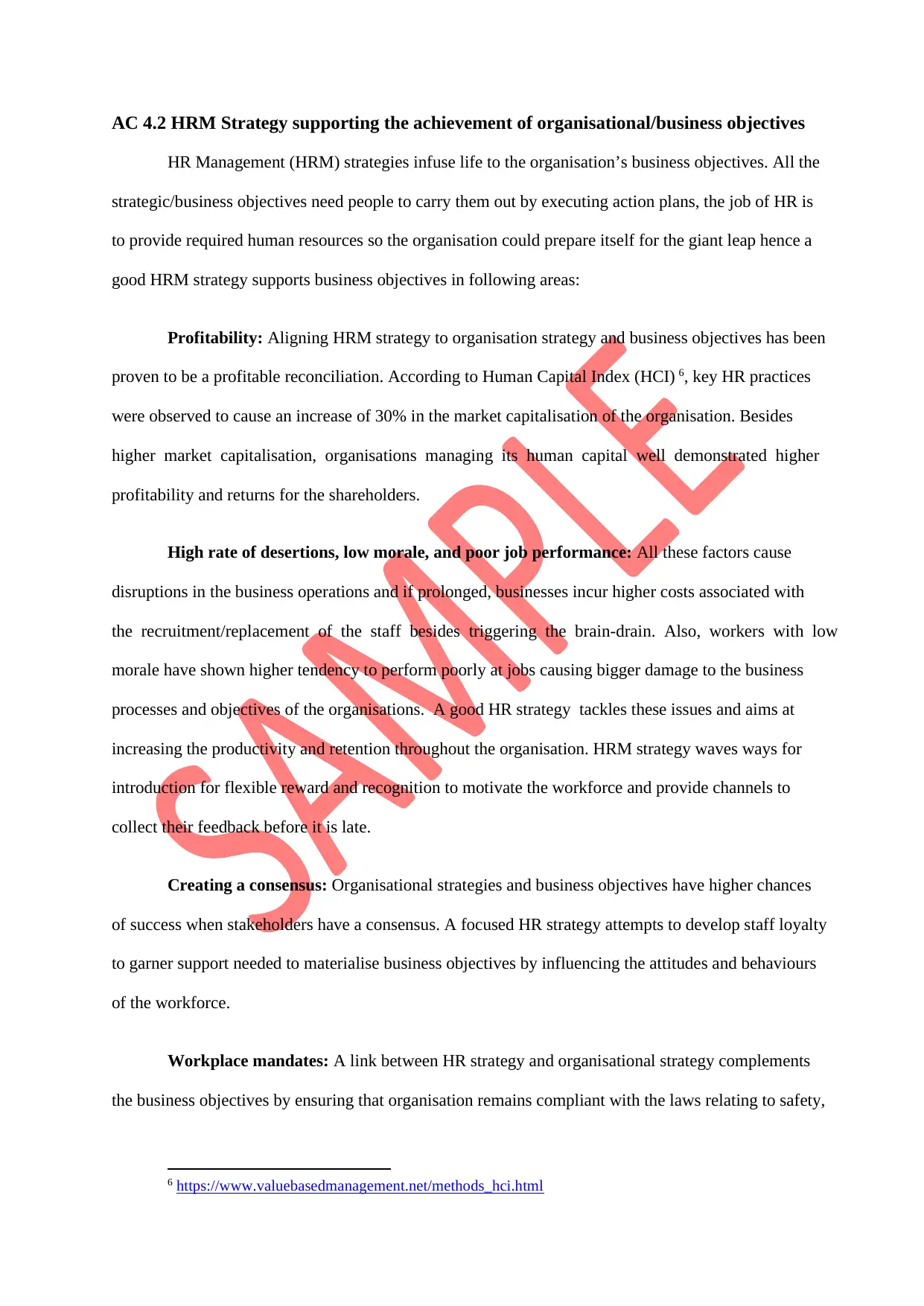
AC 4.2 HRM Strategy supporting the achievement of organisational/business objectives
HR Management (HRM) strategies infuse life to the organisation’s business objectives. All the
strategic/business objectives need people to carry them out by executing action plans, the job of HR is
to provide required human resources so the organisation could prepare itself for the giant leap hence a
good HRM strategy supports business objectives in following areas:
Profitability: Aligning HRM strategy to organisation strategy and business objectives has been
proven to be a profitable reconciliation. According to Human Capital Index (HCI) 6, key HR practices
were observed to cause an increase of 30% in the market capitalisation of the organisation. Besides
higher market capitalisation, organisations managing its human capital well demonstrated higher
profitability and returns for the shareholders.
High rate of desertions, low morale, and poor job performance: All these factors cause
disruptions in the business operations and if prolonged, businesses incur higher costs associated with
the recruitment/replacement of the staff besides triggering the brain-drain. Also, workers with low
morale have shown higher tendency to perform poorly at jobs causing bigger damage to the business
processes and objectives of the organisations. A good HR strategy tackles these issues and aims at
increasing the productivity and retention throughout the organisation. HRM strategy waves ways for
introduction for flexible reward and recognition to motivate the workforce and provide channels to
collect their feedback before it is late.
Creating a consensus: Organisational strategies and business objectives have higher chances
of success when stakeholders have a consensus. A focused HR strategy attempts to develop staff loyalty
to garner support needed to materialise business objectives by influencing the attitudes and behaviours
of the workforce.
Workplace mandates: A link between HR strategy and organisational strategy complements
the business objectives by ensuring that organisation remains compliant with the laws relating to safety,
6 https://www.valuebasedmanagement.net/methods_hci.html
HR Management (HRM) strategies infuse life to the organisation’s business objectives. All the
strategic/business objectives need people to carry them out by executing action plans, the job of HR is
to provide required human resources so the organisation could prepare itself for the giant leap hence a
good HRM strategy supports business objectives in following areas:
Profitability: Aligning HRM strategy to organisation strategy and business objectives has been
proven to be a profitable reconciliation. According to Human Capital Index (HCI) 6, key HR practices
were observed to cause an increase of 30% in the market capitalisation of the organisation. Besides
higher market capitalisation, organisations managing its human capital well demonstrated higher
profitability and returns for the shareholders.
High rate of desertions, low morale, and poor job performance: All these factors cause
disruptions in the business operations and if prolonged, businesses incur higher costs associated with
the recruitment/replacement of the staff besides triggering the brain-drain. Also, workers with low
morale have shown higher tendency to perform poorly at jobs causing bigger damage to the business
processes and objectives of the organisations. A good HR strategy tackles these issues and aims at
increasing the productivity and retention throughout the organisation. HRM strategy waves ways for
introduction for flexible reward and recognition to motivate the workforce and provide channels to
collect their feedback before it is late.
Creating a consensus: Organisational strategies and business objectives have higher chances
of success when stakeholders have a consensus. A focused HR strategy attempts to develop staff loyalty
to garner support needed to materialise business objectives by influencing the attitudes and behaviours
of the workforce.
Workplace mandates: A link between HR strategy and organisational strategy complements
the business objectives by ensuring that organisation remains compliant with the laws relating to safety,
6 https://www.valuebasedmanagement.net/methods_hci.html
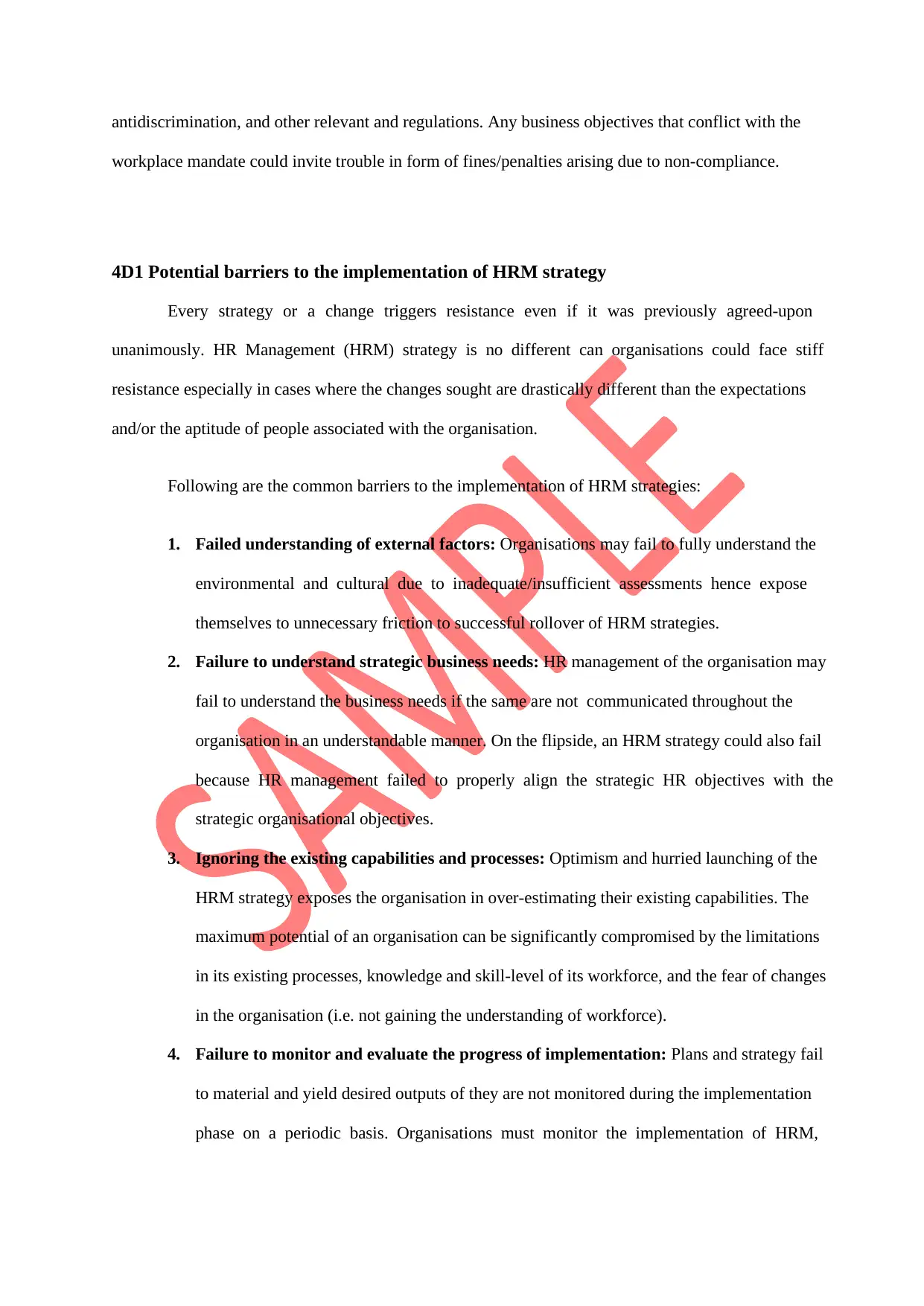
antidiscrimination, and other relevant and regulations. Any business objectives that conflict with the
workplace mandate could invite trouble in form of fines/penalties arising due to non-compliance.
4D1 Potential barriers to the implementation of HRM strategy
Every strategy or a change triggers resistance even if it was previously agreed-upon
unanimously. HR Management (HRM) strategy is no different can organisations could face stiff
resistance especially in cases where the changes sought are drastically different than the expectations
and/or the aptitude of people associated with the organisation.
Following are the common barriers to the implementation of HRM strategies:
1. Failed understanding of external factors: Organisations may fail to fully understand the
environmental and cultural due to inadequate/insufficient assessments hence expose
themselves to unnecessary friction to successful rollover of HRM strategies.
2. Failure to understand strategic business needs: HR management of the organisation may
fail to understand the business needs if the same are not communicated throughout the
organisation in an understandable manner. On the flipside, an HRM strategy could also fail
because HR management failed to properly align the strategic HR objectives with the
strategic organisational objectives.
3. Ignoring the existing capabilities and processes: Optimism and hurried launching of the
HRM strategy exposes the organisation in over-estimating their existing capabilities. The
maximum potential of an organisation can be significantly compromised by the limitations
in its existing processes, knowledge and skill-level of its workforce, and the fear of changes
in the organisation (i.e. not gaining the understanding of workforce).
4. Failure to monitor and evaluate the progress of implementation: Plans and strategy fail
to material and yield desired outputs of they are not monitored during the implementation
phase on a periodic basis. Organisations must monitor the implementation of HRM,
workplace mandate could invite trouble in form of fines/penalties arising due to non-compliance.
4D1 Potential barriers to the implementation of HRM strategy
Every strategy or a change triggers resistance even if it was previously agreed-upon
unanimously. HR Management (HRM) strategy is no different can organisations could face stiff
resistance especially in cases where the changes sought are drastically different than the expectations
and/or the aptitude of people associated with the organisation.
Following are the common barriers to the implementation of HRM strategies:
1. Failed understanding of external factors: Organisations may fail to fully understand the
environmental and cultural due to inadequate/insufficient assessments hence expose
themselves to unnecessary friction to successful rollover of HRM strategies.
2. Failure to understand strategic business needs: HR management of the organisation may
fail to understand the business needs if the same are not communicated throughout the
organisation in an understandable manner. On the flipside, an HRM strategy could also fail
because HR management failed to properly align the strategic HR objectives with the
strategic organisational objectives.
3. Ignoring the existing capabilities and processes: Optimism and hurried launching of the
HRM strategy exposes the organisation in over-estimating their existing capabilities. The
maximum potential of an organisation can be significantly compromised by the limitations
in its existing processes, knowledge and skill-level of its workforce, and the fear of changes
in the organisation (i.e. not gaining the understanding of workforce).
4. Failure to monitor and evaluate the progress of implementation: Plans and strategy fail
to material and yield desired outputs of they are not monitored during the implementation
phase on a periodic basis. Organisations must monitor the implementation of HRM,
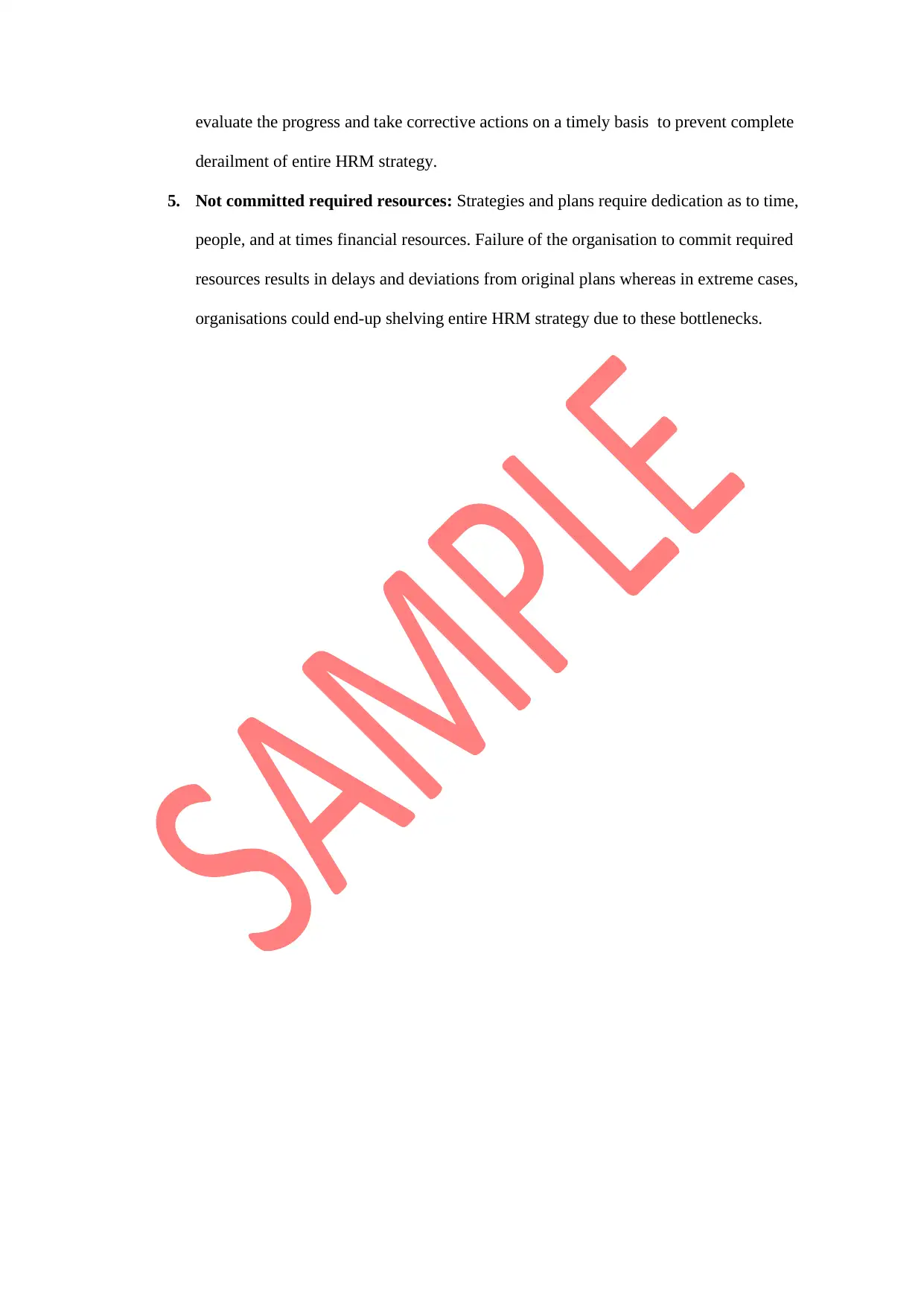
evaluate the progress and take corrective actions on a timely basis to prevent complete
derailment of entire HRM strategy.
5. Not committed required resources: Strategies and plans require dedication as to time,
people, and at times financial resources. Failure of the organisation to commit required
resources results in delays and deviations from original plans whereas in extreme cases,
organisations could end-up shelving entire HRM strategy due to these bottlenecks.
derailment of entire HRM strategy.
5. Not committed required resources: Strategies and plans require dedication as to time,
people, and at times financial resources. Failure of the organisation to commit required
resources results in delays and deviations from original plans whereas in extreme cases,
organisations could end-up shelving entire HRM strategy due to these bottlenecks.
Secure Best Marks with AI Grader
Need help grading? Try our AI Grader for instant feedback on your assignments.
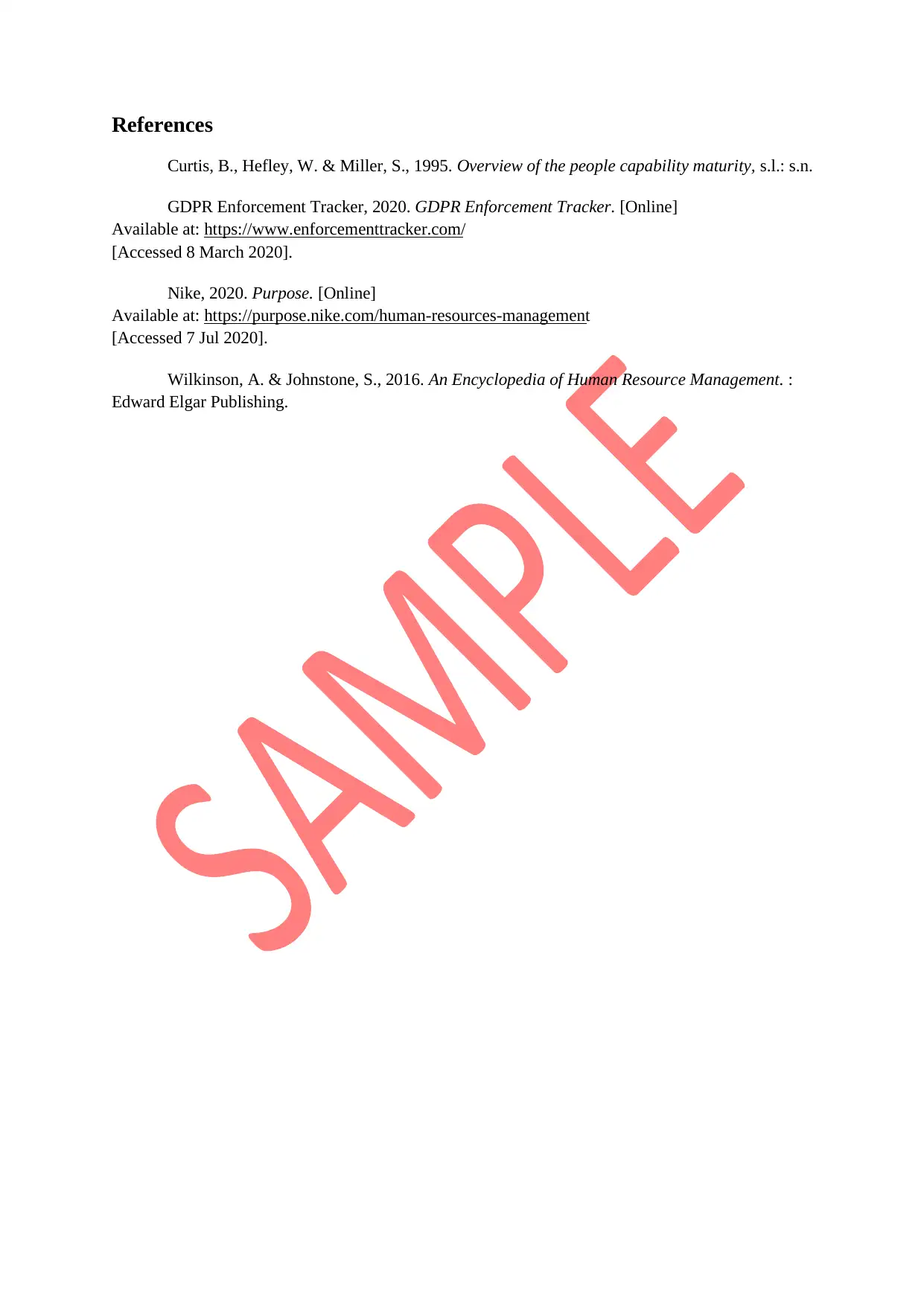
References
Curtis, B., Hefley, W. & Miller, S., 1995. Overview of the people capability maturity, s.l.: s.n.
GDPR Enforcement Tracker, 2020. GDPR Enforcement Tracker. [Online]
Available at: https://www.enforcementtracker.com/
[Accessed 8 March 2020].
Nike, 2020. Purpose. [Online]
Available at: https://purpose.nike.com/human-resources-management
[Accessed 7 Jul 2020].
Wilkinson, A. & Johnstone, S., 2016. An Encyclopedia of Human Resource Management. :
Edward Elgar Publishing.
Curtis, B., Hefley, W. & Miller, S., 1995. Overview of the people capability maturity, s.l.: s.n.
GDPR Enforcement Tracker, 2020. GDPR Enforcement Tracker. [Online]
Available at: https://www.enforcementtracker.com/
[Accessed 8 March 2020].
Nike, 2020. Purpose. [Online]
Available at: https://purpose.nike.com/human-resources-management
[Accessed 7 Jul 2020].
Wilkinson, A. & Johnstone, S., 2016. An Encyclopedia of Human Resource Management. :
Edward Elgar Publishing.
1 out of 35
Related Documents
Your All-in-One AI-Powered Toolkit for Academic Success.
+13062052269
info@desklib.com
Available 24*7 on WhatsApp / Email
![[object Object]](/_next/static/media/star-bottom.7253800d.svg)
Unlock your academic potential
© 2024 | Zucol Services PVT LTD | All rights reserved.



